Eveprest
Custom modules and extensions
Some of modules are implemented only in particular themes of Eveprest family.
Smart Blog
Smart blog - a set of modules that allows creating blog in your store. It consists of the following modules:
- Smart Blog
- RSS Smart Blog Feed
- Smart Blog Archive
- Smart Blog Categories
- Smart Blog Home Latest
- Smart Blog Latest Comments
- Smart Blog AddThisModule
- Smart Blog Popular Posts
- Smart Blog Recent Posts
- Smart Blog Related Post
- Smart Blog Search
- Smart Blog Tags
It also has its hooks where the blog modules can appear on the site, they can also show up in the standard hooks (only columns).
Smart Blog
This is the main module that contains many settings for blog functionality. After its installation the Blog menu tab will show up in the main menu of your admin panel where you can add/remove/edit the posts/categories or select the type of images and their dimensions used in the posts (types and dimensions of post images are different from product images settings in your store). To add the frontend settings of the module, please navigate to Smart Blog (Modules -> Front Office Features -> Smart Blog) and add all the parameters.
Description of parameters:
-
- Meta Title
- the title of your blog that will show up on all its pages.
-
- Meta Keyword
- keywords that will be used by search engines for better SEO optimization.
-
- Meta Description
- description of your blog used by search engines for better SEO optimization.
-
- Main Blog Url
- the URL of your Blog.
-
- Use .html with Friendly Url
- enable/disable adding .html to the blog pages URLs using Friendly Urls.
-
- Number of posts per page
- number of posts that show up per page (category/archives pages, etc.).
-
- Auto accepted comment
- enable/disable the auto accepted user comments; if enabled, comments will be available without admin moderation.
-
- Enable Captcha
- enable/disable Captcha under Leave Comment form on products pages.
-
- Enable Comment
- enable/disable leaving comments by users.
-
- Show Author Name
- enable/disable showing posts author on the blog pages and post single pages
-
- Show Post Viewed
- enable/disable showing number of times the users viewed the post. It will show up under the post on the blog pages and blog single pages.
-
- Show Author Name Style
- changing the format of the author name.
-
- AVATAR Image
- adding the standard avatar image for all users.
-
- Show No Image
- enable/disable the image. No Image is set if there is no image for post/category, etc.
-
- Show Category
- enable/disable the category image and description on the blog category pages.
-
- Blog Page Column Setting
- setting the display of Blog related modules. It often requires additional settings, therefore it is recommended that you install additional modules the same way the standard PrestaShop modules are installed.
-
- Custom CSS
- you can add additional styles in this field. Be careful using the classes that are already used in the theme, since some conflicts may occur.
-
- Delete Old Thumblr
- is used to regenerate blog images in case image dimensions were changed or the new type of image was added. To regenerate, select 'Yes' and click 'Regenerate'.
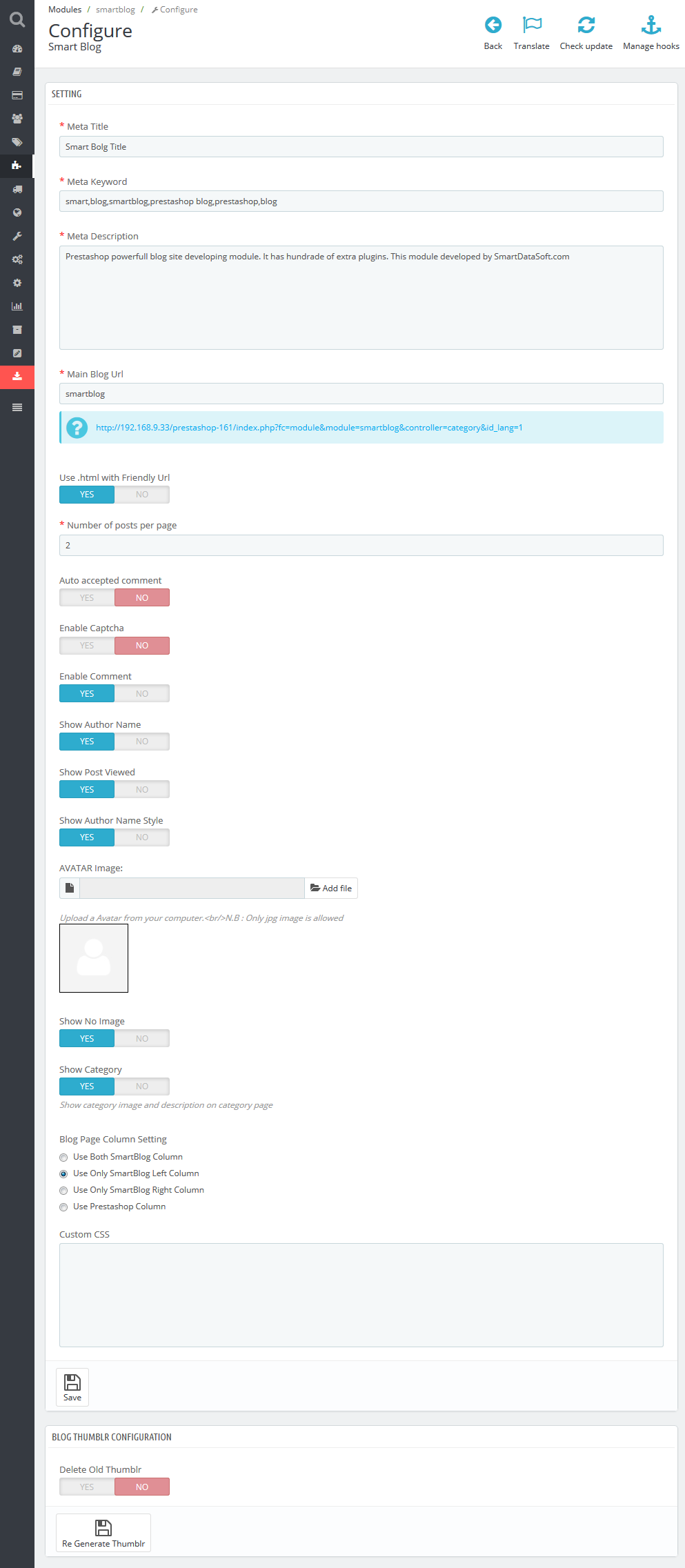
ONLY AFTER THIS other blog related modules can be installed. The process of removal is opposite: FIRST, YOU SHOULD DELETE ALL RELATED MODULES and only then delete Smart Blog module.
RSS Smart Blog Feed
The module generating the new feed for your Blog.
Has several settings in the admin panel:
-
- Update Period
- allows to display posts from specific time period (hour/day/week/month/year).
-
- Update Frequency
- allows to set the frequency of update (1 week, 2 hours, etc.).
At the top there is a file path where news will be generated. It consists of the website URL + /modules/smartblogfeed/rss.php.

Smart Blog Archive
This block shows up in the left/right column and is used to sort posts by period of time (month).
It does not have any additional settings.
Smart Blog Categories
This block shows up in the left/right column and is used to sort posts by category.
It does not have any additional settings.
Smart Blog Home Latest Posts
This block shows up only in homepagecontent hook and is used to display latest posts on the home page.
Settings:
-
- Number of posts to display in Latest News
- number of posts that will show up on home page.

Smart Blog Latest Comments
This block shows up in the left/right column and is used to display the latest comments added for the Blog posts.
Settings:
-
- Number of Comments to Show
- number of comments shown in the block.

Smart Blog AddThis Module
This block shows up on the post single page and allows to share this post in social networks.
It does not have any additional settings.
Smart Blog Popular Posts
This block shows up in the left/right column and is used to display the most popular posts viewed.
Settings:
-
- Number of popular Posts to Show
- number of popular posts shown in the block.

Smart Blog Recent Posts
This block shows up in the left/right column and is used to display the latest posts.
Settings:
-
- Show Number Of Recent Posts
- number of recent posts shown in the block.

Smart Blog Related Posts
This block shows up on the post single page and is used to show up related posts.
Settings:
-
- Show Number Of Related Posts
- number of related posts shown in the block.

Smart Blog Search
This block shows up in the left/right column and is used to search through the blog.
It does not have any additional settings.
Smart Blog Tag
This block shows up in the left/right column and is used to display tags used in the blog.
Settings:
-
- Number of Tag to Show
- number of tags shown in the block.

TM 360 View
Available in:
One Product
The module displays images in a 3D effect and enables users to rotate them in 360 degrees. The rotation can start automatically on page load, or the client can rotate the 'image' manually, dragging the left mouse button.
Moreover the module can be used for adding panorama view (or several panorama views) to the homepage.
360 view mode is also available on product page.
Installation
Navigate to Modules and Settings -> Modules and Settings (1) in your admin panel and find the TM 360 view module (2). Then click the 'Install' button (3).
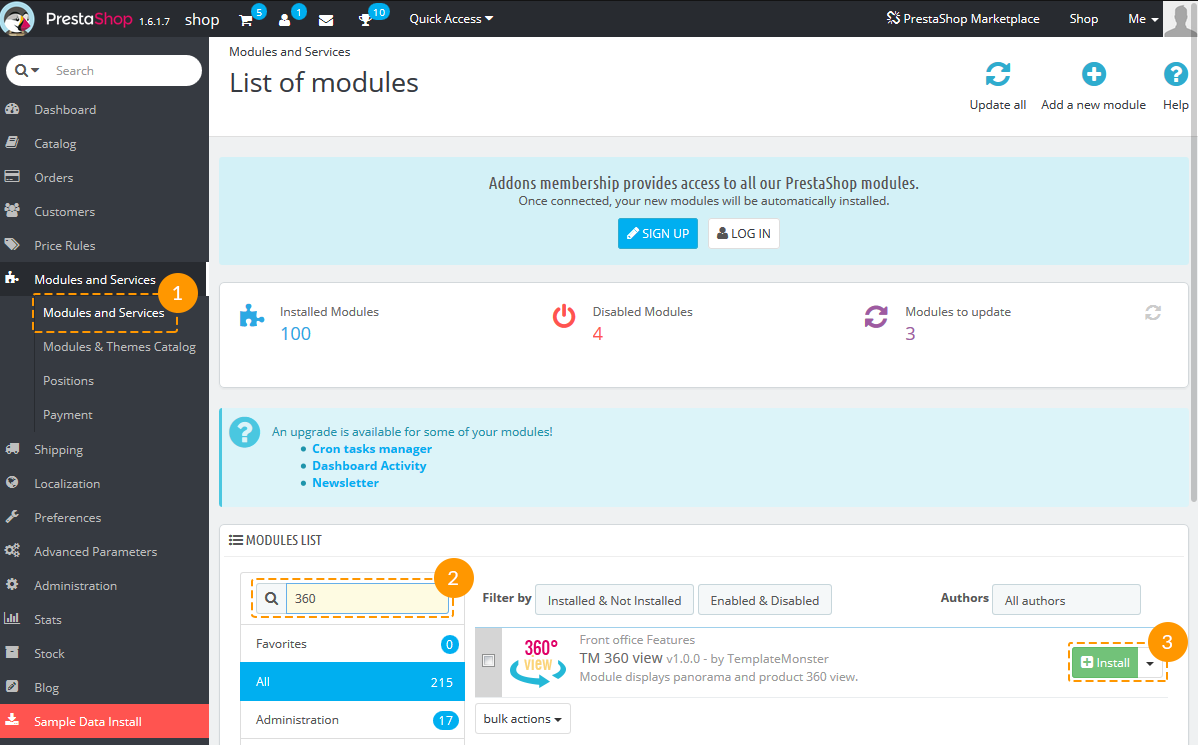
Module configuration
After the module has been successfully installed you'll see the 'Configure' page with the default module settings.
You can find here settings for 360 view (1) and for panorama view (2).
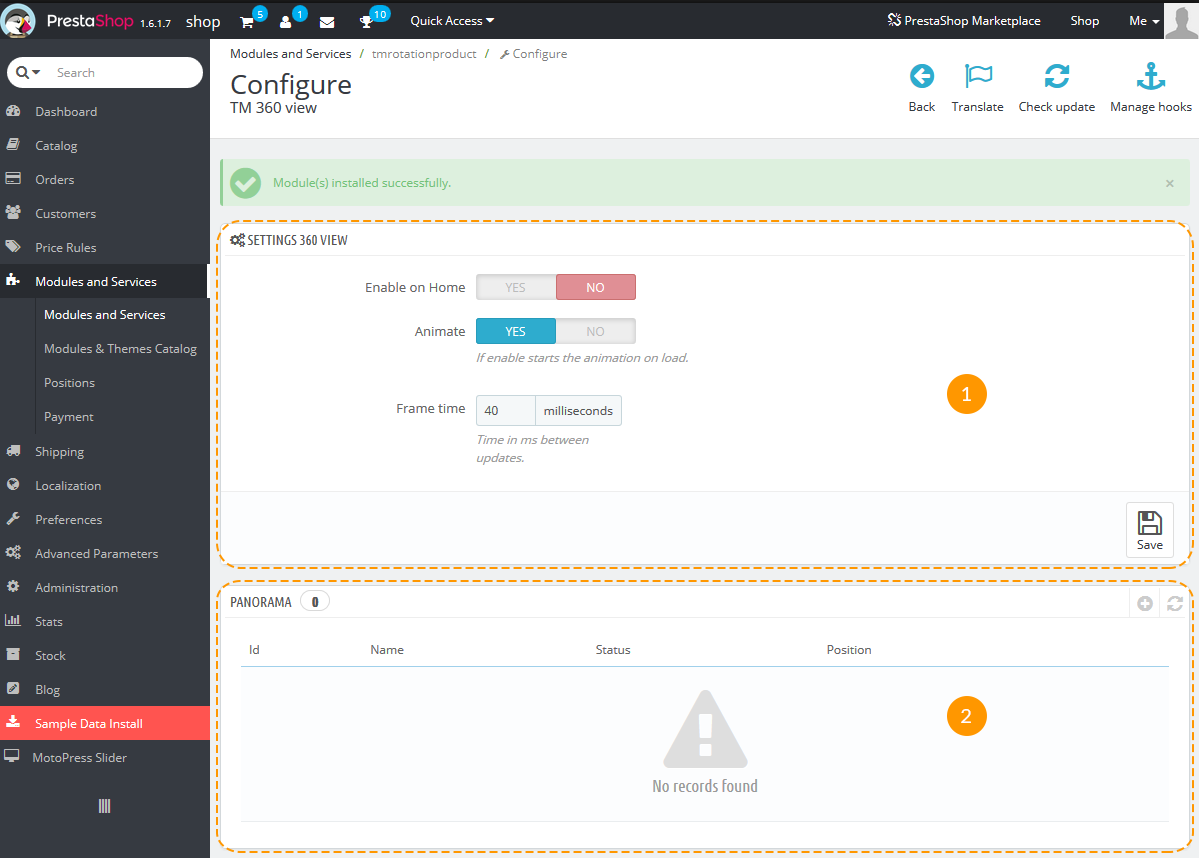
360 view
The settings are described below the screenshot. Choose them according to your needs and click the 'Save' button (1).
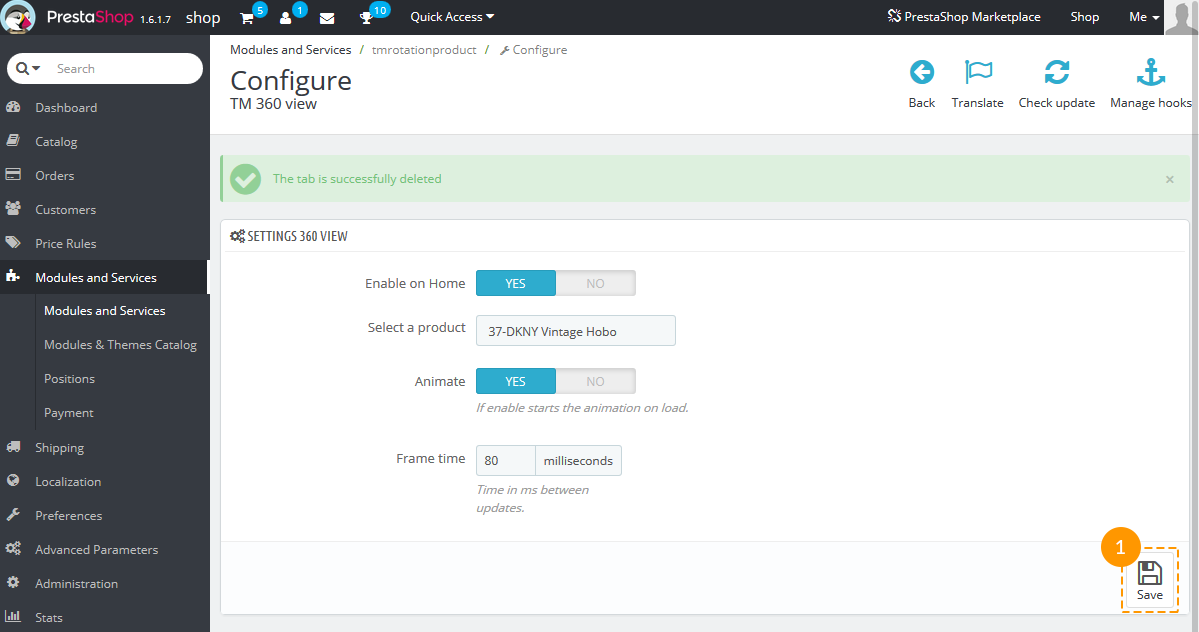
- Enable on Home - option to show the 360 view of the product on Homepage.
- Select a product(appears if 'Enable on Home' is set to 'Yes') - choose a product which should be displayed in 360 view.
- Animate - option to display the product automatically rotating on page load.
- Frame time(appears if 'Animate' is set to 'Yes') - time period before one image in the set will be changed to another; should be entered in milliseconds.
Adding/removing images
-
Navigate to Catalog -> Products in your admin panel (1), choose the product and click the 'Edit' button (2).
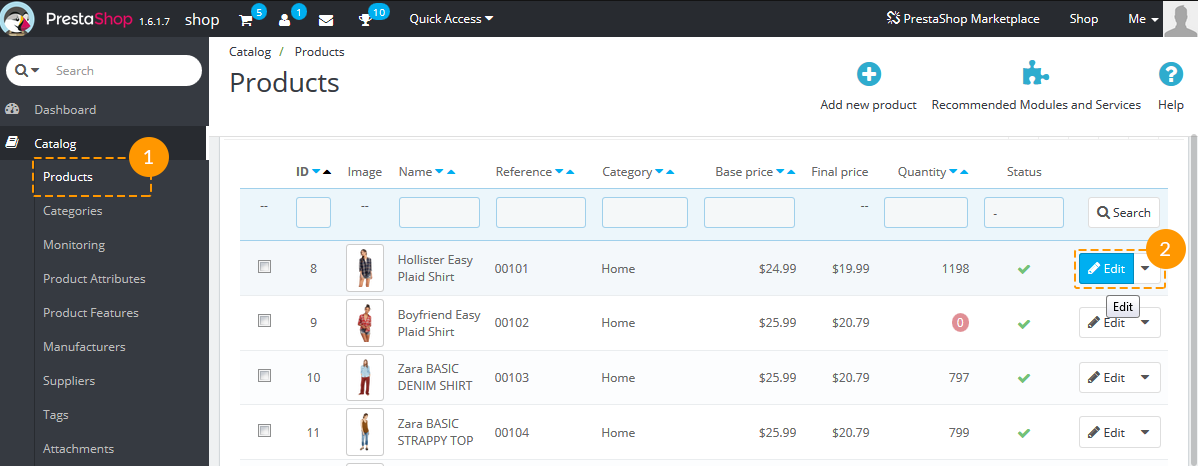
-
To add images, use the 'TM 360 view' tab (1) in product settings and click 'Add files' button (2).
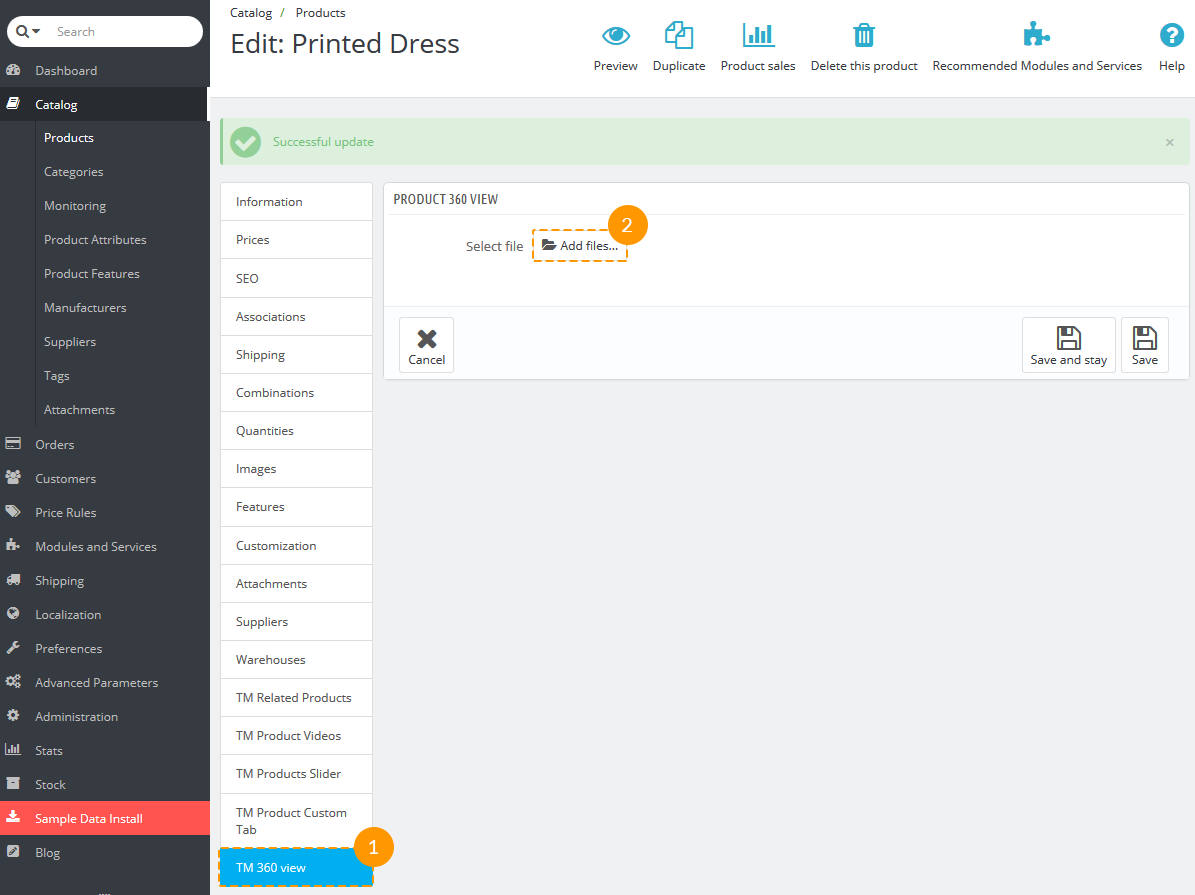
-
Then press 'Upload files' (1).
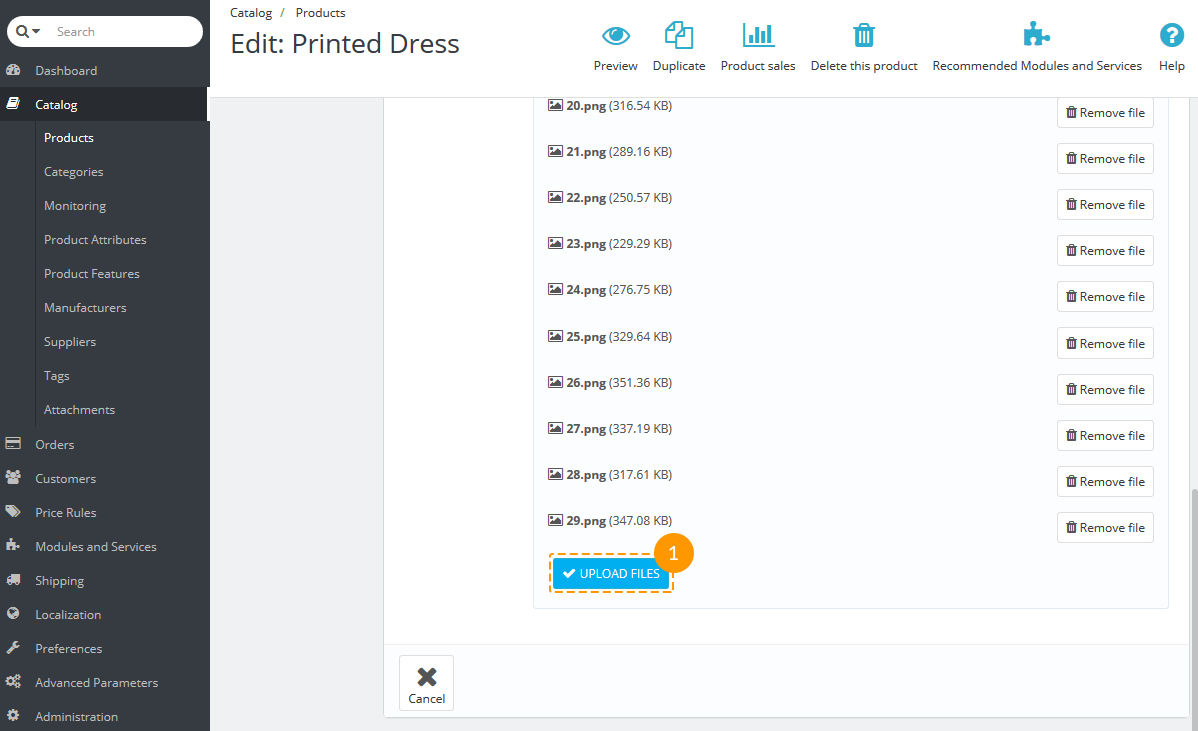
-
Wait till all files are uploaded.
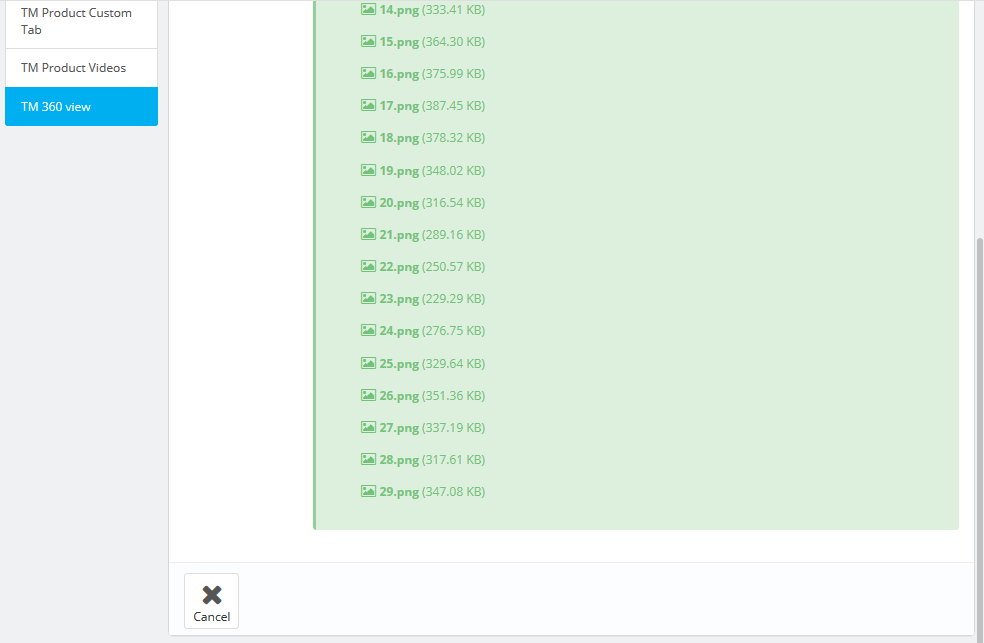
To make the rotation smooth, add more images and make a very slight change in position while making photos.
-
After you've added images, the product 360 view will be shown on the Homepage *.
* It will also appear on the product page after the description. -
To disable 360 view on the Homepage, simply go to 360 view settings and switch the 'Enable on Home' option to 'No'.
-
To disable 360 view on the product page, open the 'TM 360 view' tab in product settings and remove all images.
Panorama
Using this module is also used for adding panorama view to homepage or to the product page.
You can add as much panorama blocks as you need to the homepage.
Adding panorama to the Homepage
-
To add new panorama open the module configuration page and click '+' ('Add new item') button (1).
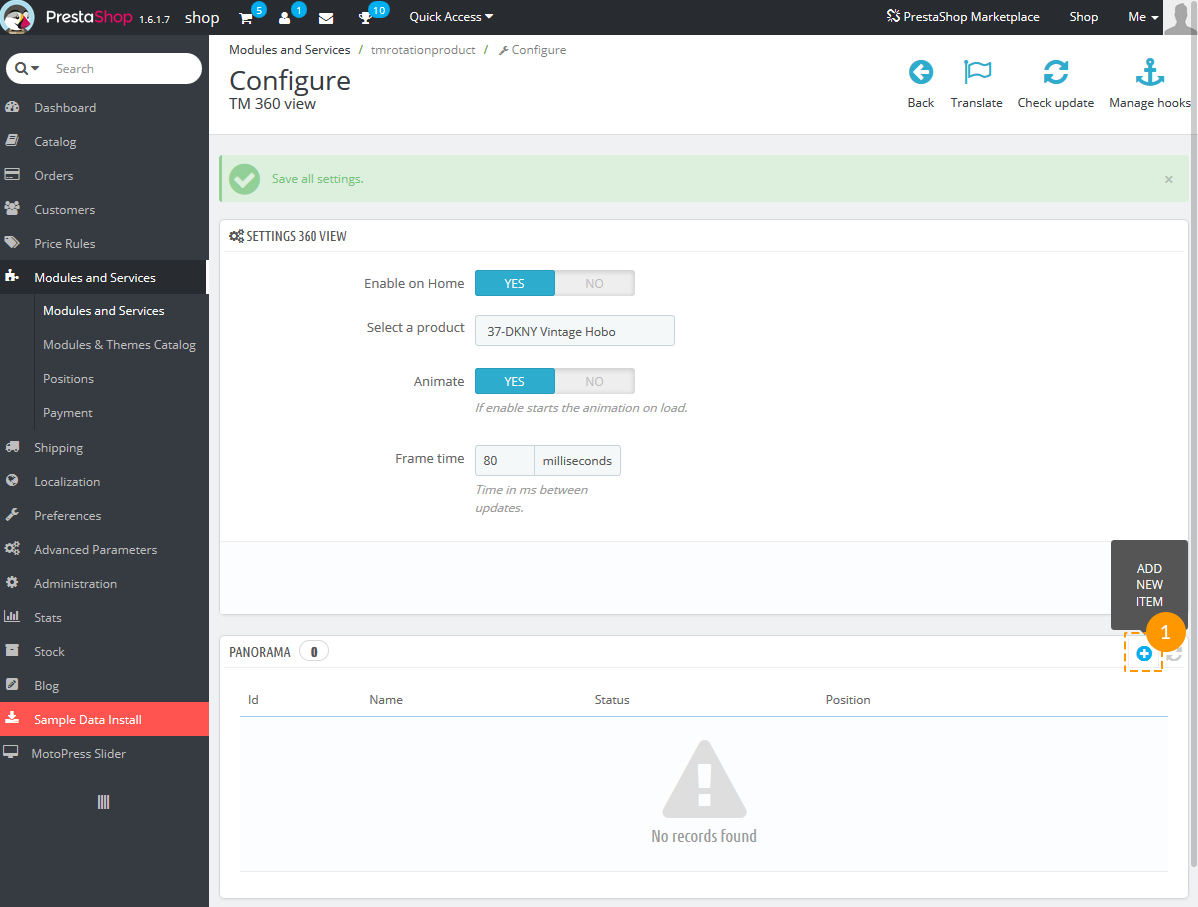
-
You'll see the panorama settings which are described below.
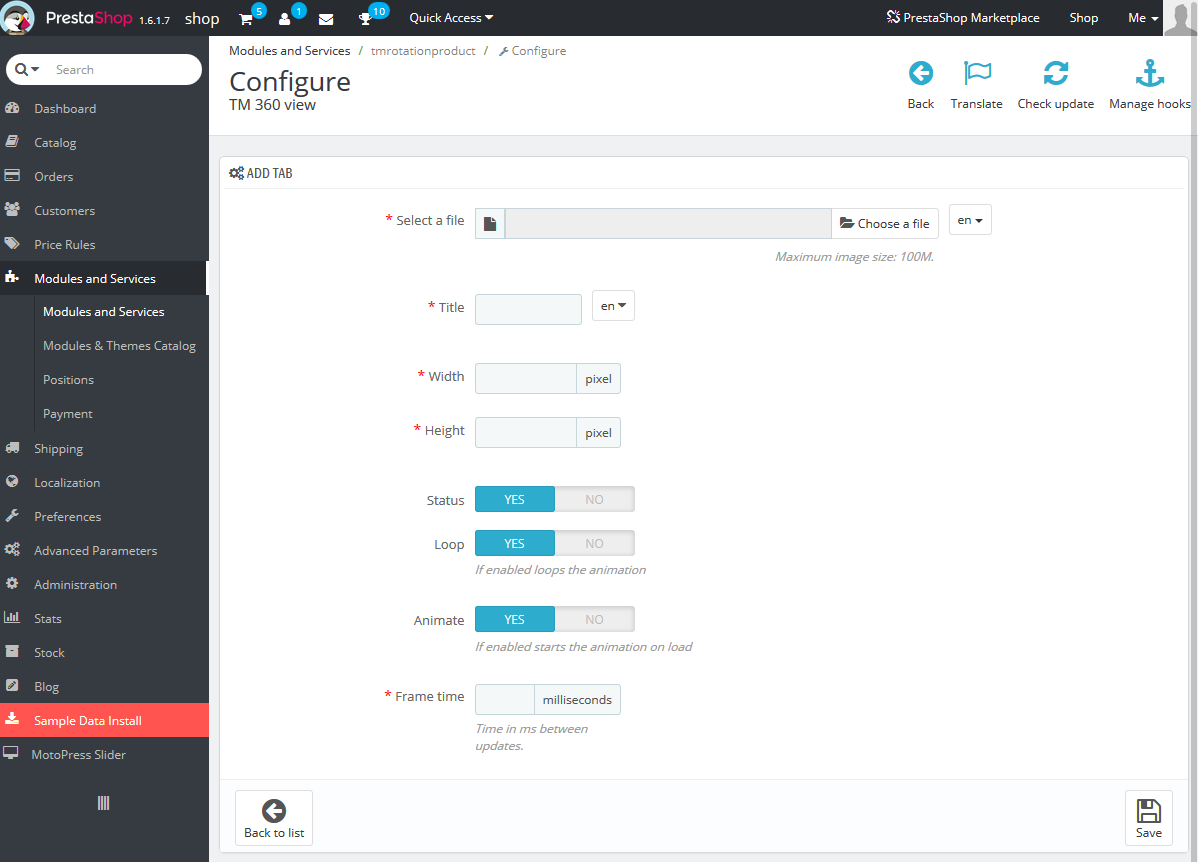
- Select a file - choose a panorama file; this field is required (at least for the default language).
- Title - enter a title for the panorama; this field is required (at least for the default language).
- Width - panorama block width; this field is required.
- Height - panorama block height; this field is required.
- Status - enable/disable panorama item on Homepage.
- Loop - start rotating the image from the beginning after it's end.
- Animate - option to display the panorama automatically rotating on page load.
- Frame time(appears if 'Animate' is set to 'Yes') - time period during which the panorama image makes a full circle; should be entered in milliseconds; this field is required.
-
Click the 'Save' button and your panorama image will appear on the Homepage.
Removing panorama from Homepage
-
To remove the panorama - choose the item, click the arrow down button (1) and then click 'Delete' (2).
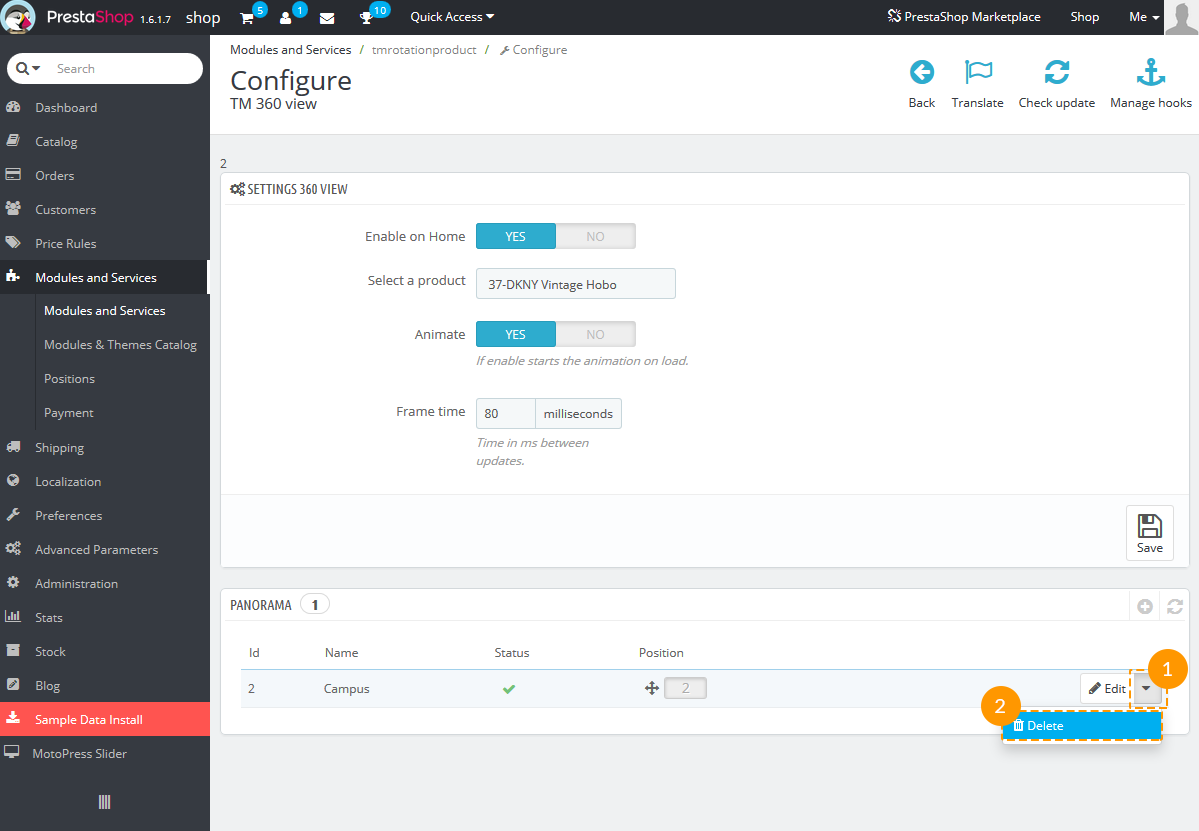
-
Then confirm the deleting.
TM Advanced Filter
Available in:
Spare Parts
Introduction
TM Advanced Filter module gives an opportunity to implement a quick search of the needed product based on key features. It allows to create filters with the unlimited number of search criteria, which are available in the store by default or are created, when adding the products. Filter criteria can be the following: levels of categories (by nesting), manufacturers, suppliers, attributes, features, and more. Also the module has the following features: creating connected filters, in which needed criteria become available only after selecting the parent parameter (nesting level is unlimited); selecting the filter criteria grid for the top page filter. You can select the filter field type from the available, specify the parent filter, add its name, label and description. All is easily set up and edited in the user-friendly admin panel. For the better speed, the module uses the products indexation algorithm by the set criteria. It can be easily and quickly inserted to a Prestashop store of any kind.
Installing and deleting the module
The module is installed and deleted like any other PrestaShop module.
After deleting or reinstalling the module, all the module settings and filters will be discarded.
Filter setup/editing
After installing the module, you can set it up on the module configuration page. By default, you'll see the tabs with available filter types. To start creating a filter, select a tab (1) and press the 'Create filter' button (2).

In the appeared filter window, fill in all the needed fields.
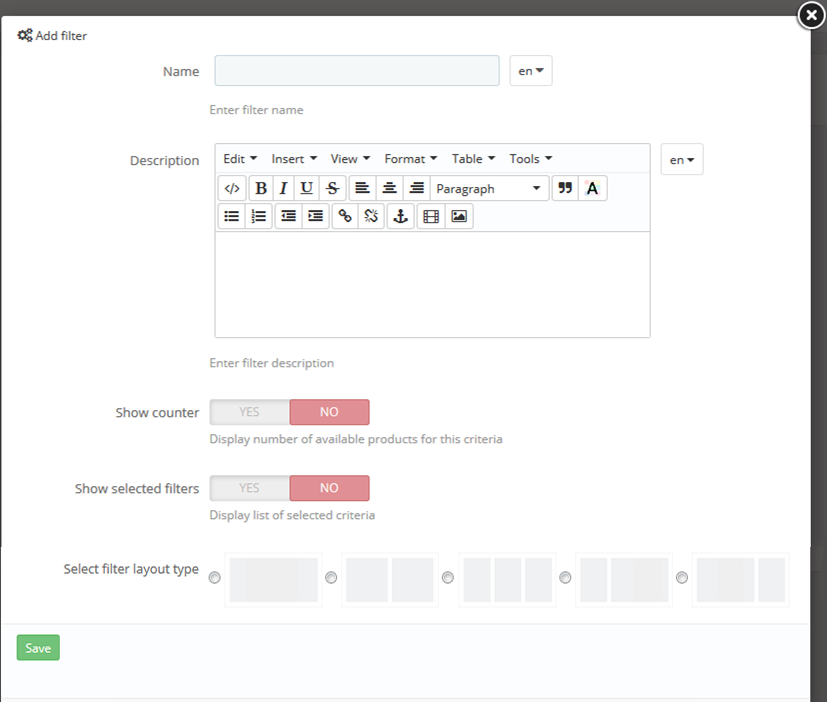
- Name - the name of the filter. It'll be displayed on the frontend as the filter block title;
- Description - the filter description. It'll be displayed on the frontend next to the filter block title;
- Show counter - allows displaying the number of products that will be available after selecting current parameter. The number will be displayed next to the search criterion (in brackets);
- Show selected filters - allows displaying the list of the selected search criteria with the ability to unselect any of them;
- Show filter layout type - selecting filter grid (available only for the Top Filter);
Please note that there are no required fields. If you leave all the fields empty, then a one-column filter with no description and title will be created.
Editing the filter
To change the description and filter settings, press the 'Cogwheel' button in the filter menu.

In the editing mode, the form looks and works as in the setup mode.
The filter grid selection is available only for 'Top filter'.
When changing the filter grid, all the elements will be automatically transferred to the first column, keeping the nesting and display order (based on the principle: all elements of the previous column with the display order kept inside).
Deleting the filter
To change the filter description or filter settings, press the 'Cross' in the filter menu

and confirm filter deletion.
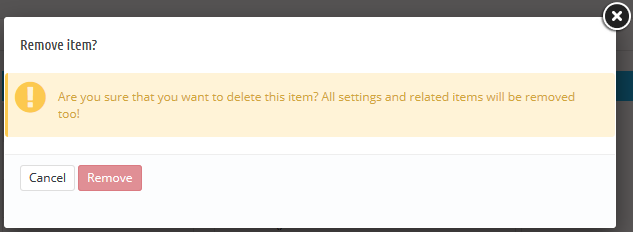
After deleting a filter, all the data will be permanently lost.
Filter indexation
Indexation - the process of creating unique tables with the data necessary for the filter, which is created for the filter-specific criteria. They allow to drastically speed up the filter work on the frontend.
The corresponding button in the filter menu is highlighted in red. If the button is not highlighted, the filter doesn't need indexation.

The re-indexation process can take some time, depending on the number of products in the store and selected filter criteria.
If the filter requires re-indexation, it won't be displayed on the frontend.
Creating/editing filter elements (criteria)
To add an element to the filter, select it in the panel of available elements (on the left) and drag it to the available area of the filter grid (it will light up after being selected. In the example, the grid has 2 columns).
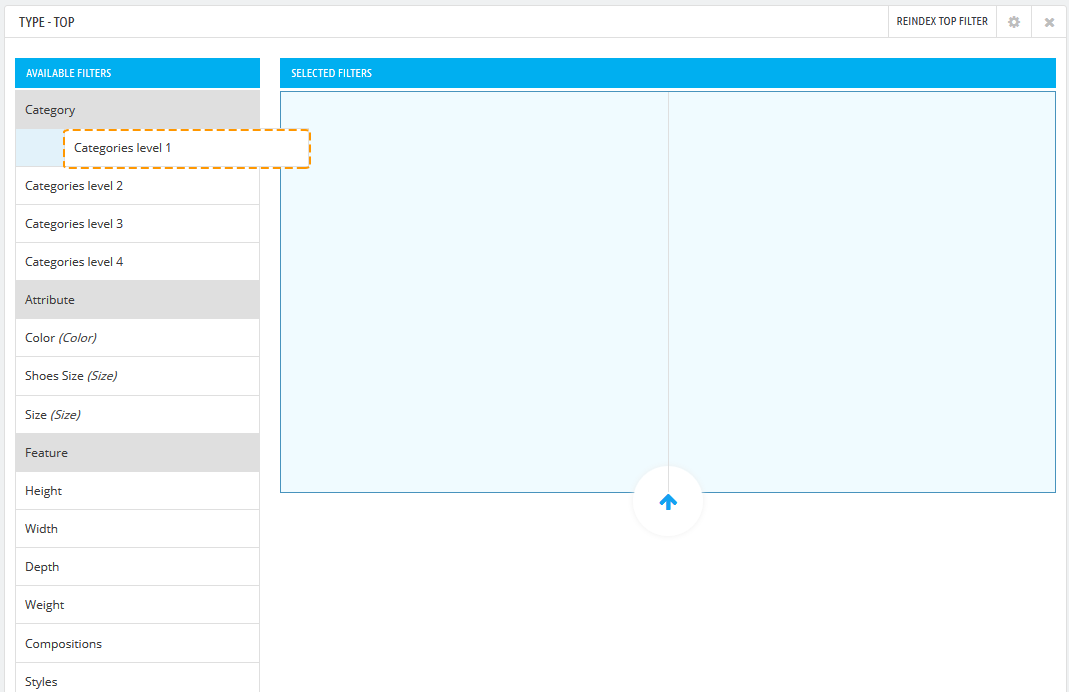
In the highlighted area select the column and position of the new element and drop the element.
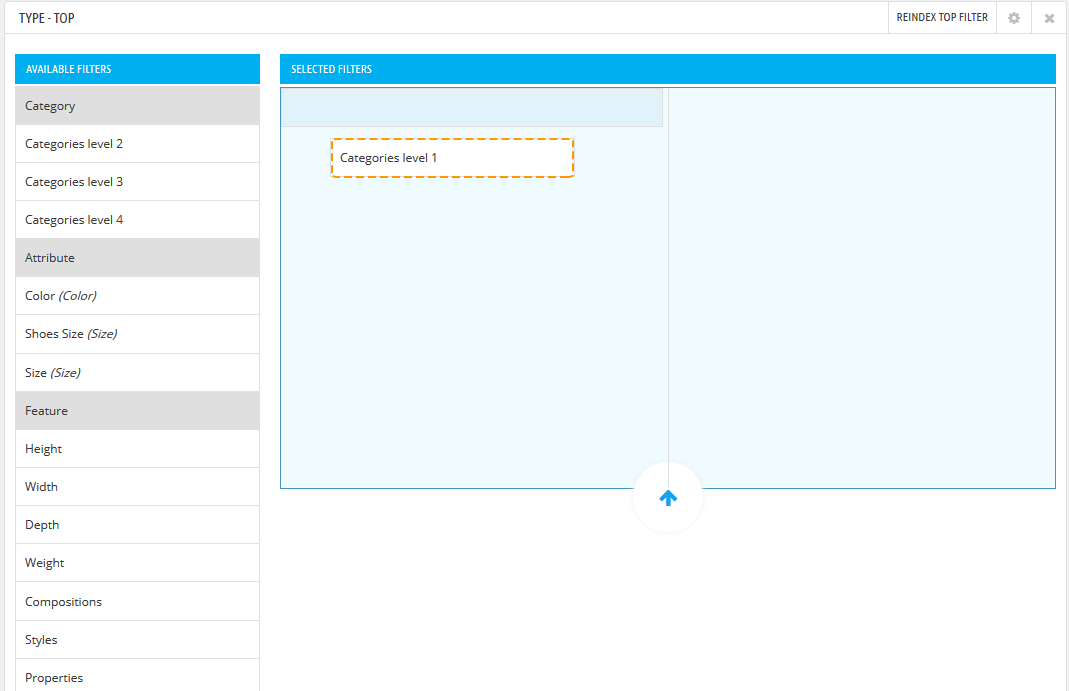
In the appeared element creation window, supply all the necessary data:
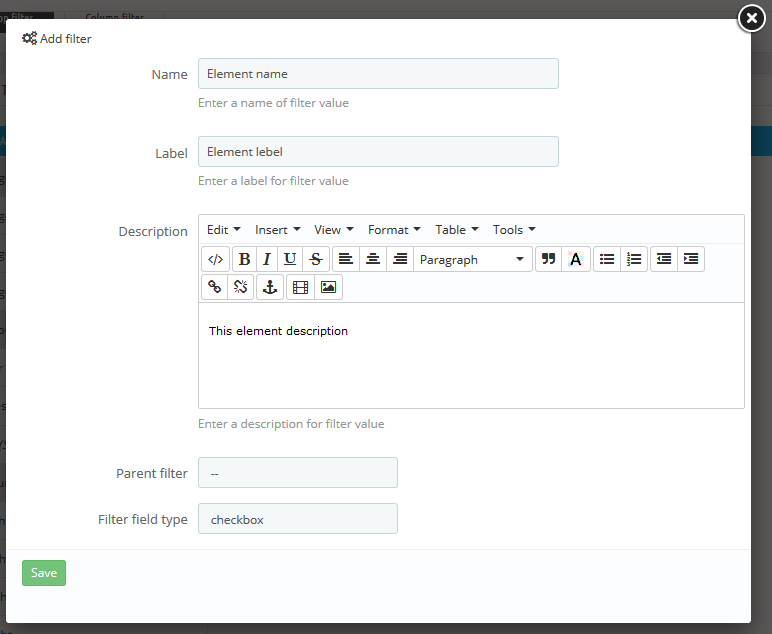
- Name - the name of the filter element on the frontend. It won't be displayed, if you leave the field empty.
- Label - the label of the filter element on the frontend. It won't be displayed, if you leave the field empty.
- Description - the filter element description on the frontend. It won't be displayed, if you leave the field empty.
- Parent filter - the filter parent element, after selecting which this element will be available. The element will be always available if the field is left empty.
- Filter field type - the way the element will be displayed on the frontend. The following types
are available:
- radio
- select
- checkbox
- range-select (only for the 'price' field type)
- range-input (only for the 'price' field type)
You can change all the data and the parent element in the filter editing mode.
After editing the element, the filter should be re-indexed, which is shown by the button in the filter menu. Do not go for reindexing the filter after editing every element, you can do this after applying changes to all the needed elements - by doing so you'll save your time.
If there is a tree of connected filters, you can add the new element as a related to this tree.
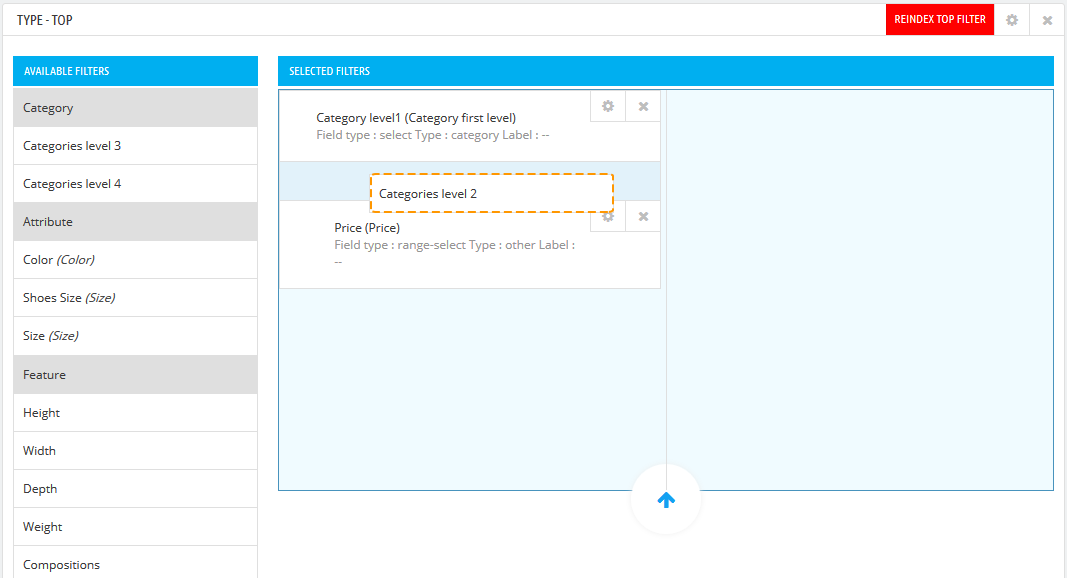
Editing the filter element
To edit a filter element, press the 'Cogwheel' button (1) in the filter upper right corner.

Sorting (display order of the filter elements)
By default, the new elements are displayed after the element in the order you've added them. If the filter is added to the tree, it'll be displayed after the existing elements in the tree.
To move the elements inside the filter, select the needed element and drag it to the needed position. You can drag elements in one column, as well as to another grid columns. You can also change the sorting inside the tree, or move the whole tree at once.
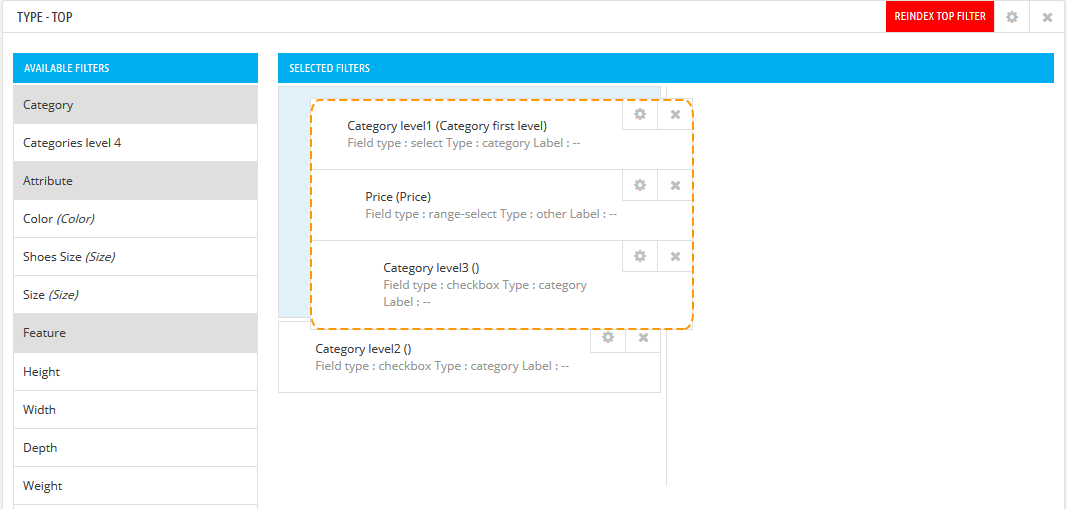
After moving the element from one column to another, the display order will change automatically in all columns.
Deleting the filter element
You can delete a filter element in two ways:
drag the element back to the column of available elements;
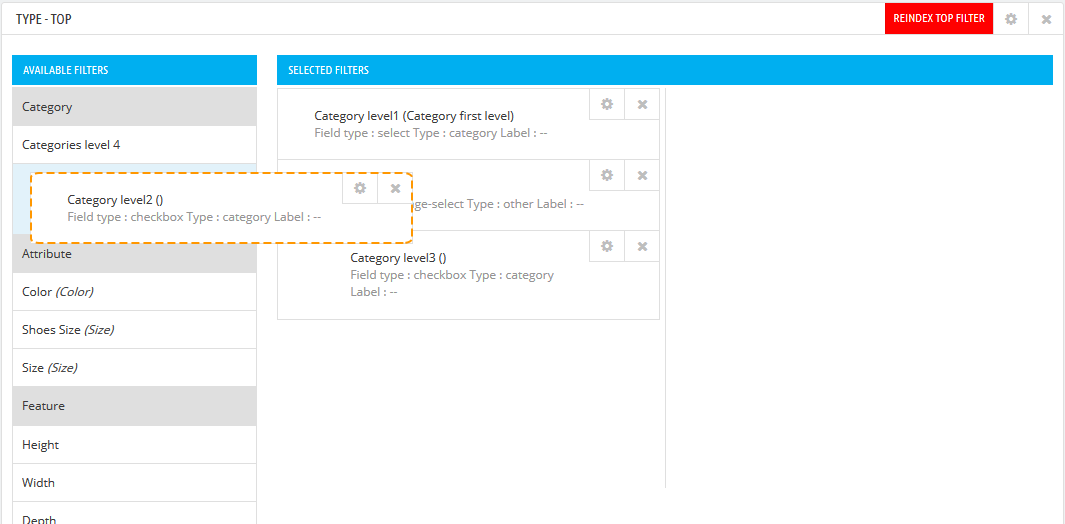
or press the 'Cross' in the upper right corner of the needed element.

Regardless of the chosen method, you'll see a window of deleting confirmation.
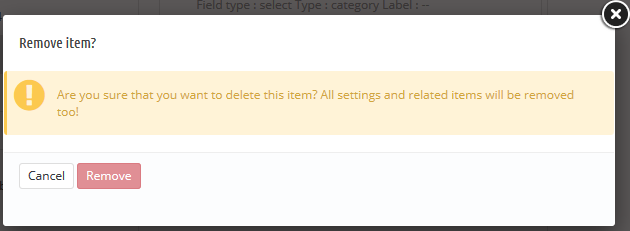
After deleting a filter with nested elements, all the nested elements will be deleted.
After deleting an element, the filter needs to be re-indexed, what is indicated by the button in the filter menu. Do not go for reindexing the filter after editing every element, you can do this after applying changes to all the needed elements - by doing so you'll save your time.
"Smart" reindexation
The module provides the automatic (smart) reindexation after making changes to the products or after some other crucial changes (manufacturer, attribute, etc.). The table fields will be reindexed, if these changes affected the filter functioning.
If, after making changes, the filter did not take them automatically, enter the filter settings page and reindex it manually.
The filter won't be reindexed automatically after adding currency, that's why it should be reindexed manually.
FAQ
- I've created a filter, but I don't see it on the frontend.
- I've added the filter name and description, but they are not displayed on the frontend.
- I've added elements to the filter, but it stopped displaying on the frontend.
- I want the element to be available only after another element is selected.
- I want to swap elements.
- I want to delete a parent element, but want to keep all the nested elements. How to achieve this?
- I want to change the filter grid, but I don't want to create the filter again. What can I do?
- How to create a completely new filter, if there is already a filter for this position?
- The filter stopped displaying on the frontend.
- Why not all the elements are active on the frontend?
Make sure that there are elements in the filter and that it has been reindexed.
TM Category Products 1.0.0
Available in:
Fashion, Electronics, Spare Parts, Furniture
This module displays category products in displayHome and displayHomeTabContent hooks. The module allows displaying single products, products from a category or all products. Moreover, the module comes with a carousel that works, when the module occupies the displayHome position.
TM Category Products Main Panel
The main panel. Here you can set up the module.
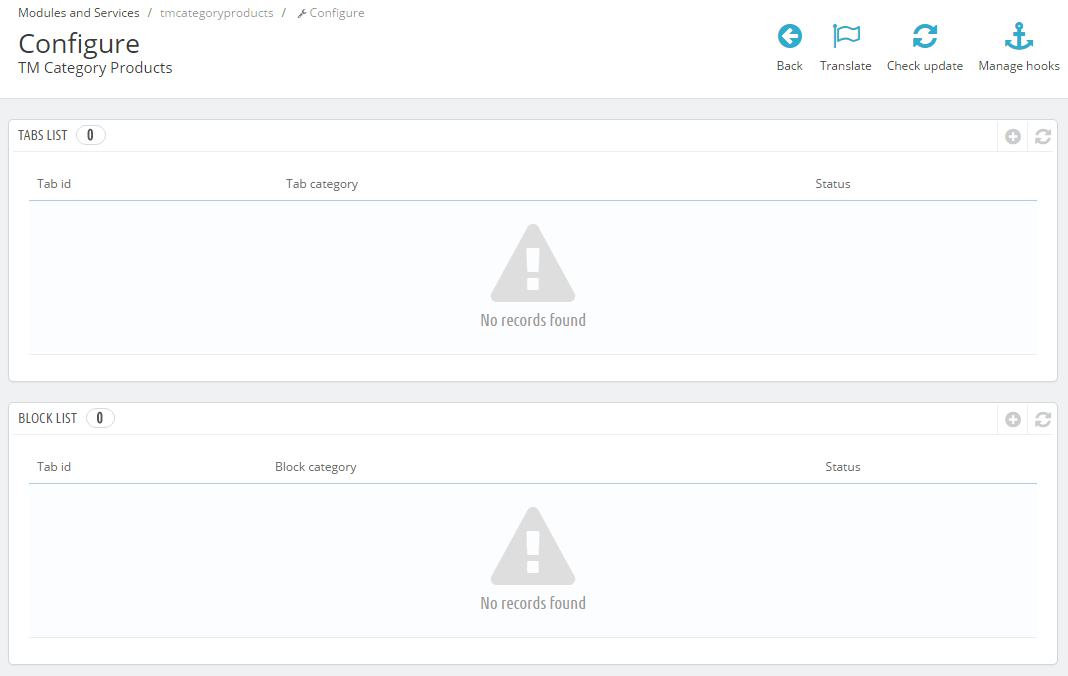
Adding a Tab
Tab is a block that displays products in displayHomeTabContent position.
Navigate to the module main panel and press the 'plus' (1) button in the tabs list.

In the appeared form, you'll see the following options:
- Status - this option allows enabling/disabling the tab.
- Select category - the category, products of which will be displayed.
- Use custom name - this option allows changing the displayed category name. If enabled, the following
form will be displayed:
- Name - the custom tab name, displayed on the website.
- Select products to display - if disabled, displays the 'Number of products to display' field, which sets the number of products to display. If enabled, displays the 'Add products' button that allows selecting products to display in the tab.
After configuring all the needed options, press the 'Save' (2) button.
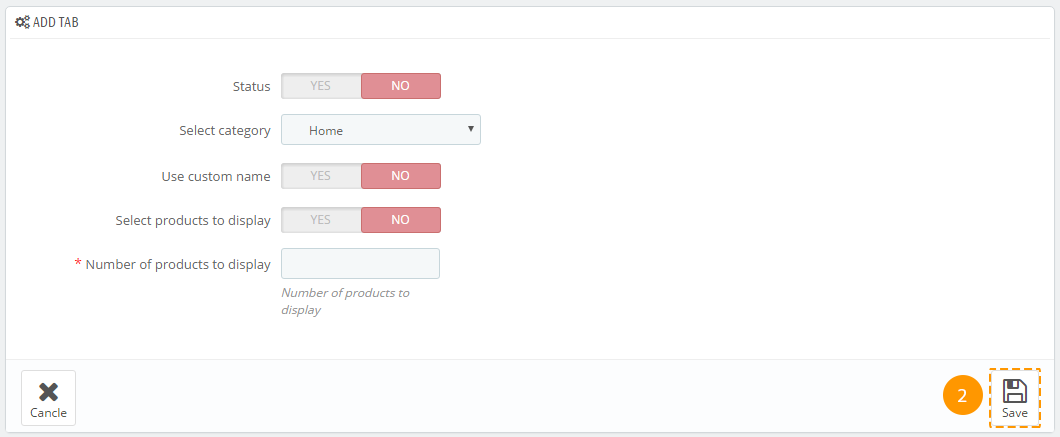
Adding a block
This block allows selecting products in displayHome position.
Access the module main panel and press the 'plus' (1) button in the blocks list.

In the appeared form, you'll find the following options:
Status - this option allows enabling/disabling the block.
Select category - the category, products of which will be displayed.
-
Use custom name - this option allows changing the displayed category name. If enabled, displays the following form:
Name - the custom tab name, displayed on the website.
-
Select products to display - if disabled, displays the 'Number of products to display' field, which sets the number of products to display. If enabled, displays the 'Add products' button that allows selecting products to display in the tab.
-
Use carousel - this option allows enabling/disabling the carousel for block products. After enabling the option, you'll see the following settings:
Visible items - the number of visible items.
Items scroll - the number of items changed with one carousel scroll.
Slide Width - the carousel list item width.
Slide Margin - the carousel list item margin.
Auto scroll - auto scroll of carousel items.
Carousel speed - speed of changing items.
Pause - pause between scrolls (if "Auto scroll" is enabled).
Random - the carousel starts with a random item.
Carousel loop - the loop: when all the carousel items have been displayed, carousel starts from the beginning.
Hide control on end - hide control buttons (Next/Prev).
Pager - display pagination.
Control - display controls (Next/Prev).
Auto control - display controls (Play/Pause).
Auto hover - carousel pauses, if the user hovers a list item.
-
After configuring all the needed options, press the 'Save' (2) button.
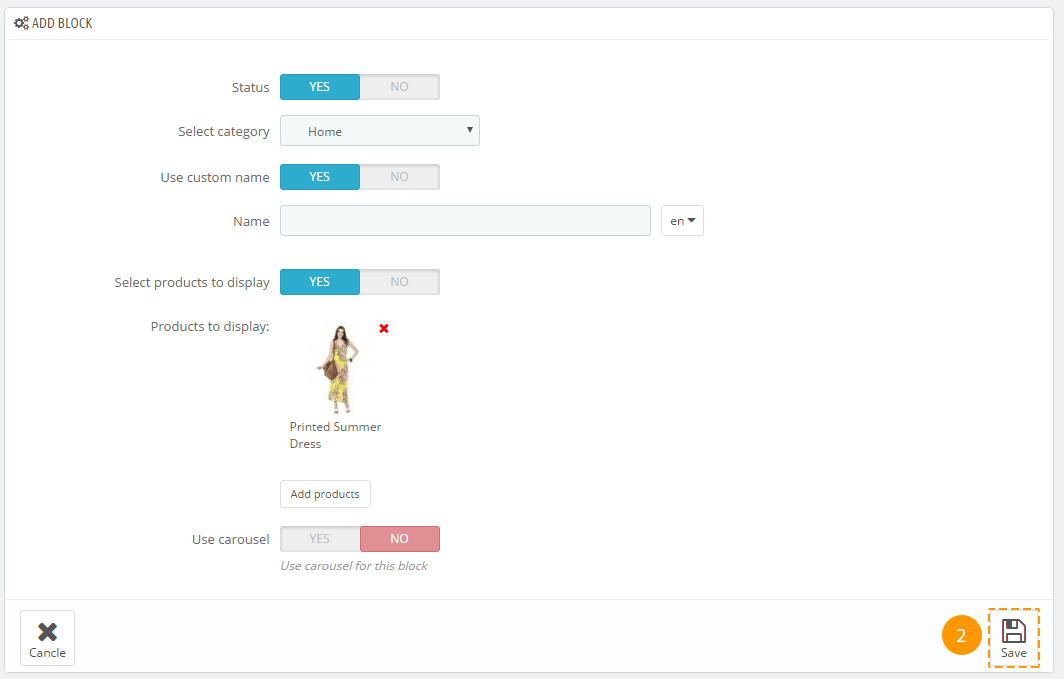
Blocks/Tabs Sorting
You can sort the blocks of the module with the help of drag'n'drop. This allows to change blocks and tabs positions quickly.

Selecting Products
If you create an item and enable 'Select products to display' option, you can choose the products that you want to display. To do this:
Press the 'Add products' (1) button:
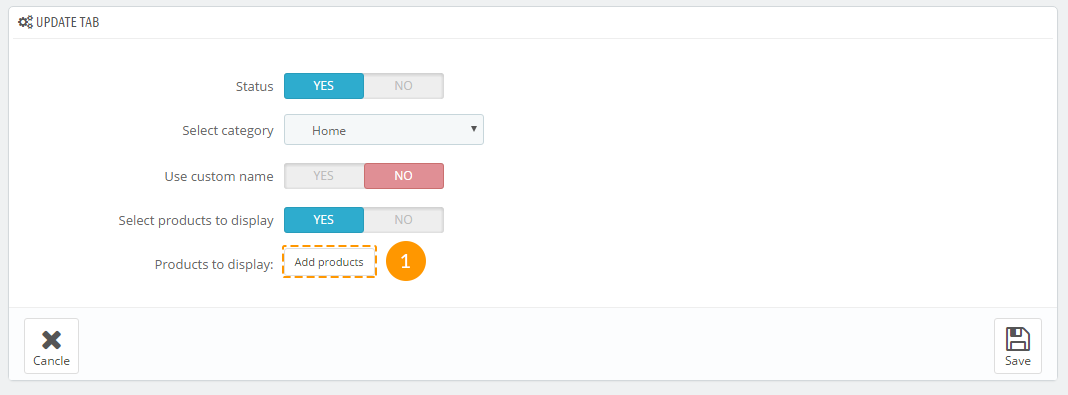
In the appeared pop-up, select the needed products (2) and press the 'Add' (3) button:
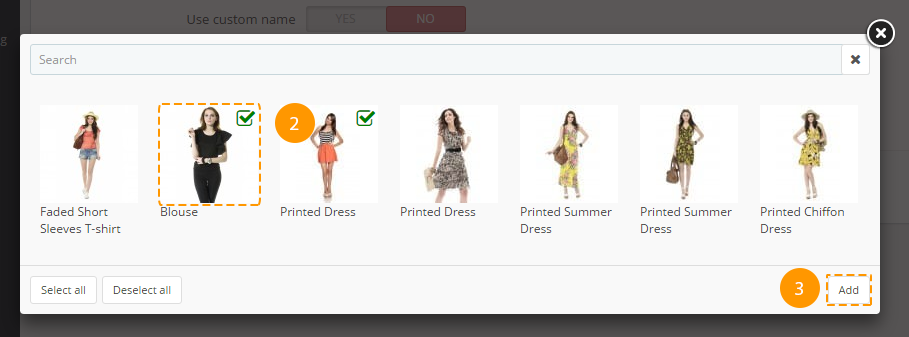
Now, you can place the added products wherever you want with the help of drag'n'drop (4):
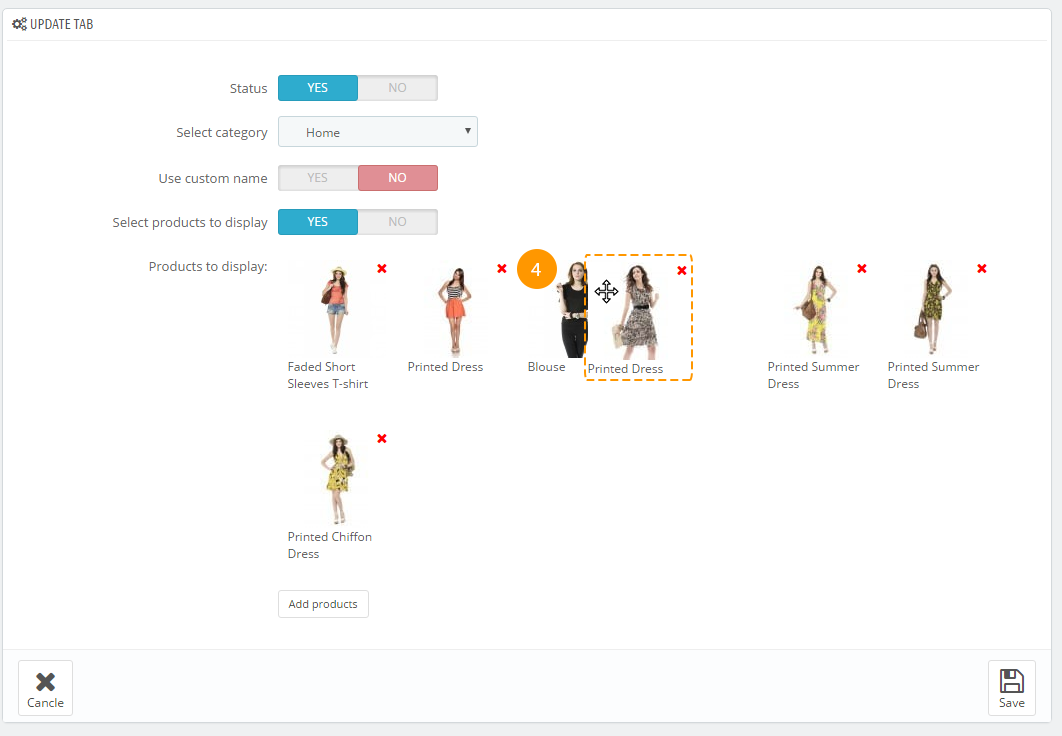
When all the needed products are added and arranged in the desired order, press the 'Save' button.
Deleting Blocks/Tabs
To delete items, press the drop-down menu next to the needed block/tab (1) and press delete (2). The item will be deleted.

TM Collections
Available in:
Fashion, Electronics, Spare Parts, Furniture, One Product
TM Collections module is created to give the ability to the visitors of online store to add products to collections and share this collections on Facebook.
Module Installation
То install the module navigate to Admin panel -> Modules and Services -> Modules and Services (1), find the TM Collections module (2) and press 'Install' button (3).

Module Configuration
After the module has been installed, the 'Settings' page will appear.
Add the Facebook App Id to the required field (1) and press 'Save' button (2).
The instruction how to get the Facebook App Id can be found here: Creating an App ID.

Using TM Collections Module
Adding product to collection
Shop visitors should be logged in to be able to add the items to collections.
-
After the module is installed, the button 'Add to collection' appears on each product page. It should look like on the screenshot below (1).
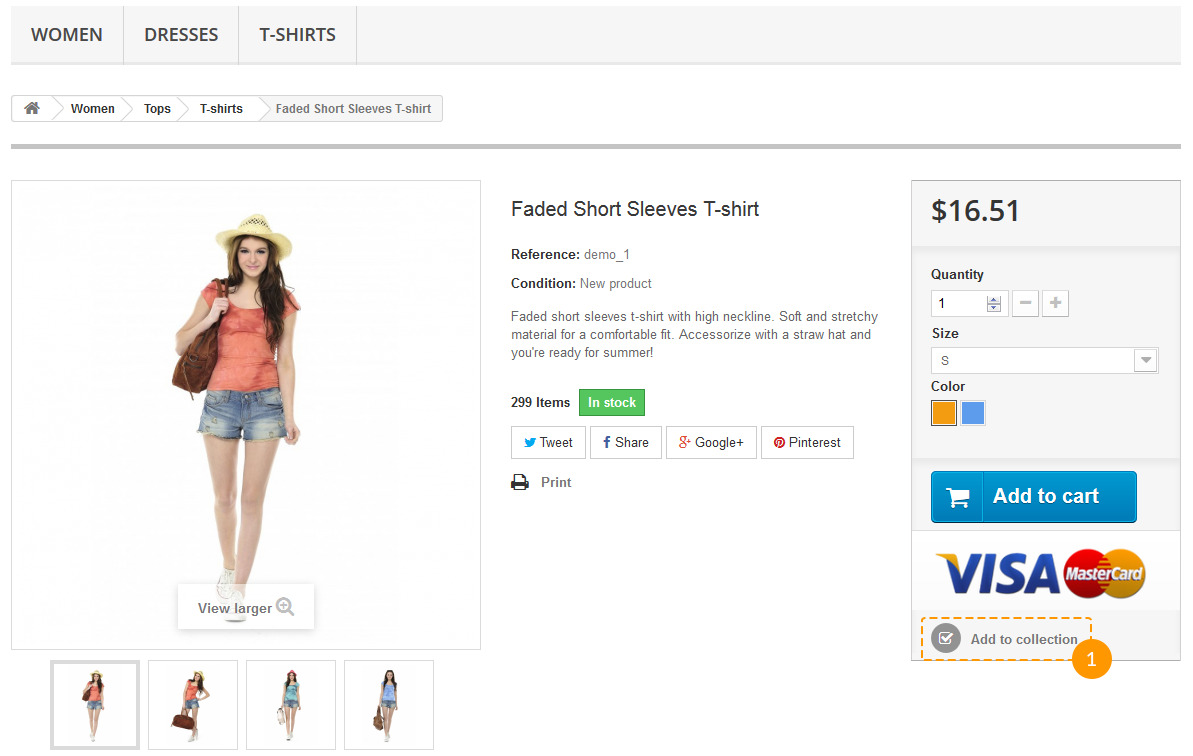
-
After clicking this button a shop visitor will see a notification: 'The product was successfully added to your collection.' It can be closed or skipped to collections view by clicking 'My collections' button (2).

Browsing Collections
-
On 'My Collections' page a client can add the new collection (1) or view the list of created ones (2).
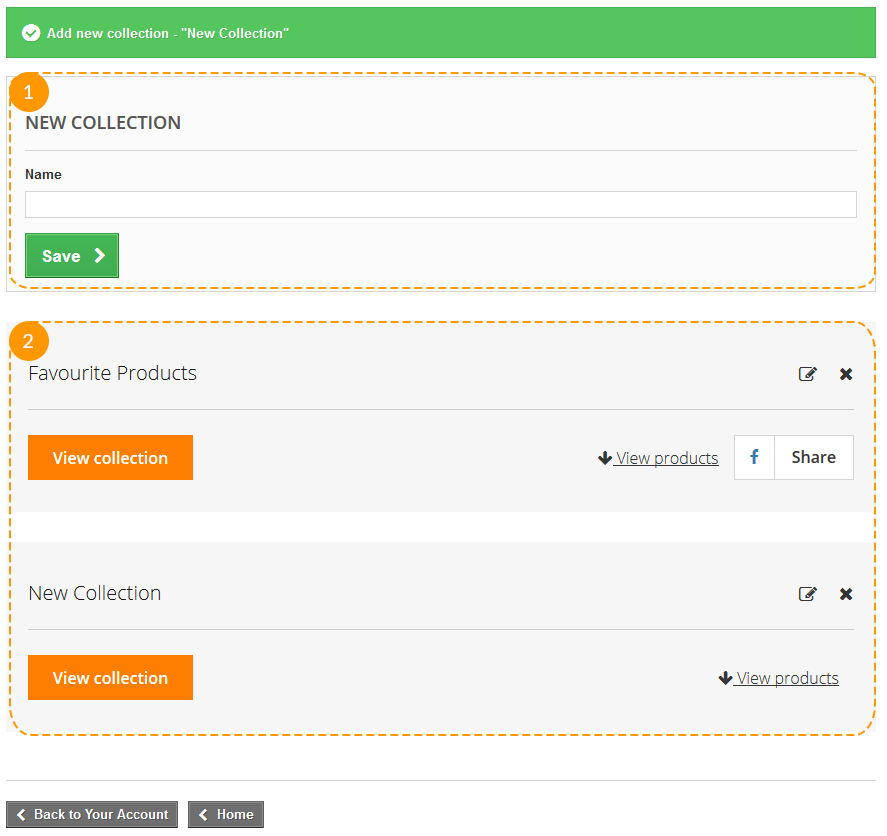
-
Clicking 'View collection' button (1) will open the colection page, the 'View products' button (2) gives the ability to see the products list of this collection on current page.
The title of collection can de edited (3) or deleted (4).
To share the collection the visitor should press the 'Share' button (5).
-
While looking through the items in collection after clicking 'View products' button, each item can be removed from the list (1).
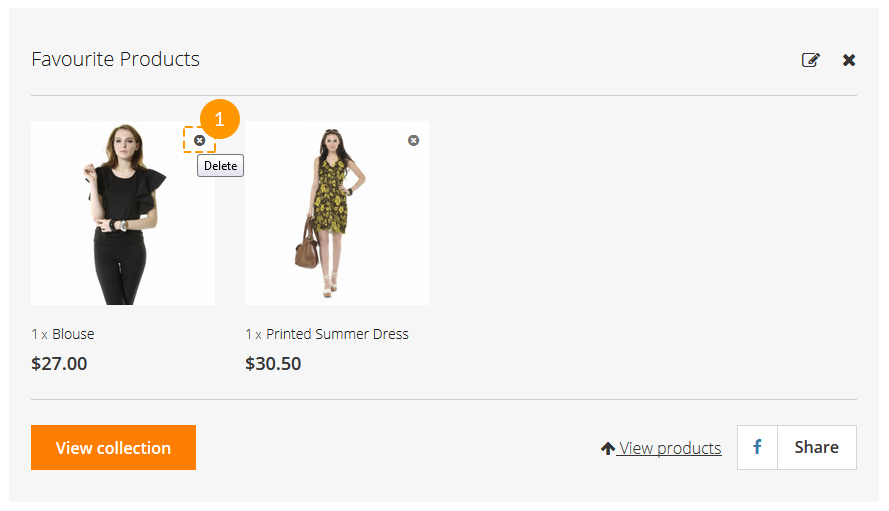
Sharing Collections
To share the collection the visitor should press the 'Share' button. There will be a few easy steps to follow before posting the collection. During each step there's an ability to go back and change the sharing options.
-
First step is to choose the layout for collection that will be posted.
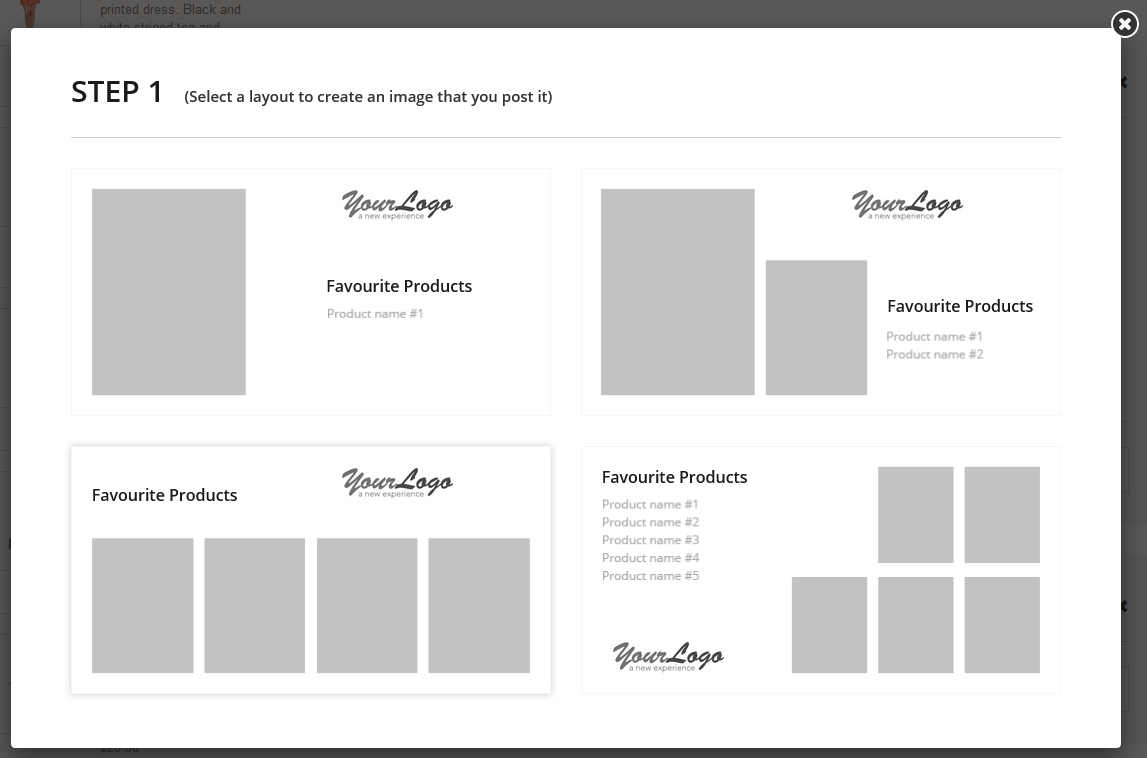
-
Then the products should be added. Each cell with a '+' is a button to add the product image.
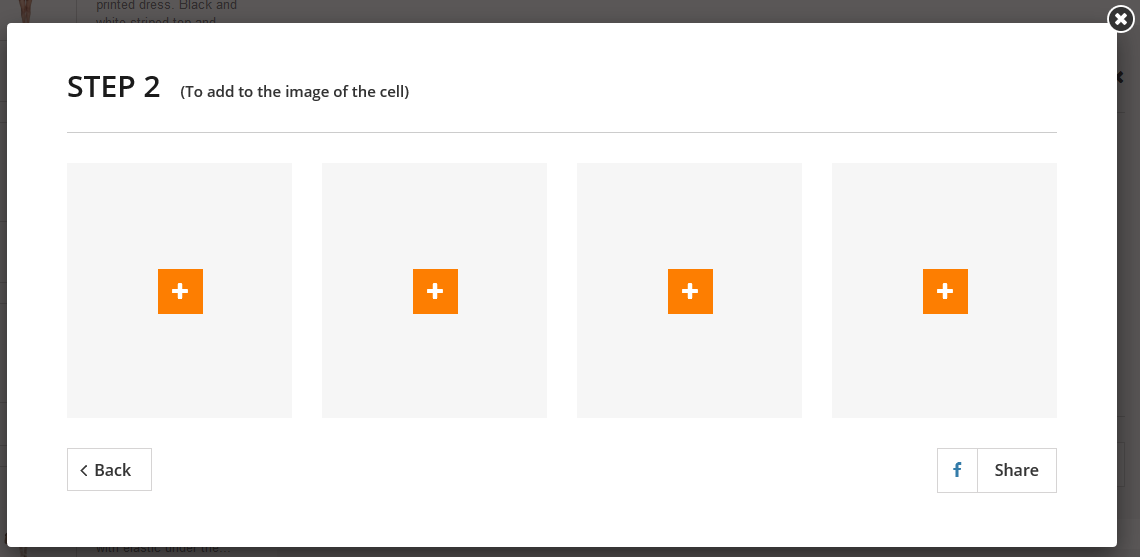
Choosing the images of each product:
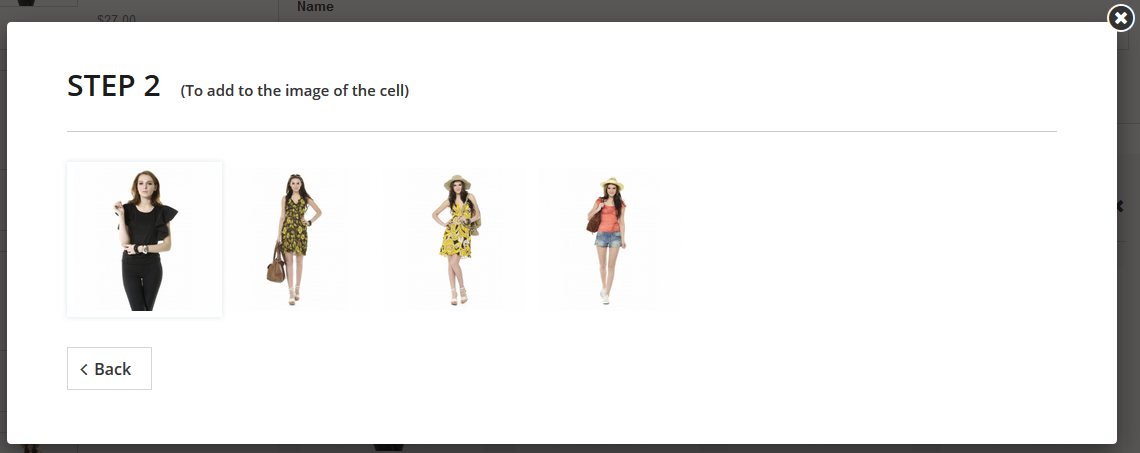
-
When all images are added, the visitor should press the 'Share' button (1).
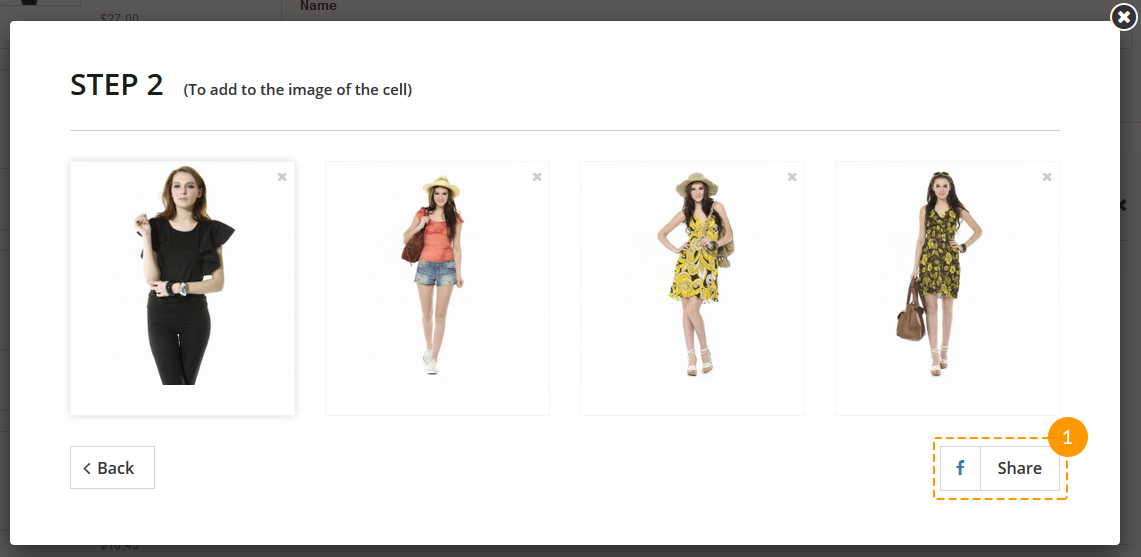
-
In a small window which is then appeared there will be some standard posting options to choose and the ability to add some text to the post (1). After clicking 'Post to Facebook' button (2), the post will be published.
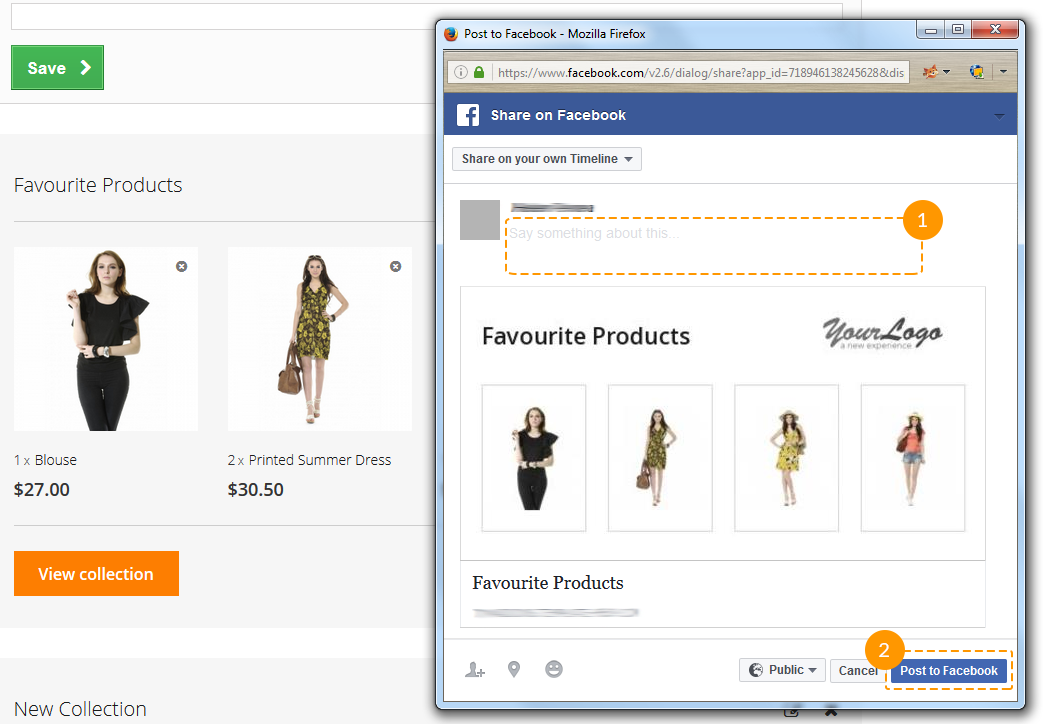
Statistics
Using this module you can also get the statistics collected while the products are added to collections. Thus you
will know which products are currently popular. This information can be very useful for suggesting a discount, for
example.
You can view the statistics navigating to Admin panel -> Stats -> Stats -> TM Collections.
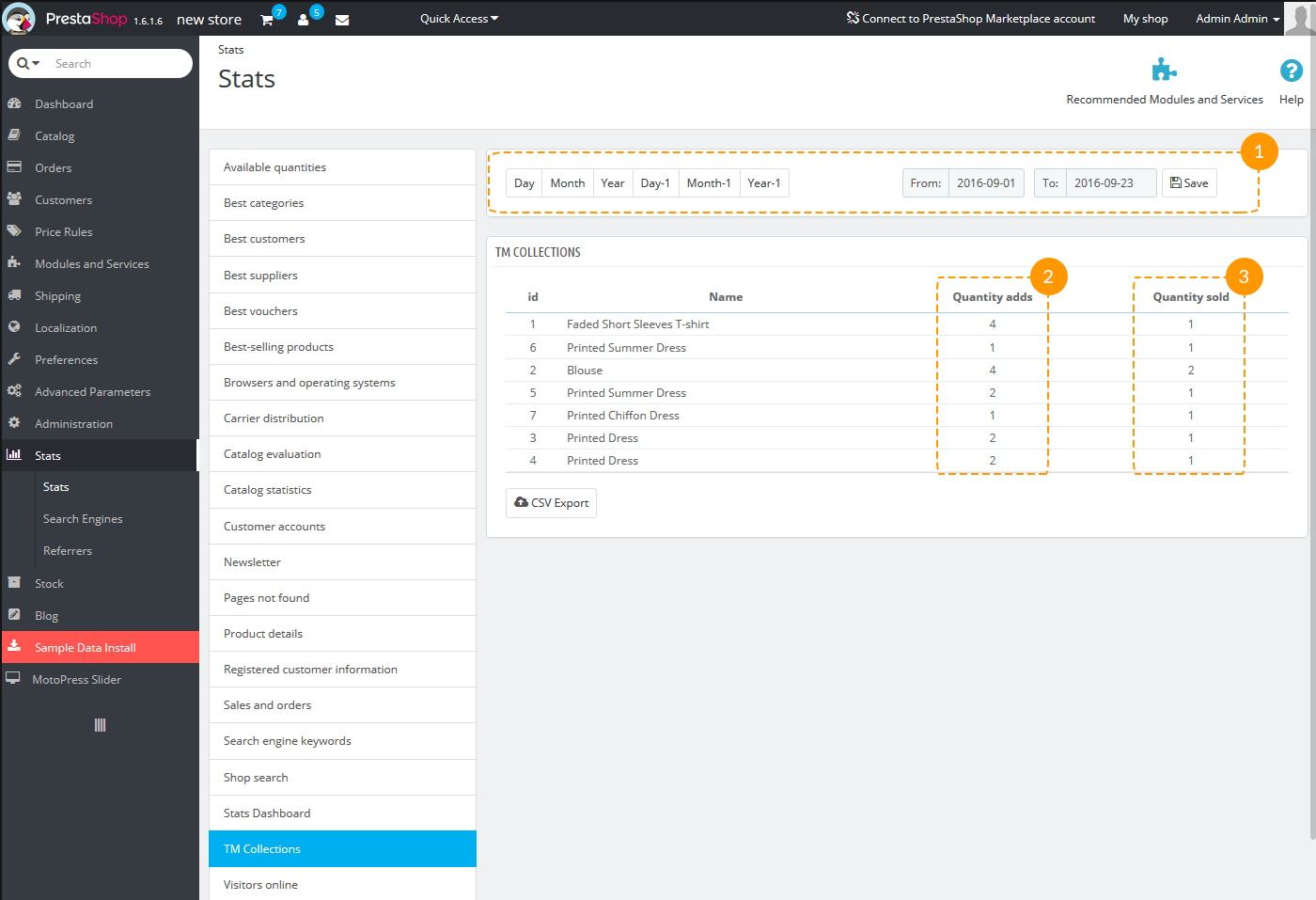
- You can select the period for viewing the statistics from the specified time (1).
- In the first column there's a number of product addings (2).
- The second column is created for your convenience. You can use it to see how many of added products were sold (3).
TM Deal of the Day
Available in:
Furniture, One Product
This module allows you to display the list of products with the discount countdown timer. You can also add a timer to products in the home page tabs, on the category pages and single product pages.
Installation and Deleting
The module is installed and removed the same way as any other PrestaShop module.
Module Settings
After module installation you can add a product discount with the display period and a discount countdown timer.

Adding/removing/editing blocks
-
In order to add a new product, press 'Add new' button
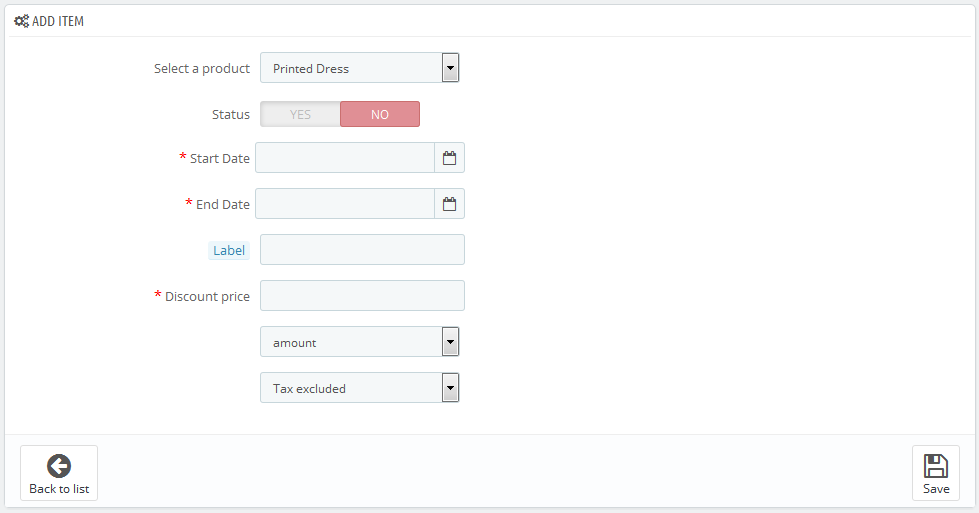
- Select a product - select a product to apply the discount and display a timer.
- Status - item status.
- Start Date - start date of the product discount period.
- End Date - end date of the product discount period.
- Label - product label.
- Discount price - discount price (absolute or percentage value).
-
After saving the item it appears in the list of items of this type.

-
In order to edit this item, press 'Edit' button.
-
In order to remove this item, press 'Delete' button.
-
If a special price valid for a certain period was set to the product previously, this product can be added to the module items list.
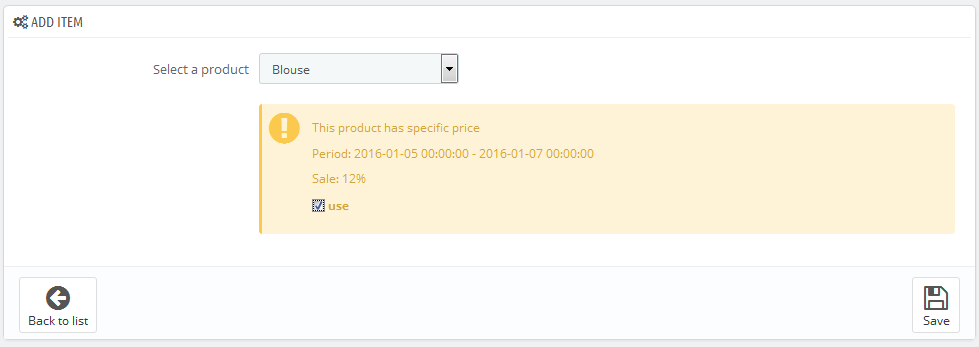
Product display configuration
-
In order to change product display mode, press 'Configuration' button.

-
Then a form with product display configuration will appear.

- Products to display - number of products to display in the home page block.
- Random products - random products display.
TM Header Account 2.0
Available in:
Fashion, Electronics, Spare Parts, Furniture, One Product
If you have the 1.n version of this module installed in your prestashop engine, you are not suggested to update it with the current one. First you need to remove the old version of the module to run without errors.
For the correct module functioning, make sure that the service for sending messages on server is configured correctly. To check if it works correctly navigate to Admin panel -> Advanced parameters -> E-mail -> Test your email configuration -> Send a test email.
This module displays login and registration forms on the website. It can take the following positions: website header, left and right column. The module allows to log in and register using such social networks as Facebook, Google+ and VK, which is convenient for website users. Registration or logging in proceeds without reloading the page.
TM Header Account Main Panel
The main panel. Here you can set up the module.
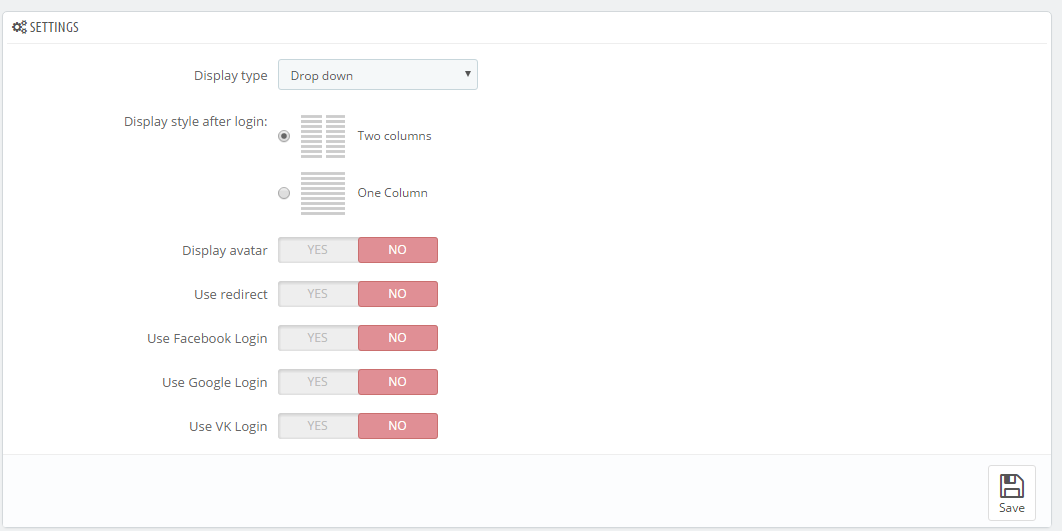
Settings
There are the following settings in the module:
Display type - this setting allows to select the way to display the registration form. It can take the following values:
- Drop down - the form will display as a drop-down below the button opening it.
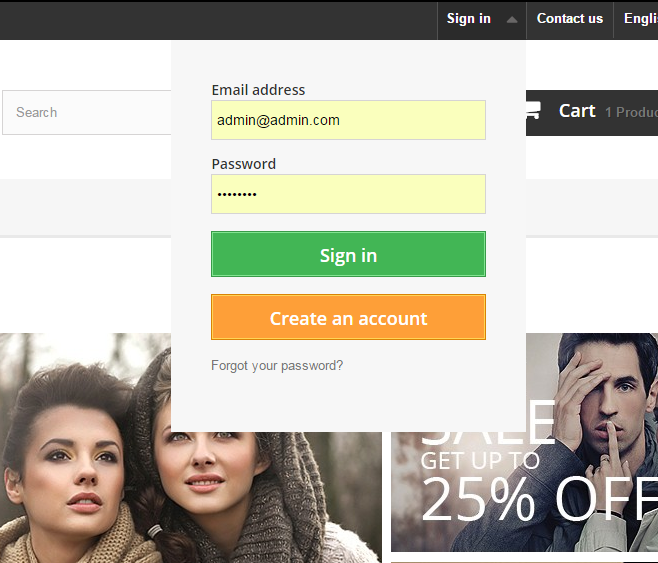
- Popup - the form will appear in a pop-up.
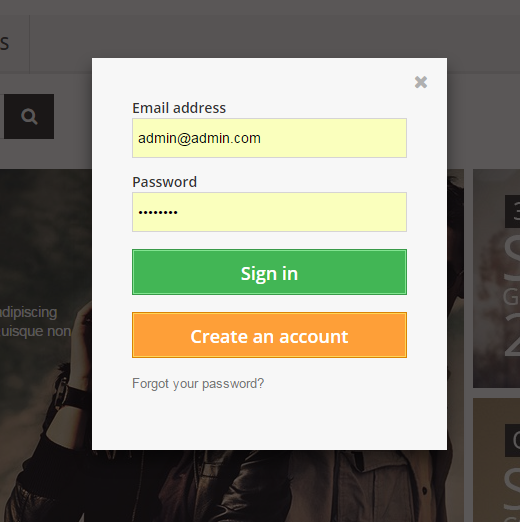
- Left side - the form will appear from the left as a sidebar.
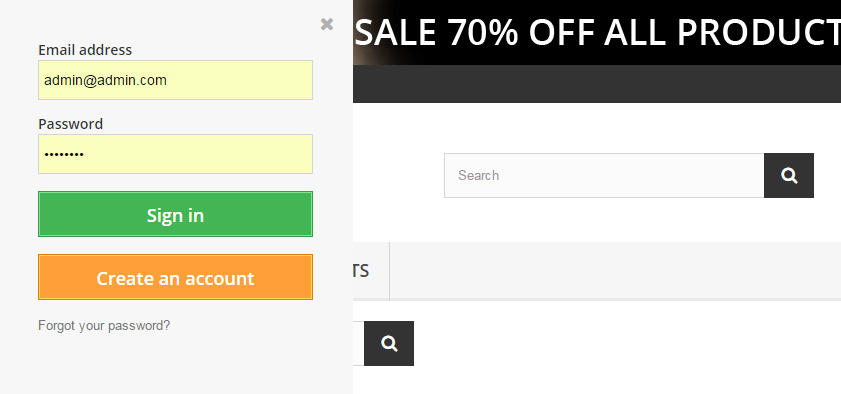
- Right side - the form will appear from the right as a sidebar.
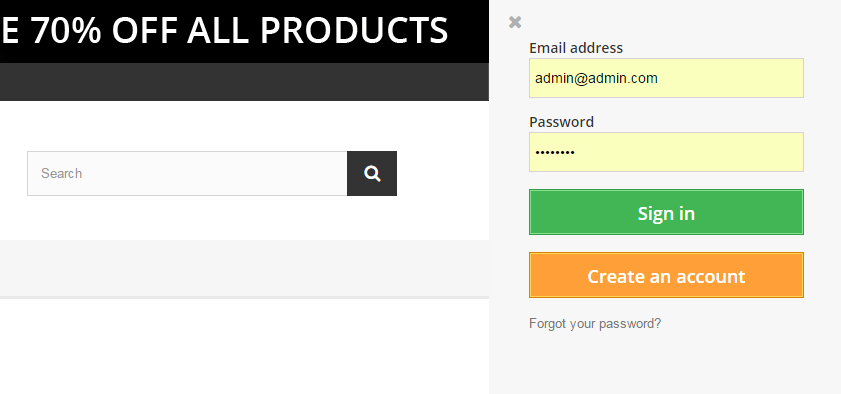
- Drop down - the form will display as a drop-down below the button opening it.
Display style after login - this setting allows to change the form view after login/registration. You can use the following values:
- Two columns - the list is divided into two columns.
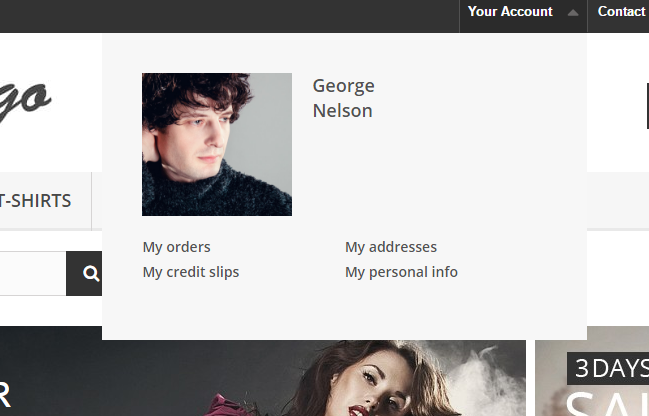
- One Column - the list of links is displayed as one column.
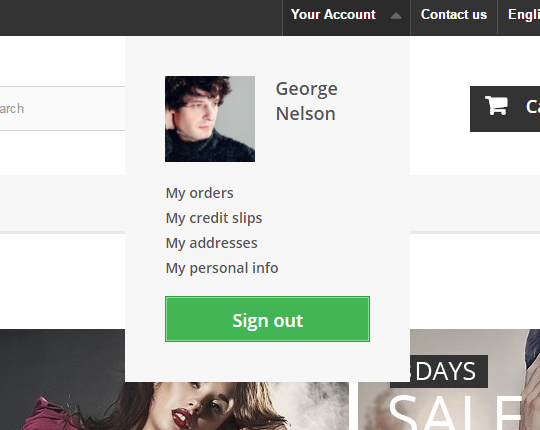
- Two columns - the list is divided into two columns.
- Default avatar - this field appears only if the 'Display avatar' option is enabled. Here you can select the default user avatar.
- Display avatar - this setting allows to enable or disable user avatar. If the user logs in to the account on the website with the help of one of the social networks, the avatar will be taken from the account in this social network, otherwise, the avatar, loaded by the website admin, will be displayed.
- Use redirect - if this setting is enabled, user registration and password recovery will take place on the default PrestaShop registration/password recovery page.
Use Facebook Login - this setting allows to enable user registration and login with the help of Facebook social network. When you enable this option, you will see the following settings:
- App ID - your account App ID from the Facebook developer account.
- App Secret - your app secret from the Facebook developer account.
Use Google Login - this setting allows to enable user login and registration with the help of Google+ social network. If you enable this option, you will see the following settings:
- App ID - your App id from the Google developer account.
- App Secret - your App secret from the Google developer account.
- Redirect URIs - your online-store url + index.php?fc=module&module=tmheaderaccount&controller=googlelogin
Use VK Login - this setting allows to enable user registration and login with the help of VK social network. If you enable this option, you will see the following settings:
- App ID - your App id from your VK developer account.
- App Secret - App secret from your VK developer account.
- Redirect URIs - your online-store url + index.php?fc=module&module=tmheaderaccount&controller=vk
Registering apps in social networks:
- Facebook - to get App ID and App Secret, register your app at https://developers.facebook.com/apps.
- Google+ - to get App ID and App Secret, register your app at https://developers.google.com/accounts/docs/OAuth2/.
- VK - to get App ID and App Secret register your app at https://vk.com/dev.
TM Homepage Category Gallery
Available in:
Fashion, Electronics, Spare Parts, Furniture
The module displays a category gallery on your store Homepage.
It should look something like this:

Here are the main parts of the Category Gallery item, which are marked on the screenshot:
- 1 - HTML content
- 2 - category name
- 3 - category description
- 4 - button
Customization details you can find below in 'Module configuration' section.
Module Installation
The module can be installed and deleted like any other PrestaShop module.
Module configuration
-
After you have installed TM Homepage Category Gallery module, you can configure it clicking the corresponding button (1).
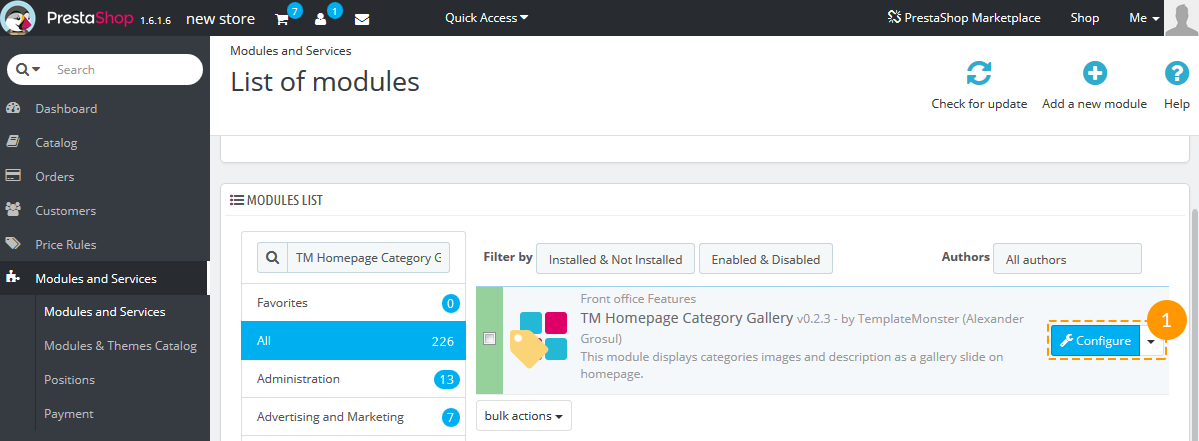
-
On the Configuration page you'll see the list of items in this module. You can edit the existing ones (1) or add new item (2).
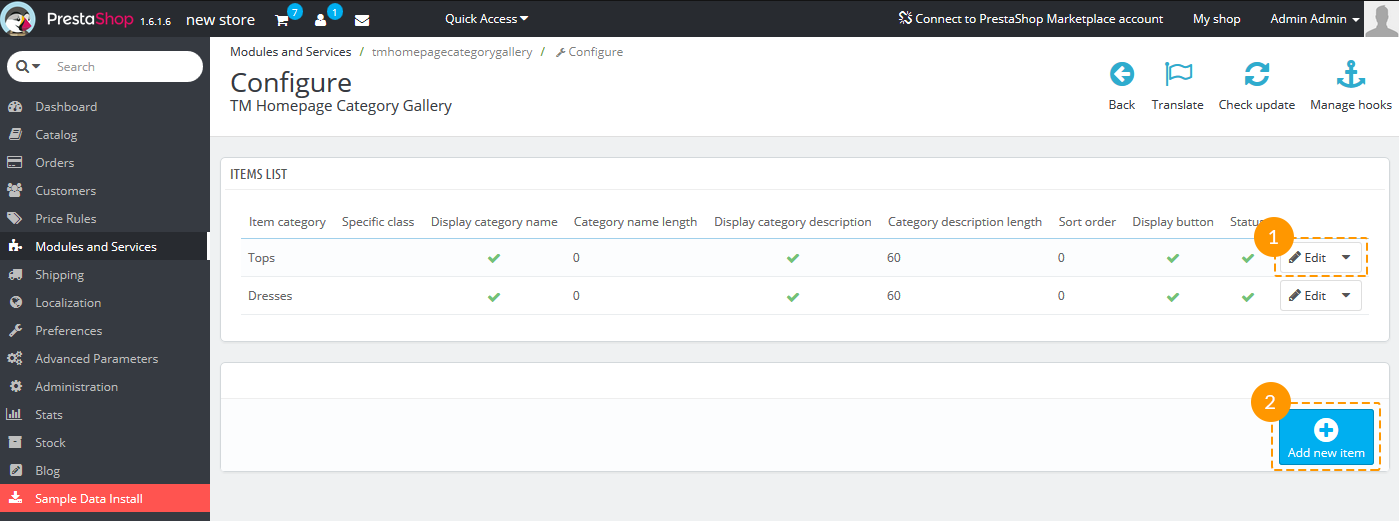
Adding/Editing item options
When you add new item to the module (or edit the one from the list of items), you have some options to choose. The detailed description of options you can see below the screenshot. After all options are set, click 'Save' button (1).
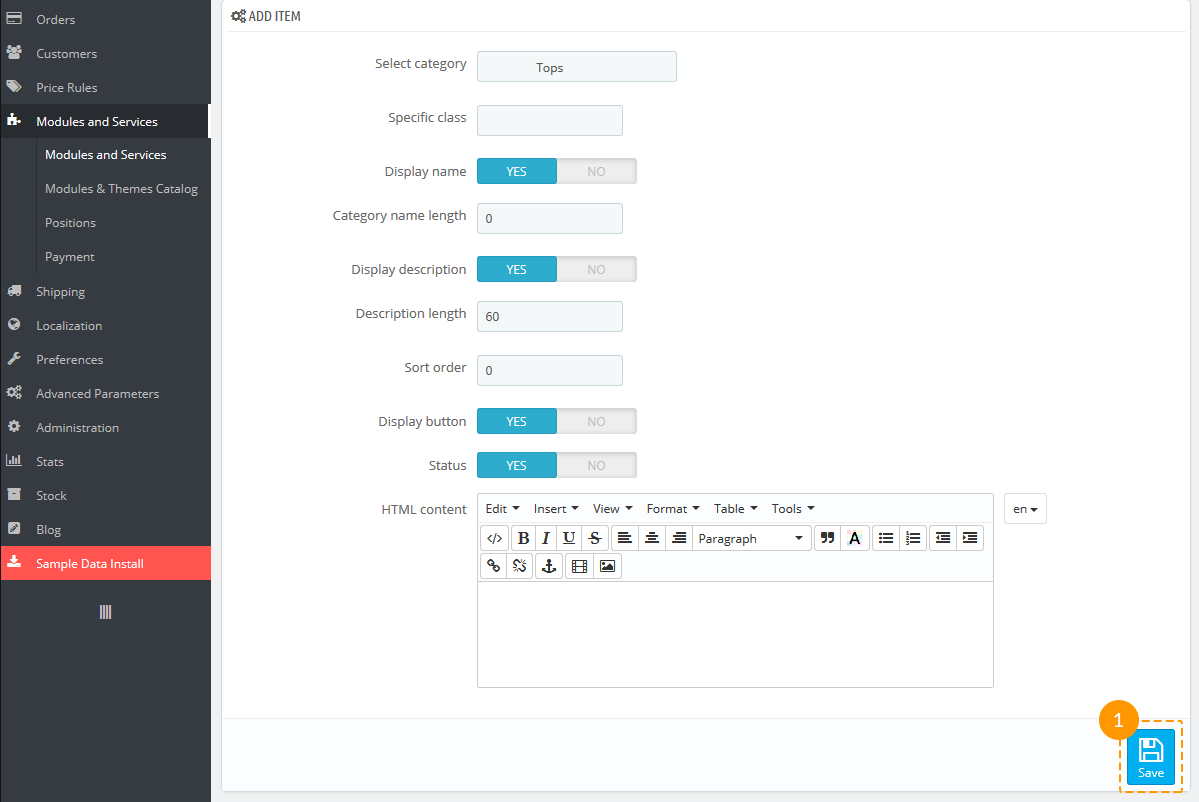
- Select category - here you choose from the dropdown list the category which should be displayed on your page.
- Specific class - the specific class can be added to the module item.
- Display name - option to show or hide the category name.
- Category name length - maximum number of symbols to be displayed in the category name. If the name is longer - the '..' symbol will be added after the number of symbols that has been set.
- Display description - option to show or hide the category description.
- Description length - maximum number of symbols to be displayed in the decription. If the decription is longer - the '..' symbol will be added after the number of symbols that has been set.
- Sort order - the order of item in the category gallery.
- Display button - the option to show or hide the button 'Shop now' (button text can be different depending on the template).
- Status - the option to show or hide the category
- HTML content - the field where some HTML content can be added.
TM Homepage Combinations
Available in:
One Product
This module shows the selected product combinations in following positions available: top (displayTop), home (displayHome), left (displayLeftColumn), right (displayRightColumn).
TM Homepage Combinations Main Panel
This is the main module panel that allows you to add, edit and delete items. In order to create new item, press 'Add new item' button (1) in main panel menu.

Fill in the pop-up form fields.

- Product - select the product.
- Hook - choose item position.
- Title - specify item title.
- Title status - in case this option is disabled, item title won't be shown.
- Item status - if this option is disabled, item will not appear in its position.
- Sort order - item sorting order.
Press on 'Save & Stay' button when all fields are filled in. Wait until page reloads and press on 'Add new combination'.
Choose the required combination from the list and click the 'Add' button (1).
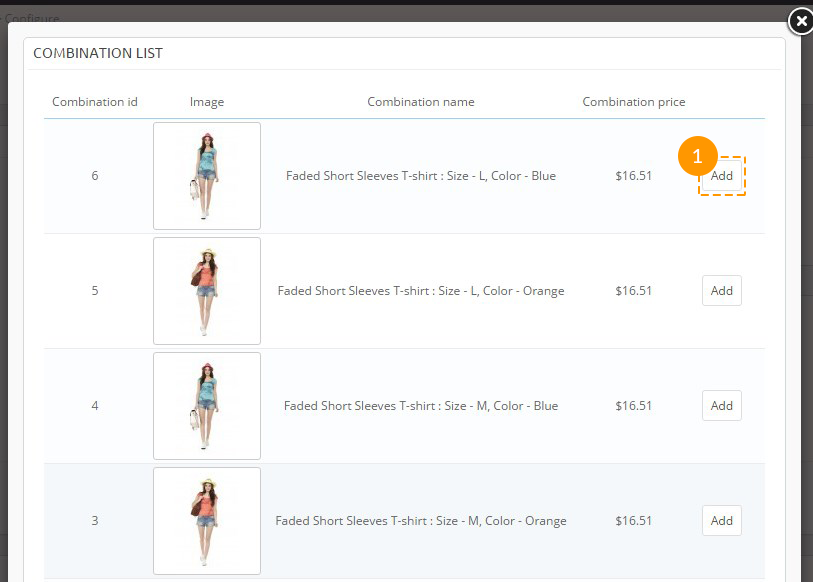
Fill in the required fields in the form that appears.
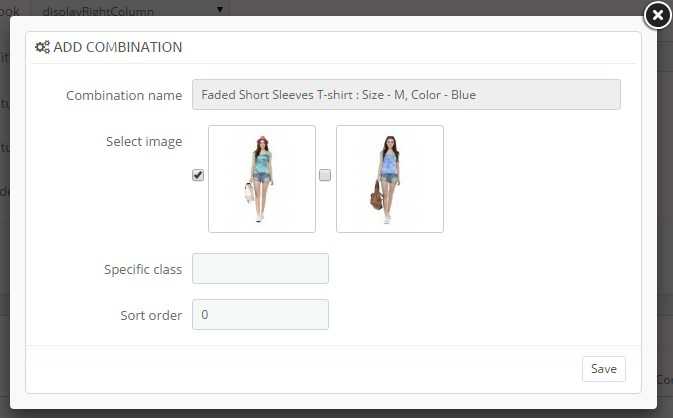
- Select image - choose the desired image.
- Specific class - custom class, defines item styling (CSS class).
- Sort order - item sorting order.
Press 'Save' button when all fields are filled in.
After creating a couple of active combinations, the list of available combinations will appear the following way.
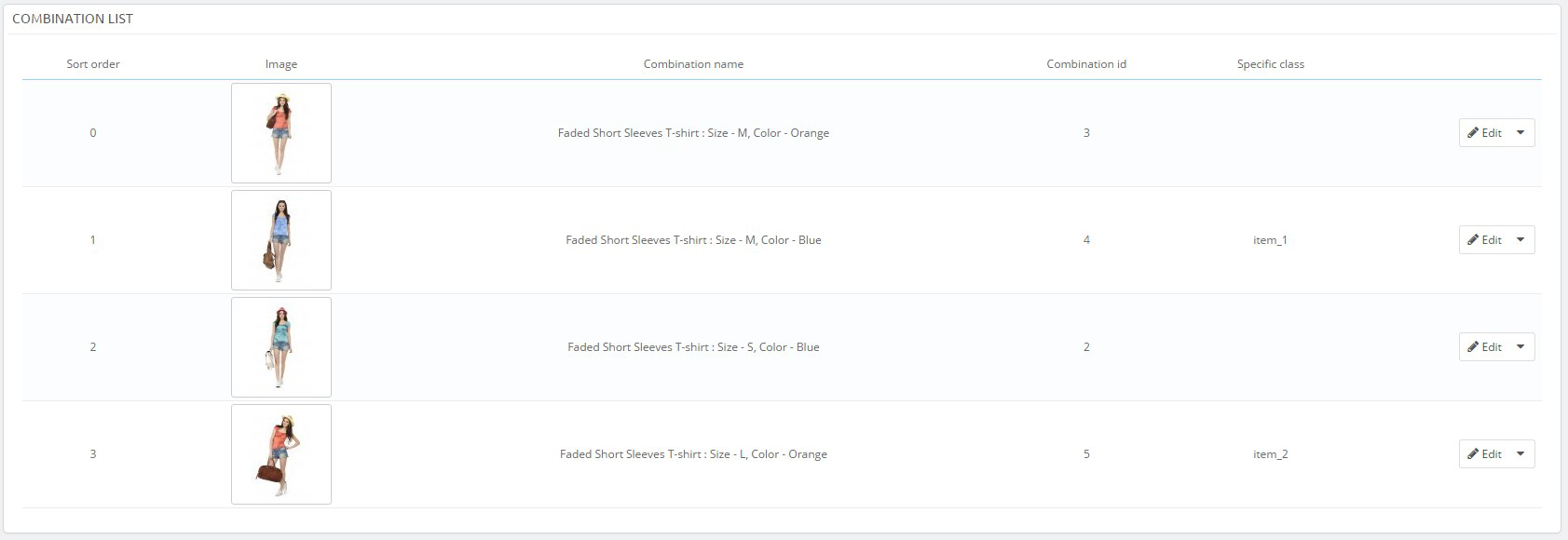
Press 'Save' button (1) on item form when you add all of combinations.

Item will appear the following way on main module panel:

And the following block will be displayed in the selected hook.
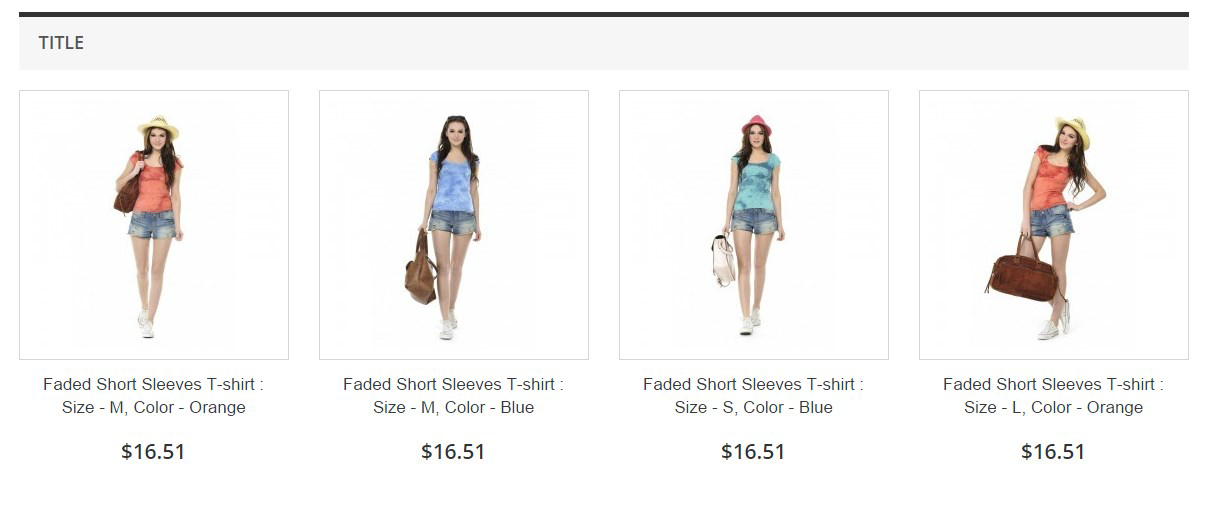
TM HTML Content
Available in:
Fashion, Electronics, Spare Parts, Furniture, One Product
This module allows to display any content (image, HTML, links, etc.) in the following positions: displayNav, home, top, topColumn, left and right (displayLeftColumn/displayRightColumn), footer. It is used to expand design opportunities and add advertisement/information blocks to your store. It is a multilanguage module and can also work in the multistore website.
To add the content, you should follow the steps below:
Navigate to Modules -> Front Office Features -> TM HTML Content (if it is not installed, install it).
- Click 'Add new' button.
- The list of available languages. You can view the available elements for all languages by switching the language tabs.
- The list of elements added for specific position and language.
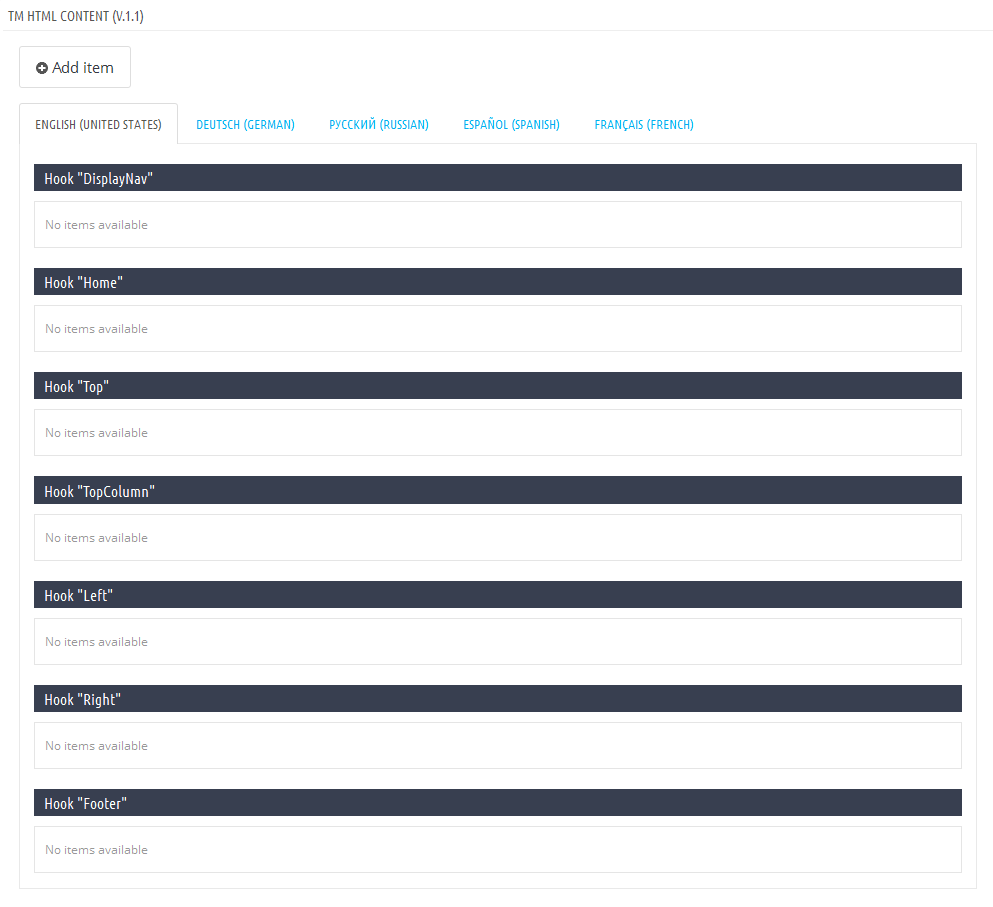
Adding the element. Click Add item button and fill in the required settings (none of the fields are mandatory).
All elements of one language added to the same position will be displayed as a list at the backend and frontend.
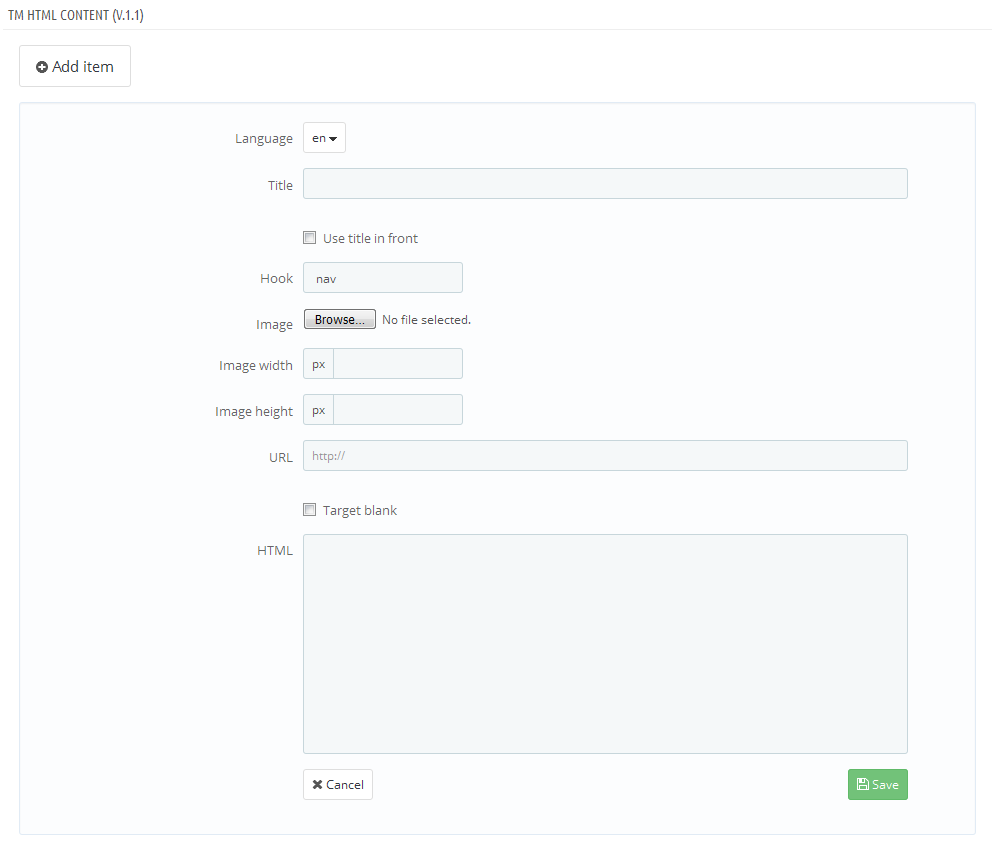
-
- Language
- select the required language from the drop-down list.
-
- Title
- title of the element.
-
- Use title in front
- display the title of the element at the frontend (the title will show up in front of the element).
-
- Hook
- position where the element is added.
-
- Image
- upload the image from your computer.
-
- Image width
- image width shown at the frontend.
-
- Image height
- image height shown at the frontend.
-
- URL
- add the link (the whole block will be wrapped in the link).
-
- Target blank
- open link in new tab.
-
- HTML
- HTML code (except the link if you have added it in the URL field) or text.
-
- Save
- click to save the element.
Editing and removing the element
When you add the element, it shows up in the corresponding list.
- The language where the elements were added.
- Position where the elements were added.
- Edit button with the drop-down list.
- Delete button.

Editing
Click Edit button to modify the element.
In the appeared screen change all the required fields.
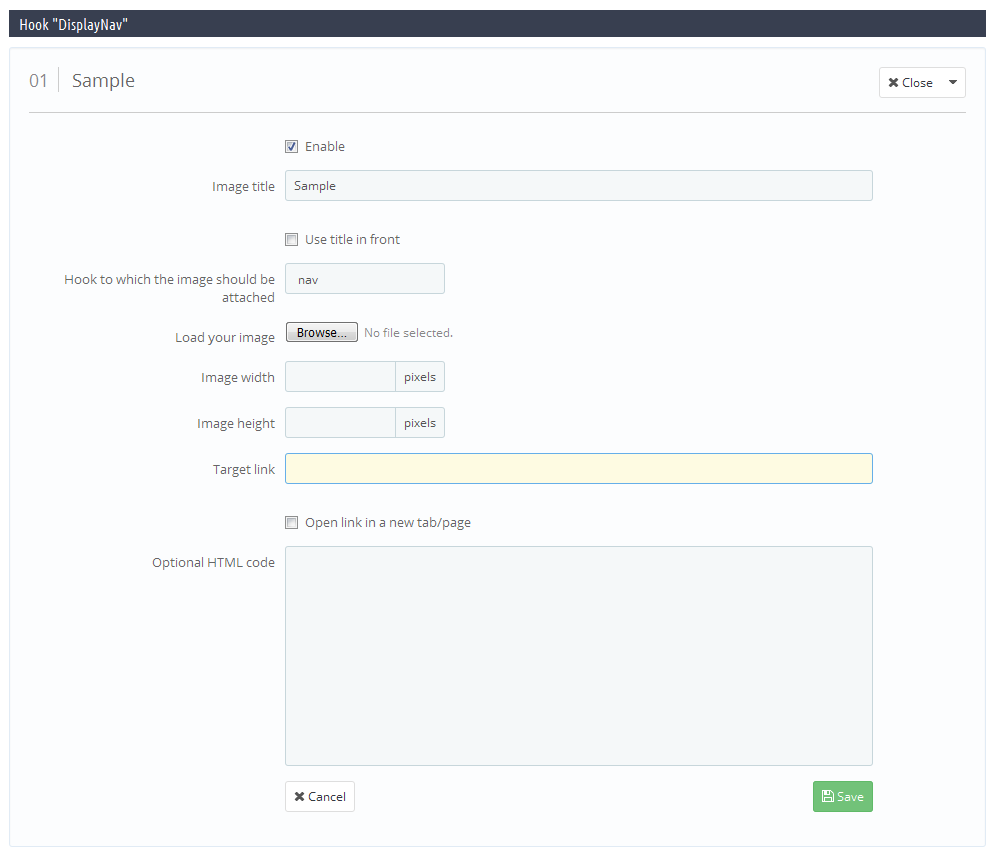
-
- Enable
- display the element at the frontend.
-
- Image title
- title of the element.
-
- Use title in front
- show up title at the frontend.
-
- Hook to which the image should be attached
- position of the element.
-
- Load your image
- image of the element.
-
- Image width
- image width at the frontend.
-
- Image height
- image height at the frontend.
-
- Target link
- assign link to the element.
-
- Open link in a new tab/page
- Open link in new tab.
-
- Optional HTML code
- edit HTML code.
-
- Save
- save changes.
Changing order of elements in the list

To change the order of elements, you should just drag the element to the position you need.


TM Look Book
Available in:
Fashion, Furniture
Requirements:
This module allows to create lookbooks and combine them to collections. In their turn, lookbooks allow to view the products directly on the model. Also, if a product is marked in the lookbook, the module displays the lookbook link on the product page.
- PHP 5.4+
- PrestaShop 1.6
TM Look Book Main panel
On the main page of the module, you can delete and edit the module collections.

Adding and editing the collection
Collections allow to combine several lookbooks on one page. To add a collection, follow the next steps.
-
In the collections table (the main module panel) click on the plus (1).

-
You will see a form with the next fields:
- Status - this option allows to disable or enable the collection display on the collections page.
- Name - the name of the collection that will be displayed on the collections page.
- Description - the collection description.
- Image - the main collection image.
- Template - the template for the lookbooks of this collection. When you select a template, you select the way the lookbooks of this collection will be displayed on the page.
-
After having filled all the fields, press the 'Save' (2) button.
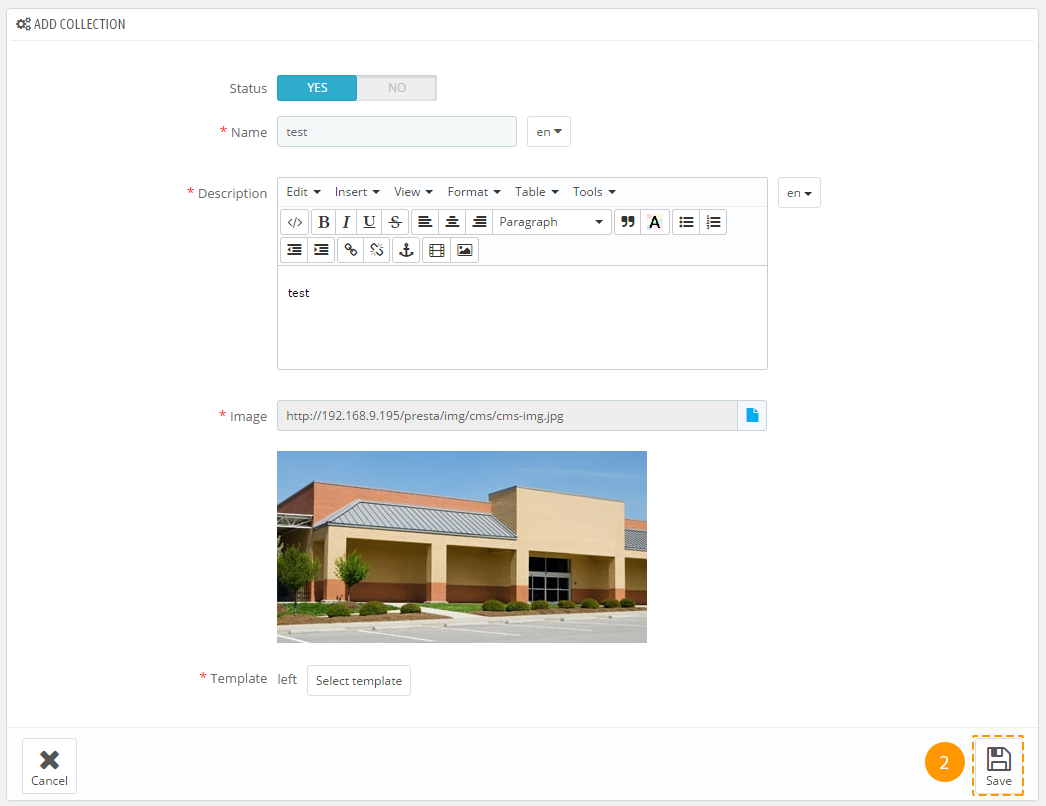
-
The collection has been created. You can edit it by pressing the 'Edit' (3) button, or you can proceed to the next step and create lookbooks for the collection.

Creating and editing lookbooks
-
After creating a lookbook, press the 'View' (1) button next to the needed collection.

-
In the appeared block press the '+' button (2).

-
You'll see a form with the following options:
- Status - the lookbook status, the option defines whether the lookbook will be displayed.
- Name - the name of the look.
- Description - the description of the look.
- Image - the main image of the look, here you can mark the products and descriptions.
-
After filling in all the fields, press the 'Save & Stay' (3) button to continue creating hotspots.
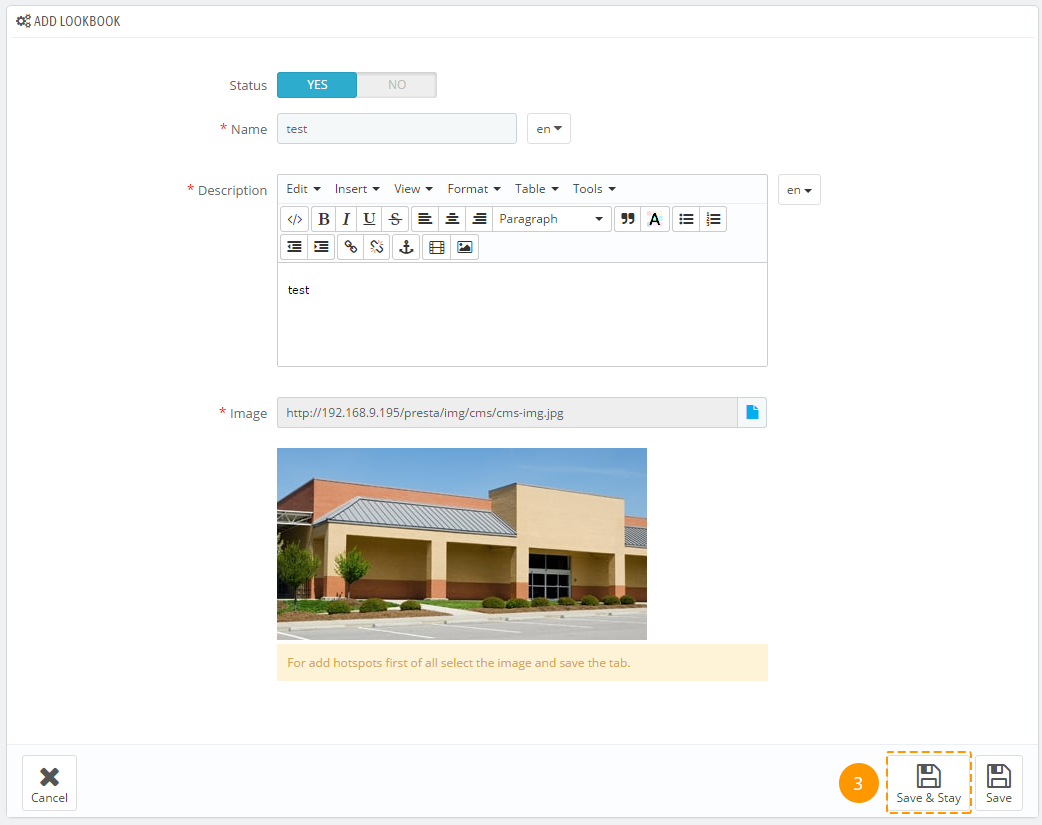
Adding and Editing Hotspots
After having saved the lookbook, you can add the hotspots.
-
Press the image (in the needed point) (1) in the lookbook form.
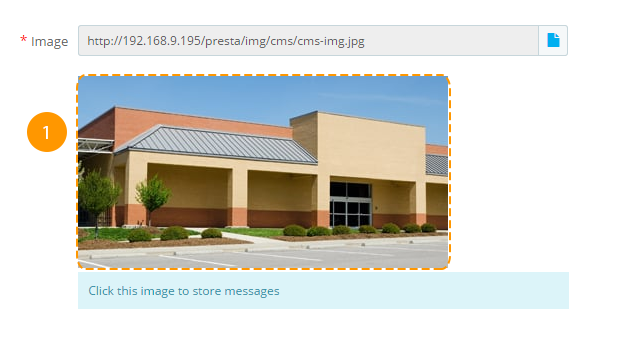
-
You will see a form with the following settings:
- Type - this is the point type, it has two values 'Product' and 'Content'. The product type allows to select a product that will be attached to the point, and content type allows to add content (name, description, html) to the point.
- Product - selecting a product for the point. It appears, if the selected type is 'Product'.
- Name - the name attached to the point. This field is available, only if the type 'Content' is selected.
- Description - the point description or coding. Available only if the type 'Content' is selected.
-
After having selected the needed options, press the 'Save' (2) button, hotspot will be created and displayed on the page.
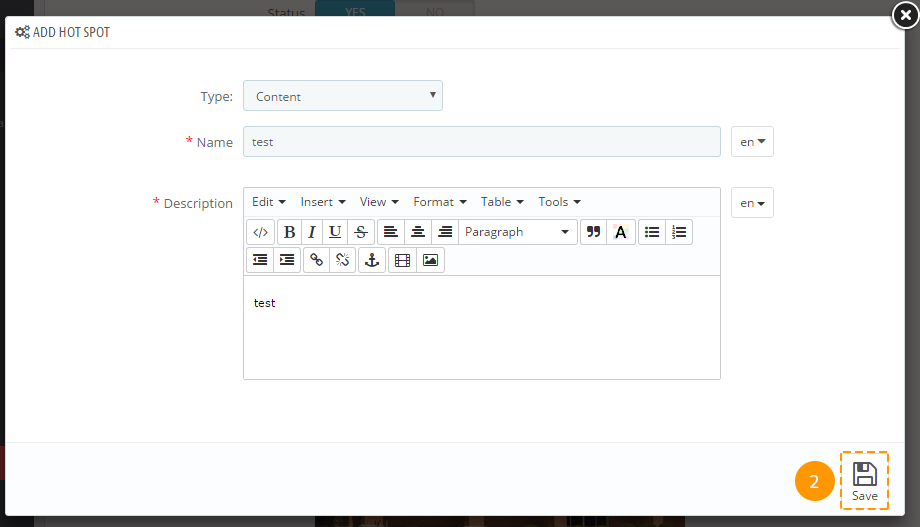
Deleting a hotspot
-
To delete a point, hover over it (1).
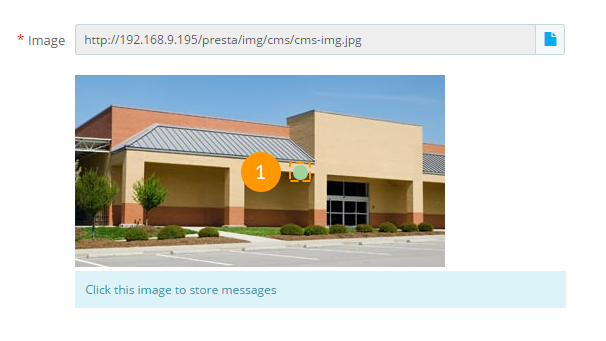
-
You'll see a button with a cross, press it (2).
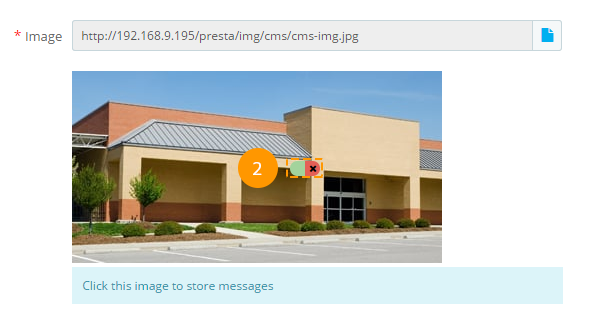
The point is deleted.
Changing the hotspot position
To change the point position, drag and drop it to the needed position.
How to navigate to the collections page?
Navigate to the main module page and press the button (1), you'll see a page with all the collections. You can add the links to the lookbooks to any module that supports custom content.

TM Look Book Homepage
Available in:
Fashion, Furniture
To use the module, you should have the TM Look Book module installed.
TM Look Book Homepage is used to display the TM Look Book module block on the Homepage. This module allows to display both the lookbook covers and lookbook pages.
Requirements:
- PHP 5.4+
- PrestaShop 1.6
- TM Look Book Module
Module features:
- The module can be displayed in 2 positions: displayHome and displayTopColumn.
- TM Look Book Homepage is a child module of TM Look Book, that's why it can't be used without it.
- The module can display the lookbook cover or its pages.
TM Look Book Main Panel
At the module main panel, you can add, delete and edit blocks, that the module will display on the Homepage.
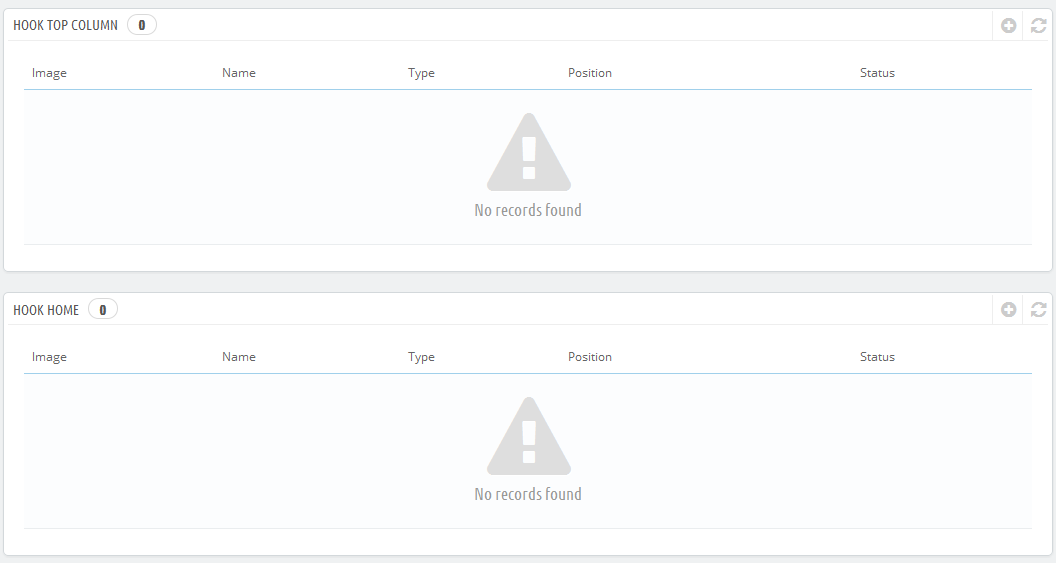
Adding a new block
-
To add a new block, enter the module main panel and click the '+' (1) in the table with the needed hook.
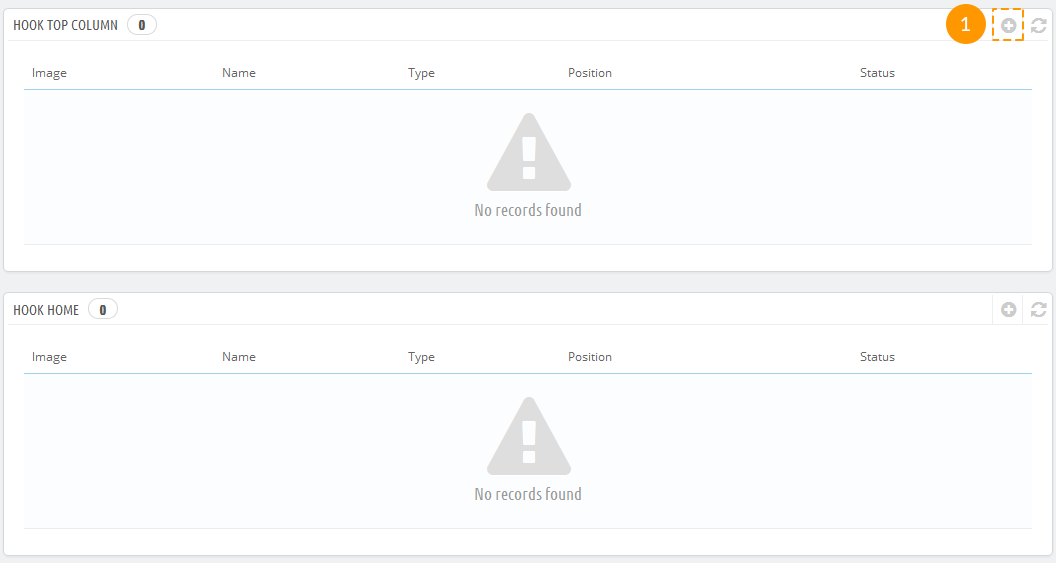
-
In the appeared form, set up the following options:
- Status - the block status. This setting allows to enable or disable the block display.
- Type - allows to select the block type.
- Lookbook - allows to select a previously selected look.
-
After setting up all options, press the 'Save' (2) button.

After the new block is created, it will be displayed on the Homepage.
TM Manufacturers Block
Available in:
Fashion, Electronics, Spare Parts, Furniture
This module shows up manufacturers available in your store. The list of manufacturers may consist of image and title. The list can also show up as a carousel.
Installing and Deleting
The module is installed and deleted like any other Prestashop module.
Module configuration
After installation you can change its settings on the module configuration page.
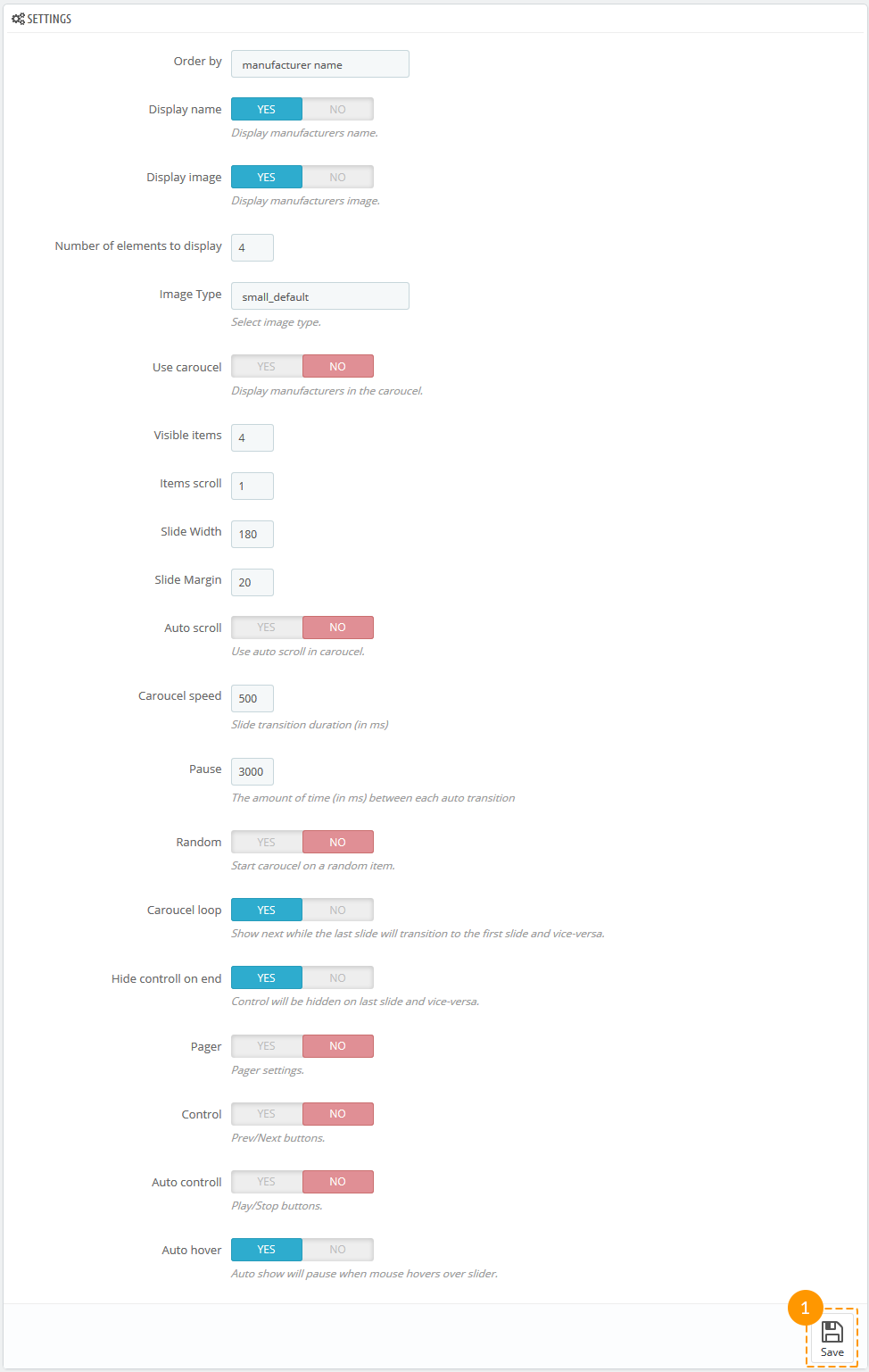
-
- Order by
- type of sorting items of the block.
-
- Display name
- show the manufacturer's name.
-
- Display image
- show the image of the manufacturer.
-
- Number of elements to display
- type the number of elements displayed in the module.
-
- Image Type
- select the image type (you can select the image from the images related to the manufacturer).
-
- Use carousel
- show up the list as a carousel.
-
- * Visible items
- number of visible manufacturers.
-
- * Items scroll
- number of manufacturers shown in one carousel scroll.
-
- * Slide Width
- the width of the element in the carousel.
-
- * Slide Margin
- the margin of the element in the carousel.
-
- * Auto scroll
- automatic scrolling.
-
- * Carousel speed
- speed of the carousel.
-
- * Pause
- pause between scrolls (if "Auto scroll" is enabled).
-
- * Random
- carousel start from the random element.
-
- * Carousel loop
- carousel returns back to the beginning when all elements have been scrolled.
-
- * Hide control on end
- hide next/previous buttons.
-
- * Pager
- show pagination.
-
- * Control
- show next/previous buttons.
-
- * Auto control
- show play/pause buttons.
-
- * Auto hover
- pausing when hovering over carousel elements.
* - settings are available only if carousel is enabled.
After all options have been set, press 'Save' button (1).
The module supports multi-stores.
TM Media Parallax 2.0.0
Available in:
Fashion, Electronics, Spare Parts, Furniture, One Product
If you have the 1.n version of this module installed in your prestashop engine, you are not suggested to update it with the current one. First you need to remove the old version of the module to run without errors.
This module is designed to let you add parallax effect to the DOM items of the page. It allows you to create multi-layered parallax. It also provides a possibility to add a custom background video (you can upload it from your computer to server) or add a YouTube video.
TM Media Parallax Main Panel
Main module panel that allows you to add, edit or remove parallax items.

Creating a new parallax item
In order to create a new parallax item, press 'plus' (1) icon, in the top right corner of the main panel.

Then you will see the following form.
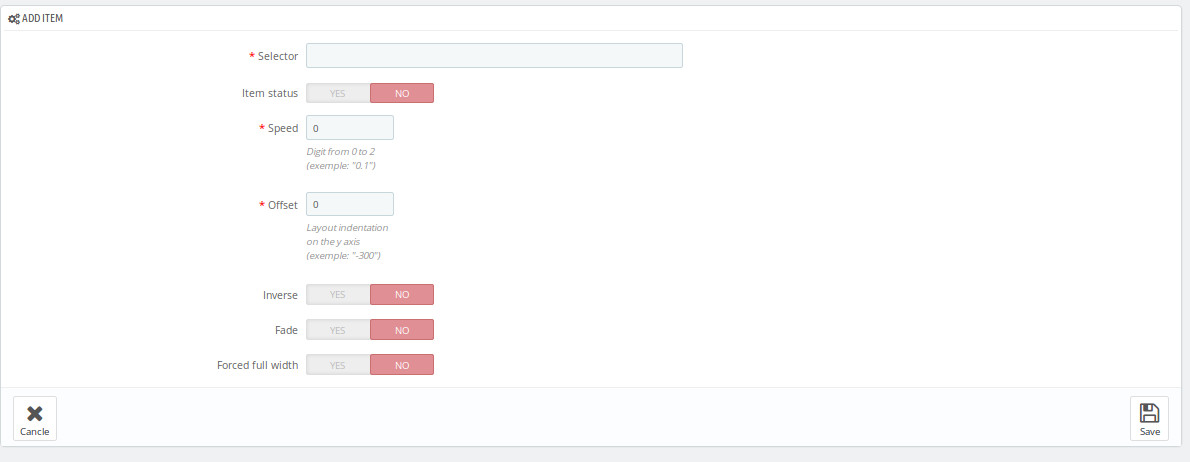
Form options for adding parallax items
- Selector - CSS selector of the item with parallax effect applied. For example, '#header .nav'
- Item status - item status (parallax will not be displayed if it's disabled)
- Speed - digit value from 0 to 2, which defines main parallax block speed
- Offset - main layer indent on the Y axis
- Inverse - parallax direction
- Fade - this option allows to configure main block fade-out on page scroll
- Forced full width - forced full width of the parallax block
Press 'Save' after filling in all the required fields.
Parallax layers list
In order to see the list of parallax layers, you should press 'View' (1) near the main parallax item.

Then you'll see a table, in which the layers are displayed after they are added.

Adding new layer
In order to create a new parallax layer, press 'plus' (1) icon in the top right corner of the layers panel.

Then you will see the following form.
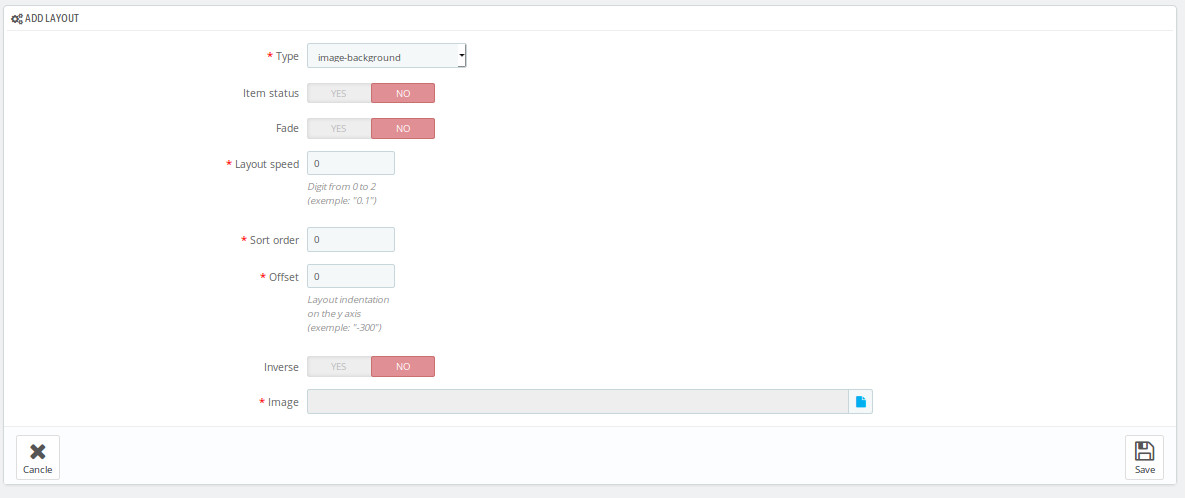
Press 'Save' after filling in all the required fields.
Parallax layers types and their fields
Image-background - image used as a parallax background
- Item status - item status (parallax will not be displayed if it's disabled)
- Layout speed - digit value from 0 to 2, which defines main parallax block speed
- Offset - main layer indent on the Y axis
- Inverse - parallax direction
- Fade - this option allows to configure main block fade-out on page scroll
- Image - link to an image, to which parallax effect will be applied
- Sort order - layout position, relative to the rest of items
Video-background - video used as a parallax background
- Item status - item status (parallax will not be displayed if it's disabled)
- Layout speed - digit value from 0 to 2, which defines main parallax block speed
- Offset - main layer indent on the Y axis
- Inverse - parallax direction
- Fade - this option allows to configure main block fade-out on page scroll
- Image - link to an additional image
- Video parallax mp4 - video in mp4 format
- Video parallax webm - video in webm format
- Sort order - layout position, relative to the rest of items
Text - text layer which position can be defined with CSS
- Item status - item status (parallax will not be displayed if it's disabled)
- Layout speed - digit value from 0 to 2, which defines main parallax block speed
- Offset - main layer indent on the Y axis
- Inverse - parallax direction
- Fade - this option allows to configure main block fade-out on page scroll
- Content - layer content
- Specific class - custom CSS class for this layer
- Sort order - layout position, relative to the rest of items
Youtube-background - YouTube video used as a parallax background
- Item status - item status (parallax will not be displayed if it's disabled)
- Layout speed - digit value from 0 to 2, which defines main parallax block speed
- Offset - main layer indent on the Y axis
- Inverse - parallax direction
- Fade - this option allows to configure main block fade-out on page scroll
- Video id - YouTube video ID
- Sort order - layout position, relative to the rest of items
Image - image layer which position can be defined with CSS
- Item status - item status (parallax will not be displayed if it's disabled)
- Layout speed - digit value from 0 to 2, which defines main parallax block speed
- Offset - main layer indent on the Y axis
- Inverse - parallax direction
- Fade - this option allows to configure main block fade-out on page scroll
- Image - link to an image, to which parallax effect will be applied
- Specific class - custom CSS class for this layer
- Sort order - layout position, relative to the rest of items
Uploading video and images to server
In order to upload video or an image to server via File Manager, first you need to press 'file' (1) icon next to the needed field.

In the following window, in the 'actions' line, choose 'upload' (2).

Then you'll see one more pop-up window, to upload image or video file here.
Warnings and recommendations
- Mobile devices (smartphones, tablets) have parallax effect disabled by default, the uppermost block image layer is used as a background instead
- Forced full width of the parallax block affects page loading speed more critically than a regular fullwidth block loading
- The smaller the size of the uploaded video, the better.
TM Mega Menu
Available in:
Fashion, Electronics, Spare Parts, Furniture
The module is designed to create complex menus. The module provides the ability to display one item (without sub-menu), a menu item with a sub-menu and a menu item with sub-menu by means of a multi-row and multi-column block. The module can be used in different positions, but it will display the same content. Available positions: top (displayTop), left (displayLeftColumn), right (displayRightColumn), footer (displayFooter). You can add categories (with subcategories), CMS categories (with subcategories), manufacturers (one or a list), suppliers (one or a list), stores (if multistore is used), links to any product, information block about the product, custom links (not limited in quantity), custom HTML blocks (not limited in number) and banners. See below for more details.
The module includes 6 main tabs that allow to customize the menu.

TM Mega Menu Items
TM Mega Menu items are the basic items which appears in the menu.
In order to create a new item, open the TM Mega Menu module and click Add item button from the top menu or click "+" button in the top right of the table.
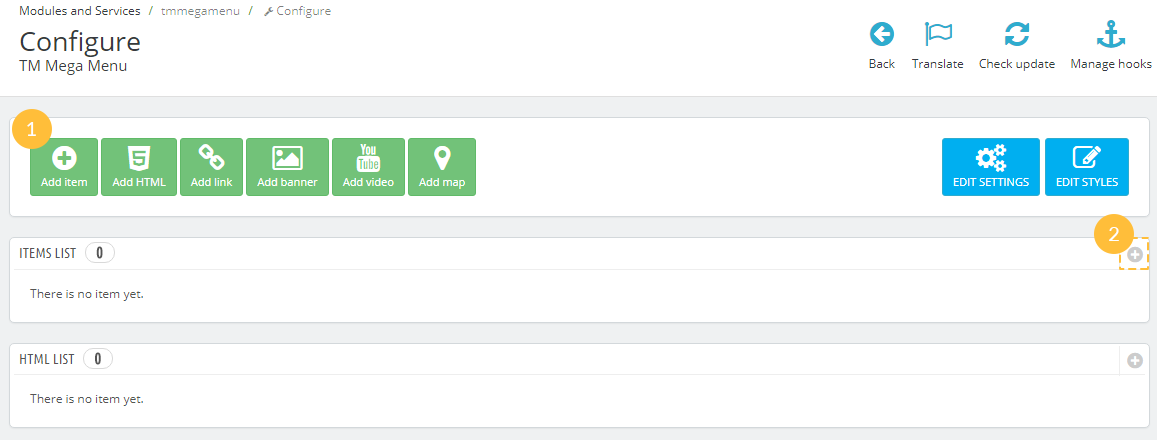
In the form that appears, fill in the required fields.
-
- Enter item name
- the tab title which is mandatory to be filled in for the default language, if the additional languages fields are not filled in, the tab takes its name from the default language.
-
- Active
- active/inactive tab.
-
- Link
- a link that is assigned to this tab. You can enter a custom link, or choose from existing options (categories, CMS categories). If you leave the field blank, the link of this tab is inactive.
-
- Sort order
- the order of tabs to be displayed.
-
- Specific Class
- the class which is added to emphasize the item (CSS class).
-
- Enter item badge
- is filled in depending on multi-languages.
-
- It is Mega Menu
- given tab sub-menu is a Mega Menu. *
-
- Use simple menu
- given tab sub-menu is a simple menu. **
* It is Mega Menu. If this option is selected, there will be a form to create a complex menu (Mega Menu).
** Use simple menu. If this option is selected, there will be a form to create a simple menu. This is a menu that displays the selected content in a single column. If the menu has embedded content, the new column is added.
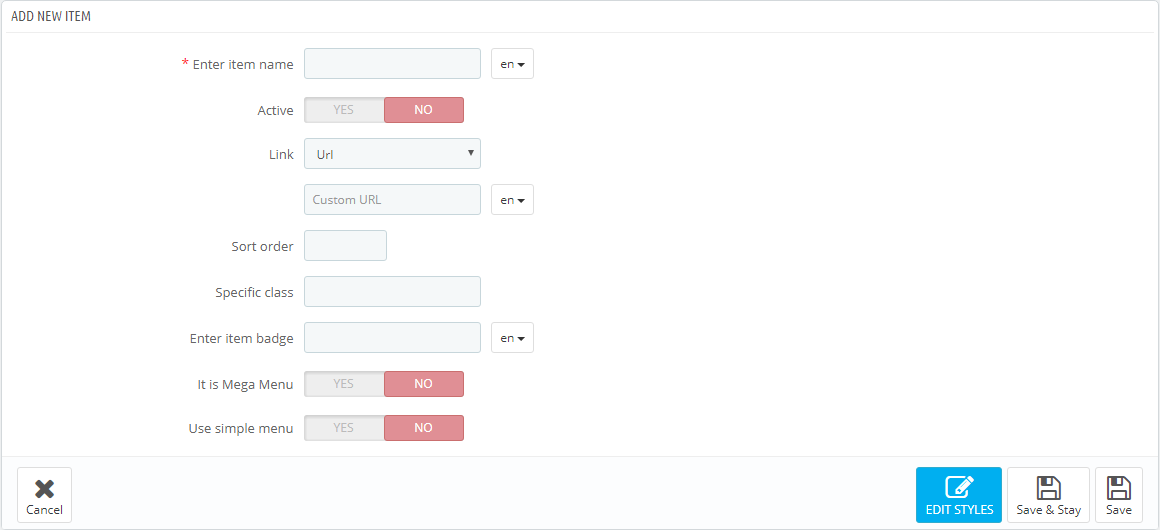
Complex menu consists of rows and columns in rows.
The Row is a part of the Mega Menu structure. It includes the menu columns. The existing row can be removed by clicking the appropriate button. The row will be removed with the content it includes. The rows quantity is not limited.
The Column is a part of the Mega Menu structure, which is placed inside the rows. (The Class) The width of the column cannot be less than 2 and more than 12. In order to make the menu display properly, the total column width cannot exceed 12. The width (class) is a Bootstrap column type, corresponds to the same values.
In order to create the menu, click the 'Add row' button.
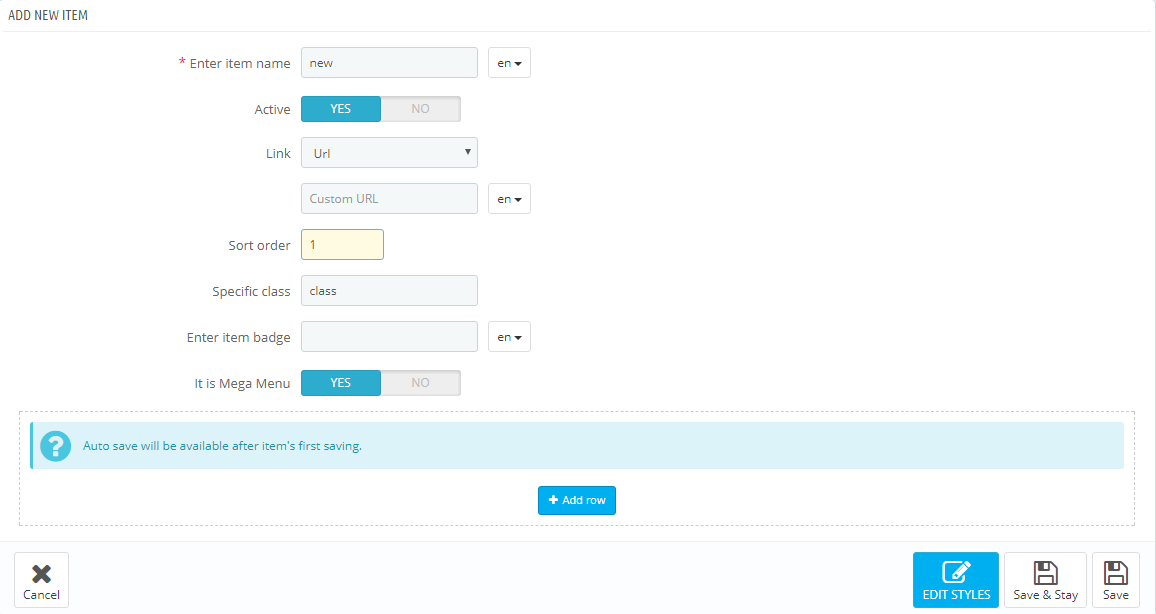
In the form appeared, click 'Add column' button.

In the pop up window you need to specify the column class (from 2 to 12). The column itself appears next where you need to set the required settings.
Here you can change the column class, CSS class and the content from the list provided. You can add/remove content by double clicking the item, or by highlighting the items and clicking the corresponding button.
Block can be removed by clicking 'Remove block' button in the footer of the block.
By removing the row, the included columns are also removed.
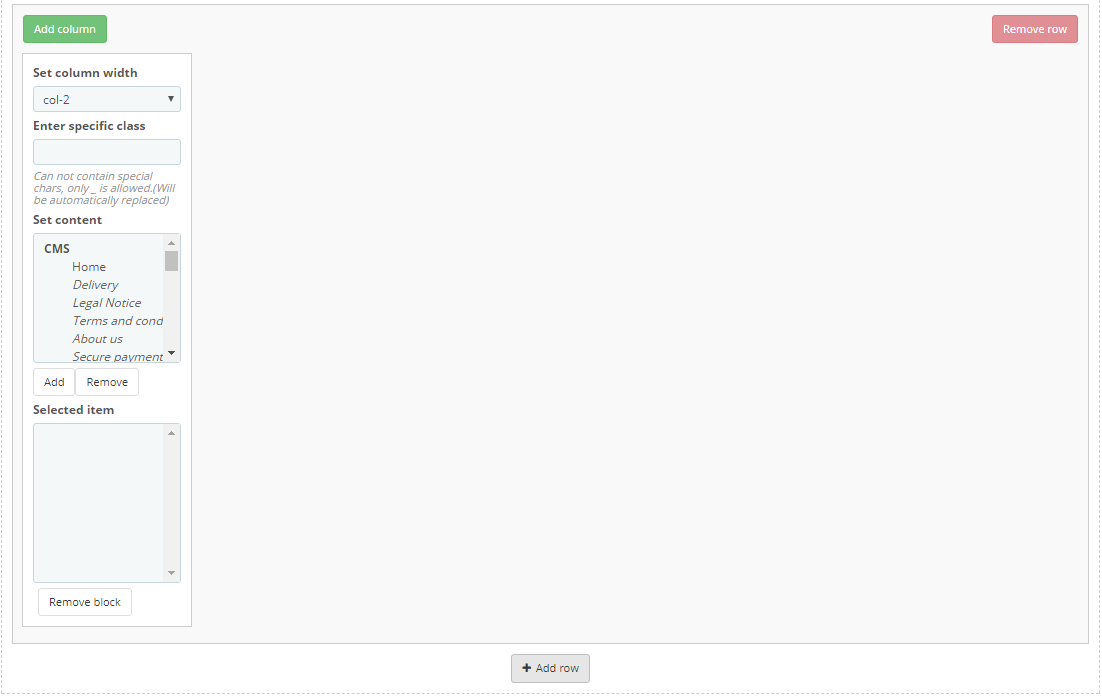
In order to move the content available in the selected menu, double-click or highlight the desired content and press the corresponding button.
Inactive menu information is saved while switching between menu types and you can always change the type of menu.
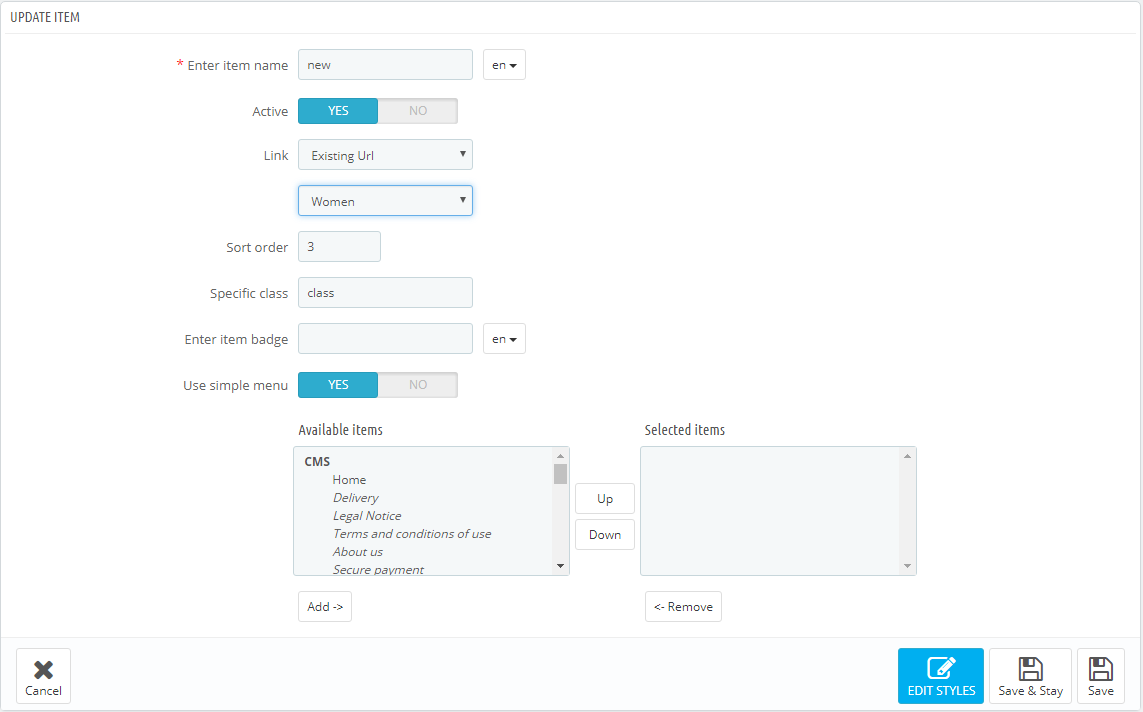
TM Mega Menu HTML
In this section we will explain how to create a custom HTML block in the Mega Menu.
The module has a table listing all the available blocks. You can also add a new block by clicking the '+' button in the top right of the table.
In the form that appears, fill in the required fields.
-
- Enter HTML item name
- HTML block name, is mandatory to be filled in for the default language.
-
- Specific class
- block's CSS class.
-
- HTML content
- HTML content.
Added block will appear in the list of blocks, as well as in the list of available content while creating menu blocks.
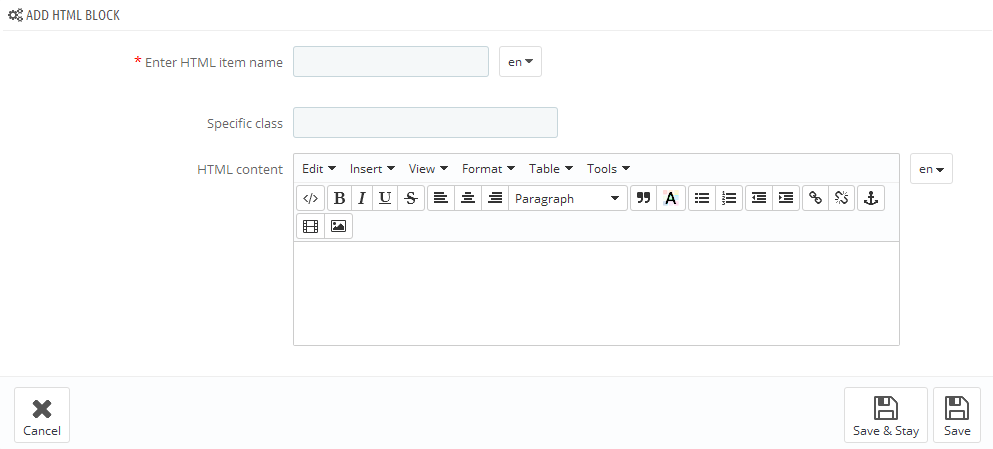
TM Mega Menu Links
In this section we will show how to create custom links in the Mega Menu.
The module has a table listing all the available links. You can also add a new link by clicking the '+' button in the top right of the table.
In the form that appears, fill in the required fields.
-
- Enter Link name
- link name, is mandatory to be filled in for the default language.
-
- Enter Link URL
- link URL, is mandatory to be filled in for the default language.
-
- Specific class
- block's CSS class.
-
- Open in new window
- open link in a new window.
Added link will appear in the list of links, as well as in the list of available content while creating menu blocks.

TM Mega Menu Banners
In this section we will explain how to create banners in the Mega Menu.
The module has a table listing all the available banners. You can also add a new banner by clicking the '+' button in the top right of the table.
In the form that appears, fill in the required fields.
-
- Select a file
- select a file, is mandatory to be filled in for the default language.
-
- Enter Banner name
- banner title, is mandatory to be filled in for the default language.
-
- Enter Banner URL
- link URL, is mandatory to be filled in for the default language.
-
- Specific class
- block's CSS class.
-
- Public Title
- public banner title.
-
- Description
- set the description of the banner.
-
- Open in new window
- open link in a new window.
Added banner will appear in the list of banners, as well as in the list of available content while creating menu blocks.
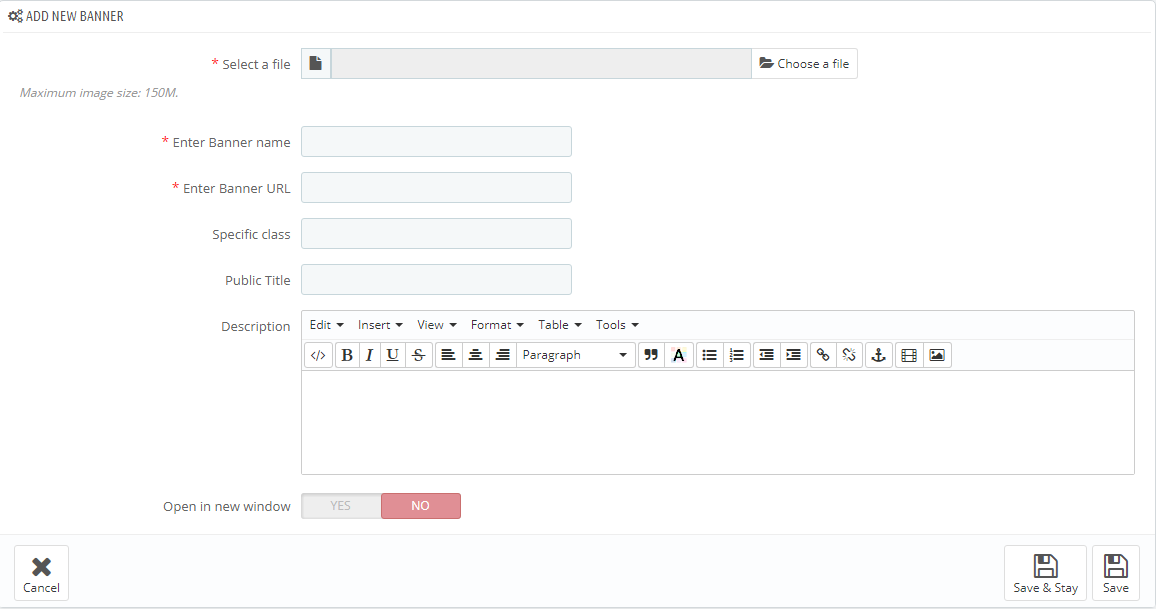
TM Mega Menu Video
In this section we will explain how to add a video in the Mega Menu.
The module has a table listing all the available videos. You can also add a new video by clicking the '+' button in the top right of the table.
In the form that appears, fill in the required fields.
-
- Enter Video Name
- video title (the field is required).
- Enter Video URL - add video link in the formats described below:
- If this is a YouTube video, click on Embed and copy the code between the quotes for https://www.youtube.com/embed/video_id
- If this is a Vimeo video, click on Share icon and in the Embed section copy the source code between the quotes for http://player.vimeo.com/video/video_id
Added video will appear in the list of videos, as well as in the list of available content while creating menu blocks.

TM Mega Menu Map
In this section we will explain how to add a map in the Mega Menu.
The module has a table listing all the available maps. You can also add a new map by clicking the '+' button in the top right of the table.
In the form that appears, fill in the required fields.
-
- Enter Map item name
- the title of the map.
-
- Enter Map latitude
- set a latitude value.
-
- Enter Map longitude
- set a longitude value.
-
- Marker
- adding a custom marker.
-
- Enter Map scale
- the scale of the map (used 8 by default).
-
- Map description
- set the description of the map.
Added map will appear in the list of maps, as well as in the list of available content while creating menu blocks.
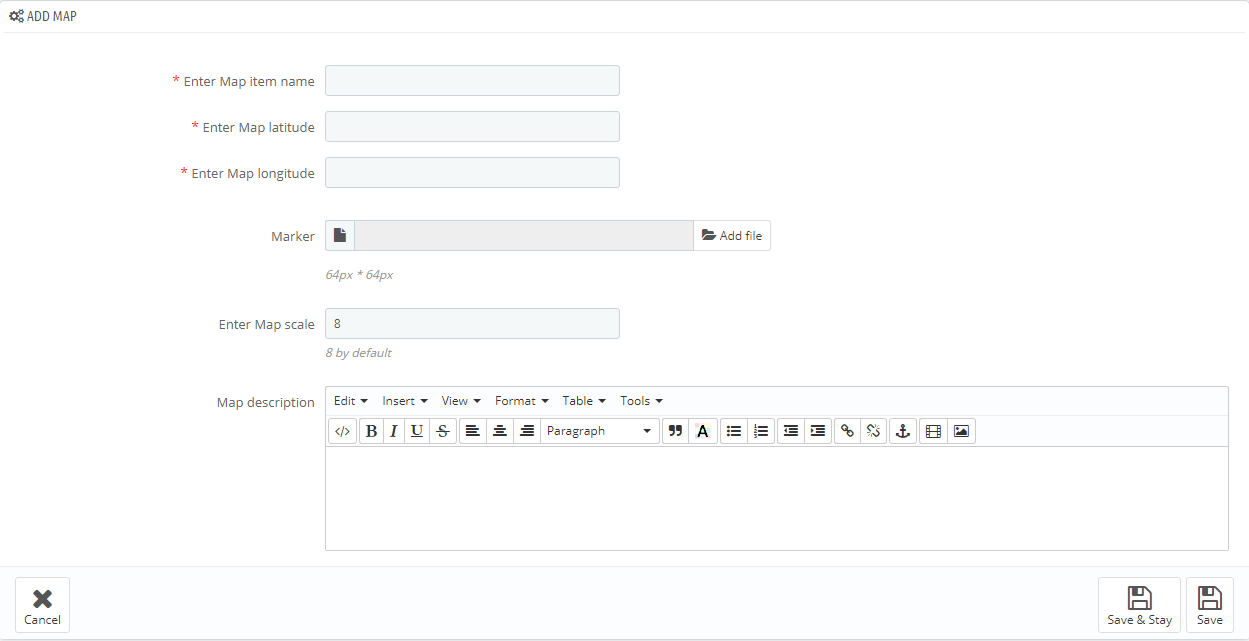
TM Mosaic Products
Available in:
Fashion, Electronics, Spare Parts, Furniture, One Product
This module allows you to display categories with products, banners, video (Youtube, Vimeo and custom video), HTML content, various sliders with different number of slides and dimensions in any row on the site home page.
Installation and Deleting
The module is installed and deleted like any other PrestaShop module.
Module settings
After module has been installed, you can add the required blocks with category products, previously added banners, video and HTML content.

Adding/removing/editing Blocks
In order to add a new category, press the "Add new" button.
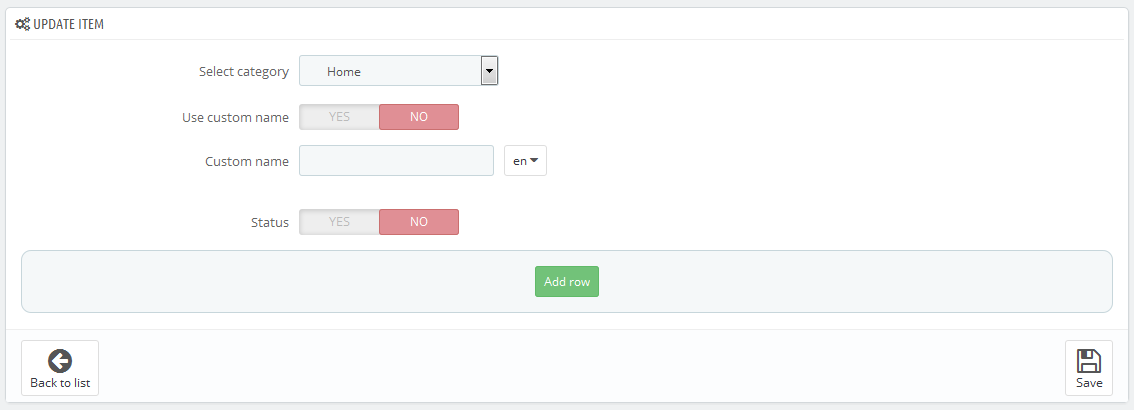
- Select category - choose a category to add products, banners, video and HTML content to.
- Use custom name - custom category status.
- Custom name - category title.
- Status - item status.
In order to add the new row, press the "Add row" button. Then choose one of the eight layouts presented in the following window.
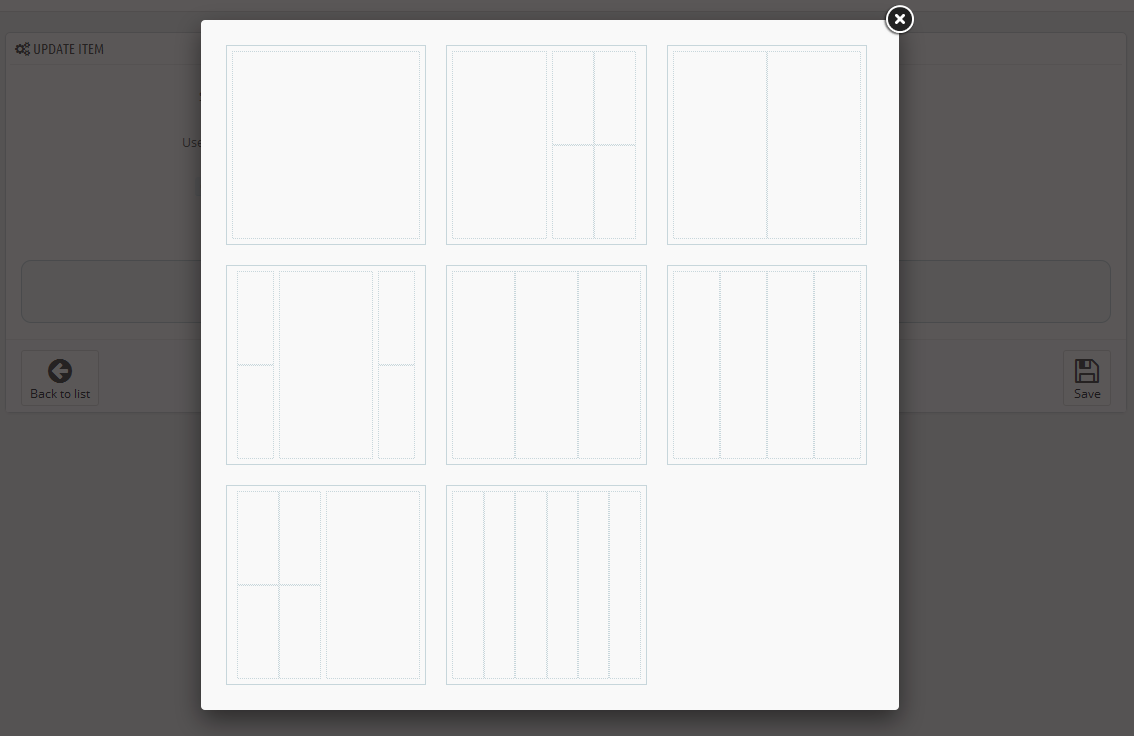
In order to add the layout, click on one of the eight options to pick it, and it will be added to the form.
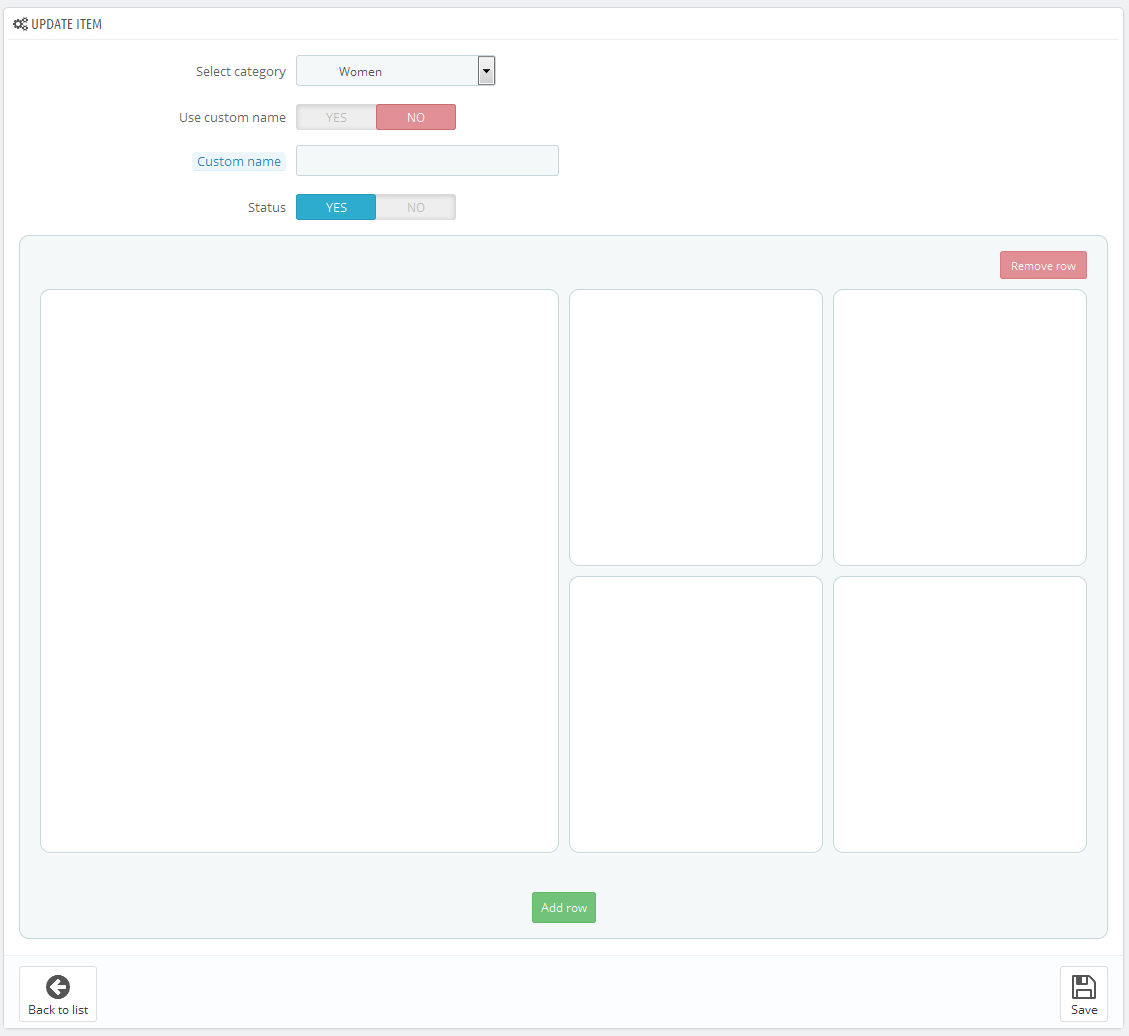
In order to add items, click on one of the layout cells. You'll see five buttons listing the available items of certain type.
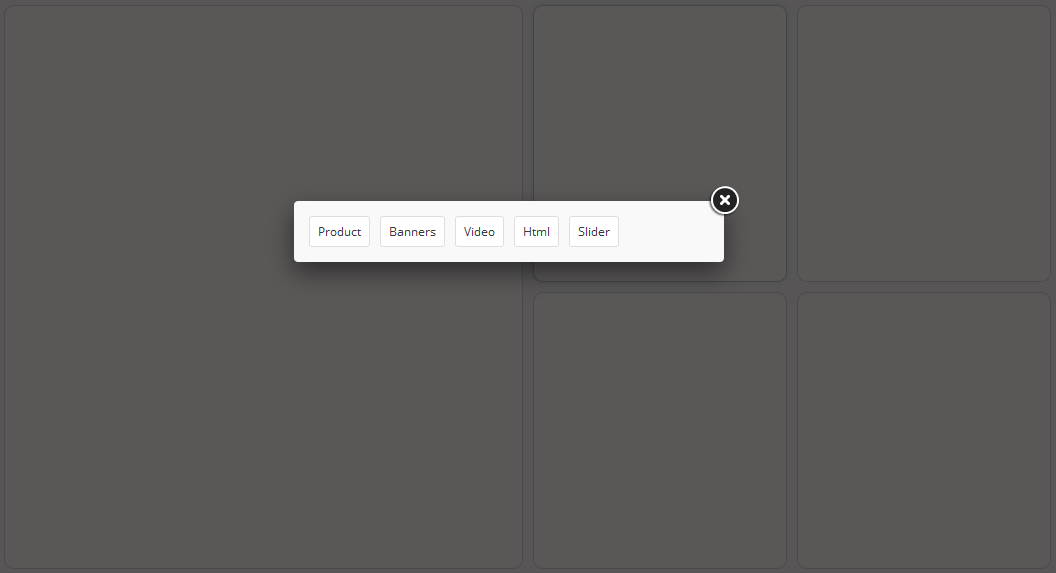
After pressing one of the buttons you will see the form to pick the item of chosen type.
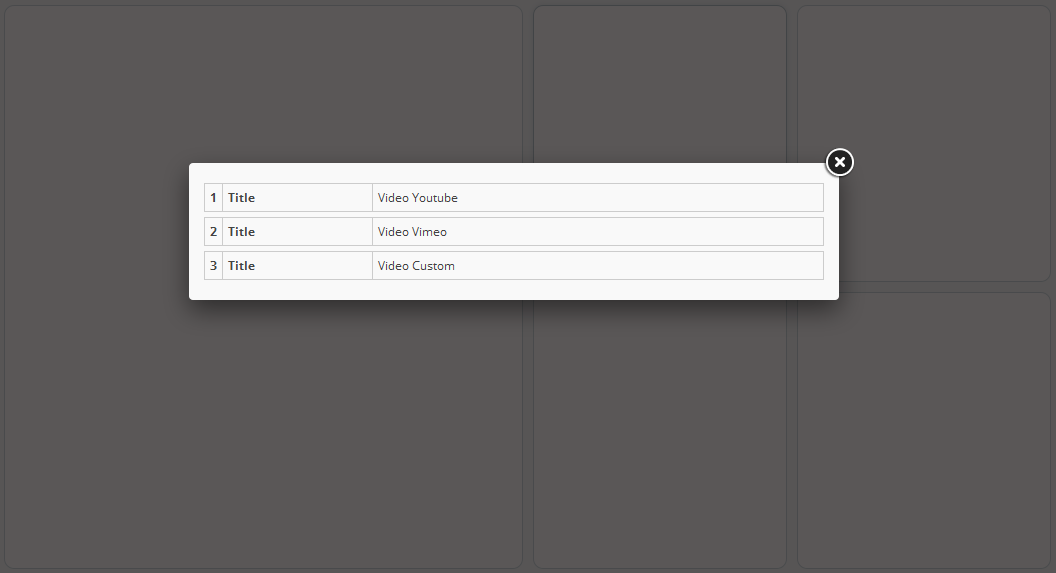
After clicking on one of the items, it will be added to the layout cell. You can fill in the layout with different blocks this way.
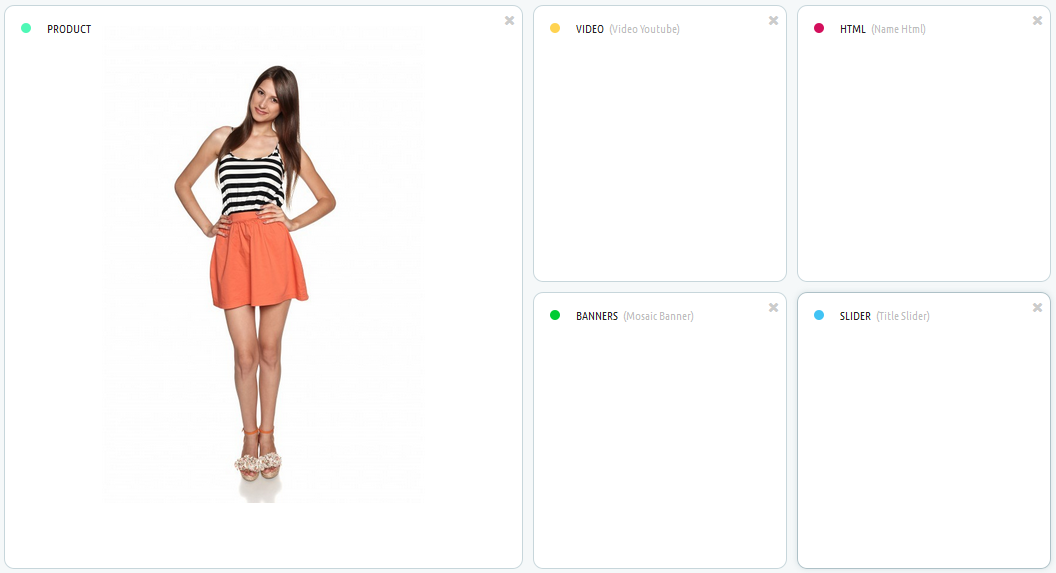
After saving the category with chosen layouts, it will show up in the form of the added categories.

In order to remove the item, press the 'Delete' button.
Banner adding/removing/editing
In order to add a new banner, click the 'Add new banner' button. Next, fill in the required fields in the form that appears.
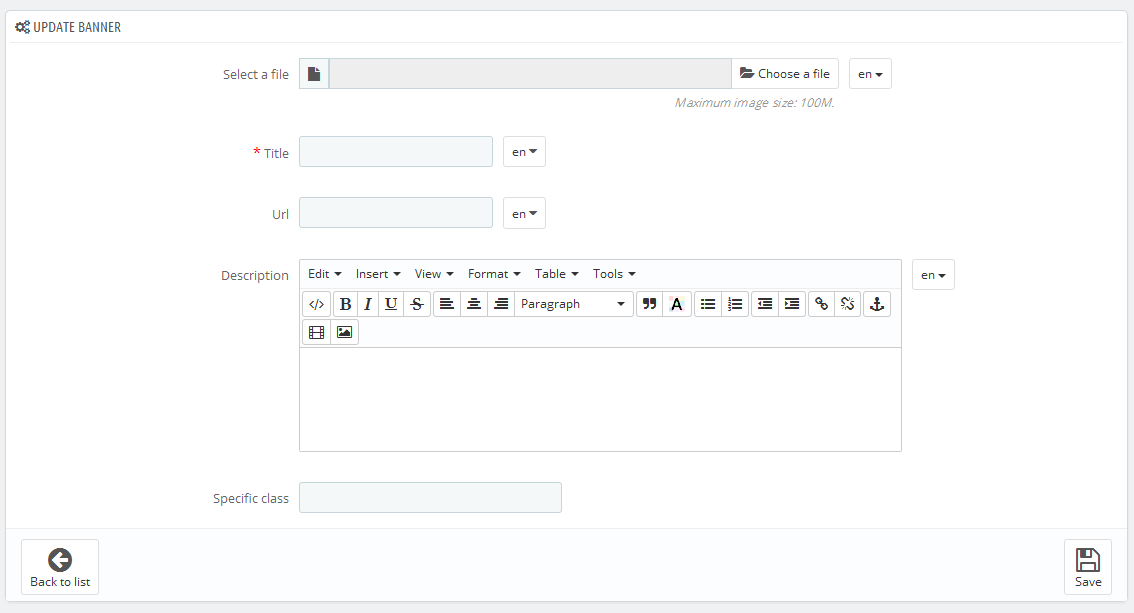
- Select a file - choose a file, this field is required (at least for the default language).
- Title - banner title, this field is required (at least for the default language).
- Url - link path, this field is required (at least for the default language).
- Description - banner description (at least for the default language).
- Specific class - block's CSS class.
Adding/removing/editing Video
In order to add a new video, click the 'Add new video' button. Next, fill in the required fields in the form that appears.
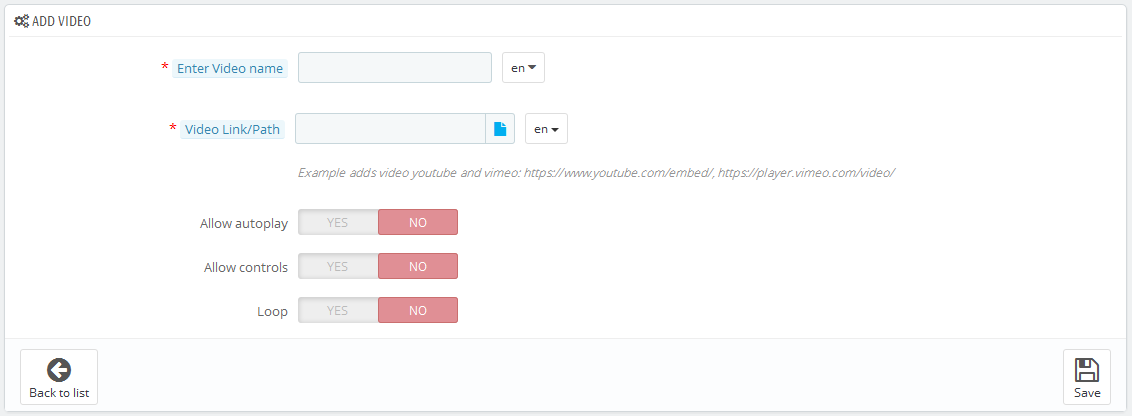
- Enter Video name - video title, this field is required (at least for the default language).
- Video Link/Path - link to the video (youtube, vimeo or custom video), this field is required (at least for the default language).
- Allow autoplay - defines if video starts automatically right after the player has been loaded.
- Allow controls - defines if player controls are displayed.
- Loop - defines if the video playback is in the infinite loop.
In order to add custom video, press the 'file' button. Next, you'll be able to add a video via file manager.
Adding/removing/editing HTML content
In order to add new HTML content, press the 'Add new HTML' button. Next, fill in the required fields in the form that appears.

- Enter HTML item name - HTML content title, this field is required (at least for the default language).
- Specific class - block's CSS class.
- HTML content - the content.
Adding/removing/editing Slider
In order to add a new slider, press the 'Add new slider' button. Next, fill in the required fields in the form that appears.
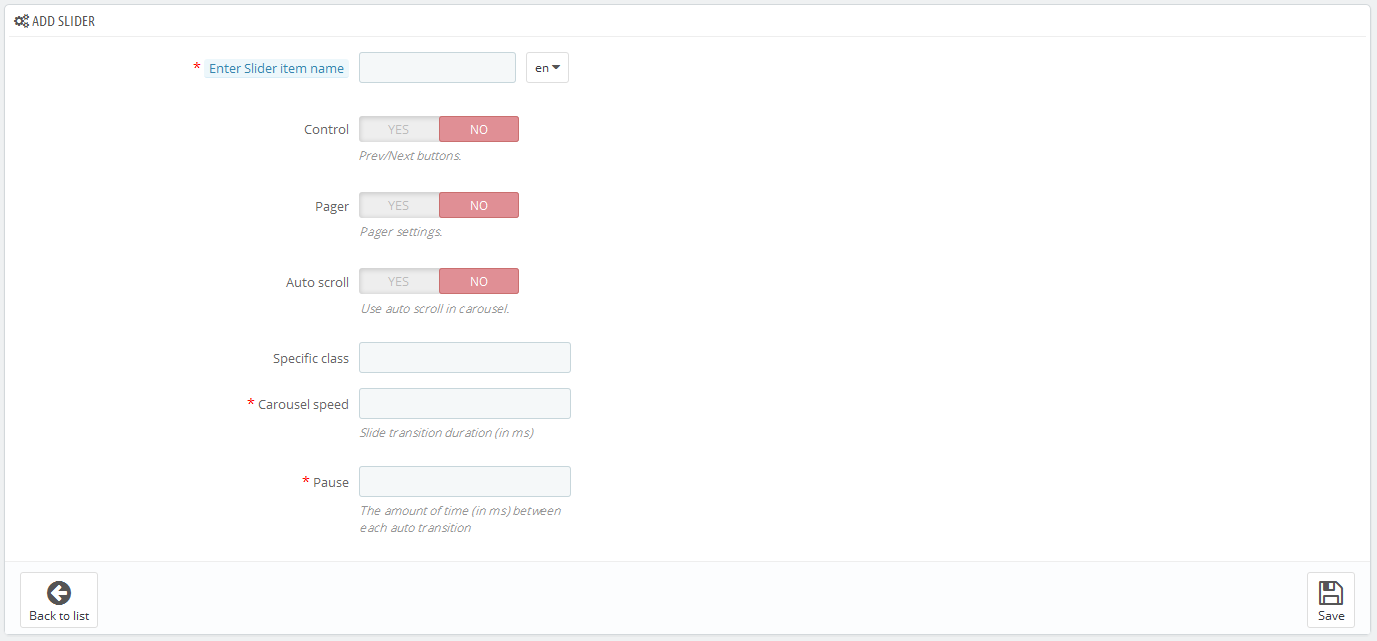
- Enter Slider item name - slider title, this field is required (at least for the default language).
- Control - show/hide slider navigation.
- Pager - show/hide slider pagination.
- Auto scroll - turns on/off slider autoplay.
- Specific class - block's CSS class.
- Carousel speed - slides transition duration (in ms), this field is required.
- Pause - the period between slides switching (in ms), this field is required.
Adding/removing/editing Slides
In order to add a new slide, click the 'View' button in the slider form and then press the 'Add new' button in a window that appears. Then fill in the required fields.

- Type - choose the slide type, this field is required.
- Banner/Video/Html list - choose the element of the previously selected type, this field is required.
- Sort order - slide position.
- Item status - status of the element.
TM MotoPress Slider
Available in:
Fashion, Electronics, Spare Parts, Furniture
Module Installation
This module provides the ability to add MotoPress Slider to your HTML page. It can be installed like any other PrestaShop module:
Upload module to the /modules folder.
Go to Admin panel -> Modules and Services -> Modules and Services (1), find the module (2) and click the 'Install' button (3).

When the module is successfully installed you can see the 'MotoPress Slider' menu appeared at the bottom of your admin panel (1).
Click the 'MotoPress Slider' button in this menu (2).
Module Usage
Adding/editing slider
Now you are able to add new slider (1) or edit the existing one (2).

Adding new slider
When you clicked the 'Add Slider' button, there's an option to choose if it should be 'Custom Slider' or 'Product Slider'.
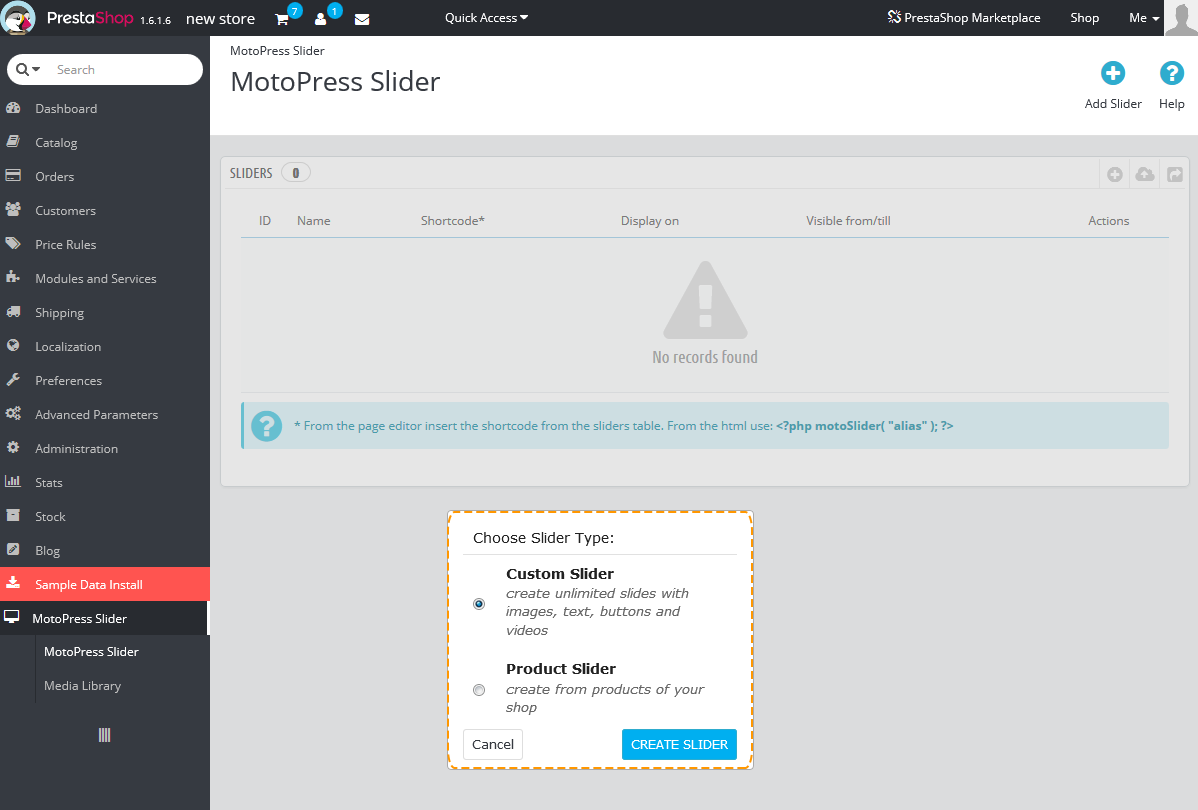
The difference between these two types is the following: Product slider is created from the products of your store, though in Custom Slider you can add as much slides as you wish, customizing them according to your needs.
The settings for Custom and Product slider are slightly different.
They will be mentioned further.
Module Configuration
Slider settings
The main slider settings. Detailed settings description is below the screenshot.
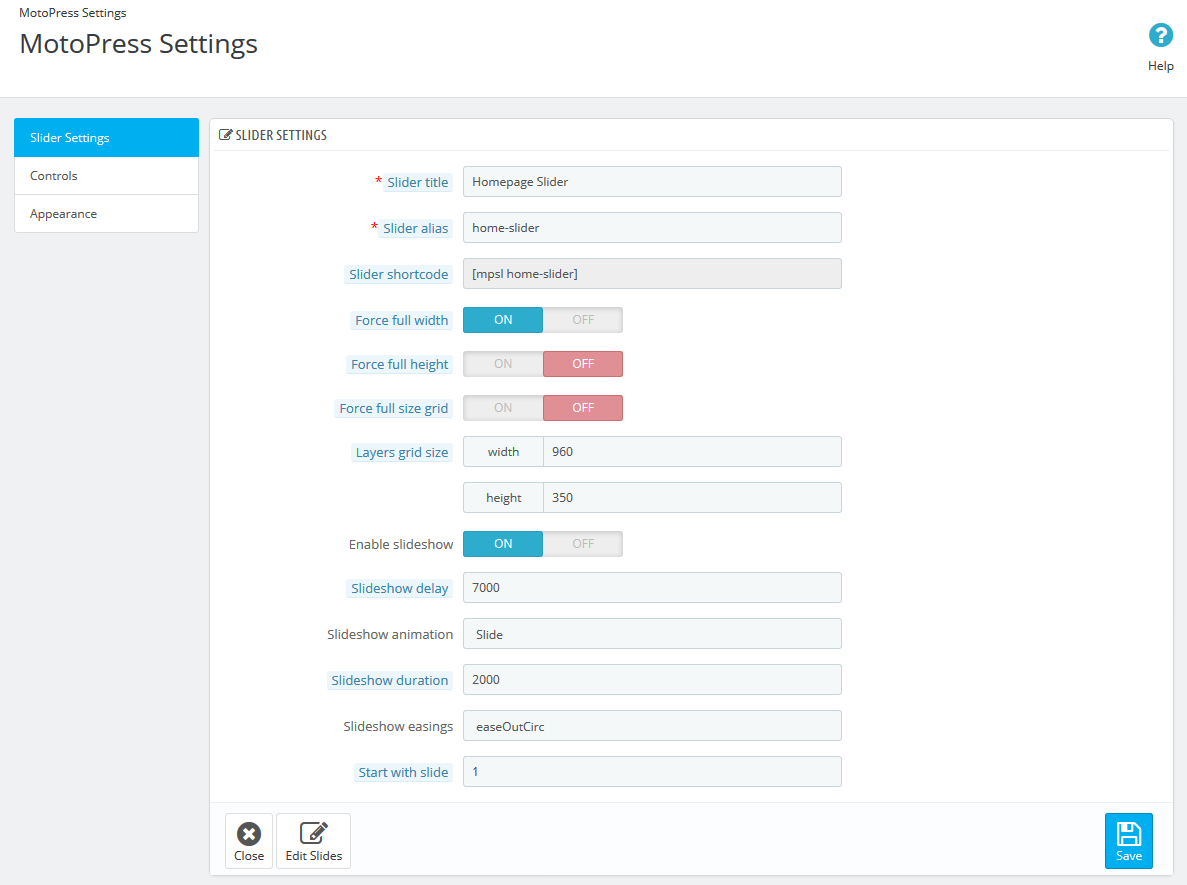
- Slider title - the title of the slider (example: Slider1); it is required when you have several sliders and have to distinguish them.
- Slider alias - the unique alias that will be used in shortcodes for embedding the slider (example: slider1); must be unique.
- Slider shortcode - copy this shortocode and paste to your page.
- Force full width - enable this option to make this slider stretch to full-width.
- Force full height - enable this option to make this slider full-height.
- Force full size grid - makes grid stretch to parent container (but you still need to set grid width and height).
- Layers grid size - allows to set initial width and height of the layers.
- Enable slideshow - enable/disable the slideshow.
- Slideshow delay - the time one slide stays on the screen; is measured in milliseconds.
- Slideshow animation - choose the animation for changing slides.
- Slideshow duration - animation duration in milliseconds.
- Slideshow easings - easings on slide changing.
- Start with slide - first slide index.
Controls
Options which refer to slide switching controls.
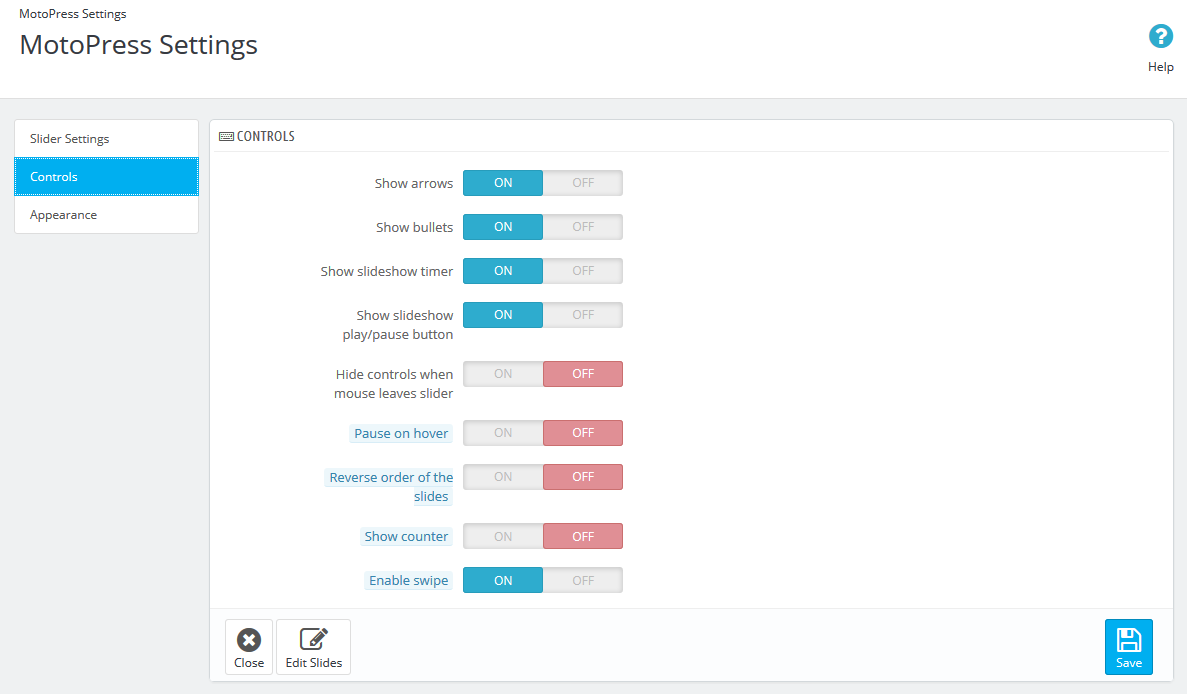
- Show arrows - show/hide arrows.
- Show bullets - show/hide bullets.
- Show slideshow timer - show/hide timer.
- Show slideshow play/pause button - show or hide play/pause button.
- Hide controls when mouse leaves slider - hide controls when mouse is not on slider area.
- Pause on hover - allows to pause slideshow while hover the slider.
- Reverse order of the slides - animate slides in the reverse order.
- Show counter - enable to display the number of slides.
- Enable swipe - turn on swipe on desktop.
Appearance
Options referring the display of slider.
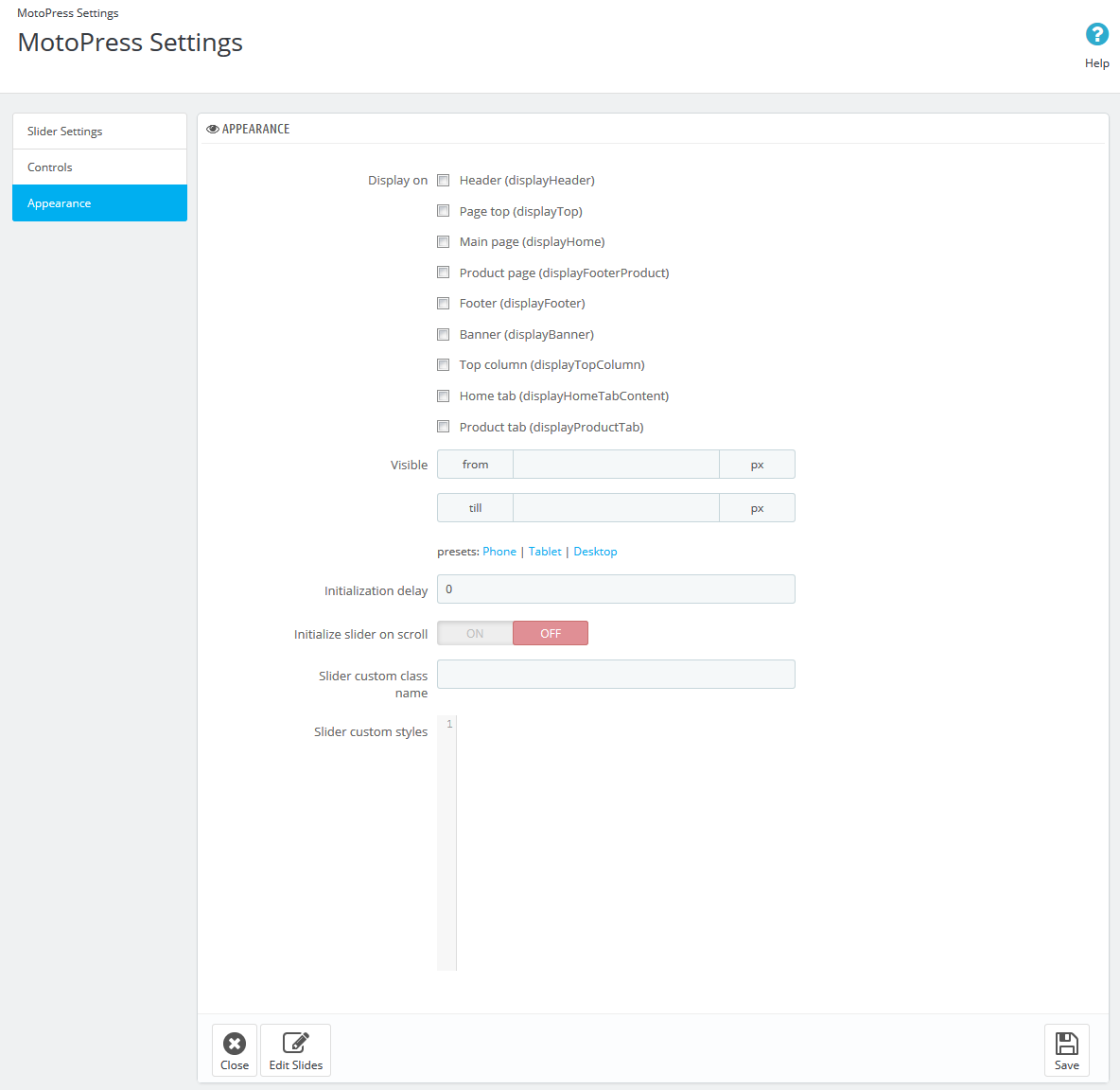
- Display on - hooks where the slider should be displayed.
- Visible - min. and/or max. screen resolutions when the slider is visible (can be set using the presets: phone / tablet / desktop).
- Initialization delay - the delay bofore slider initialization (should be set in milliseconds).
- Initialize slider on scroll - choose if you want the slider to be initialized on scroll.
- Slider custom class name - name of custom class which is used for slider.
- Slider custom styles - custom css styles can be added directly in this textarea.
Content
This menu appears only for the Product Slider.
When it will be configured press the 'Create' button (1).
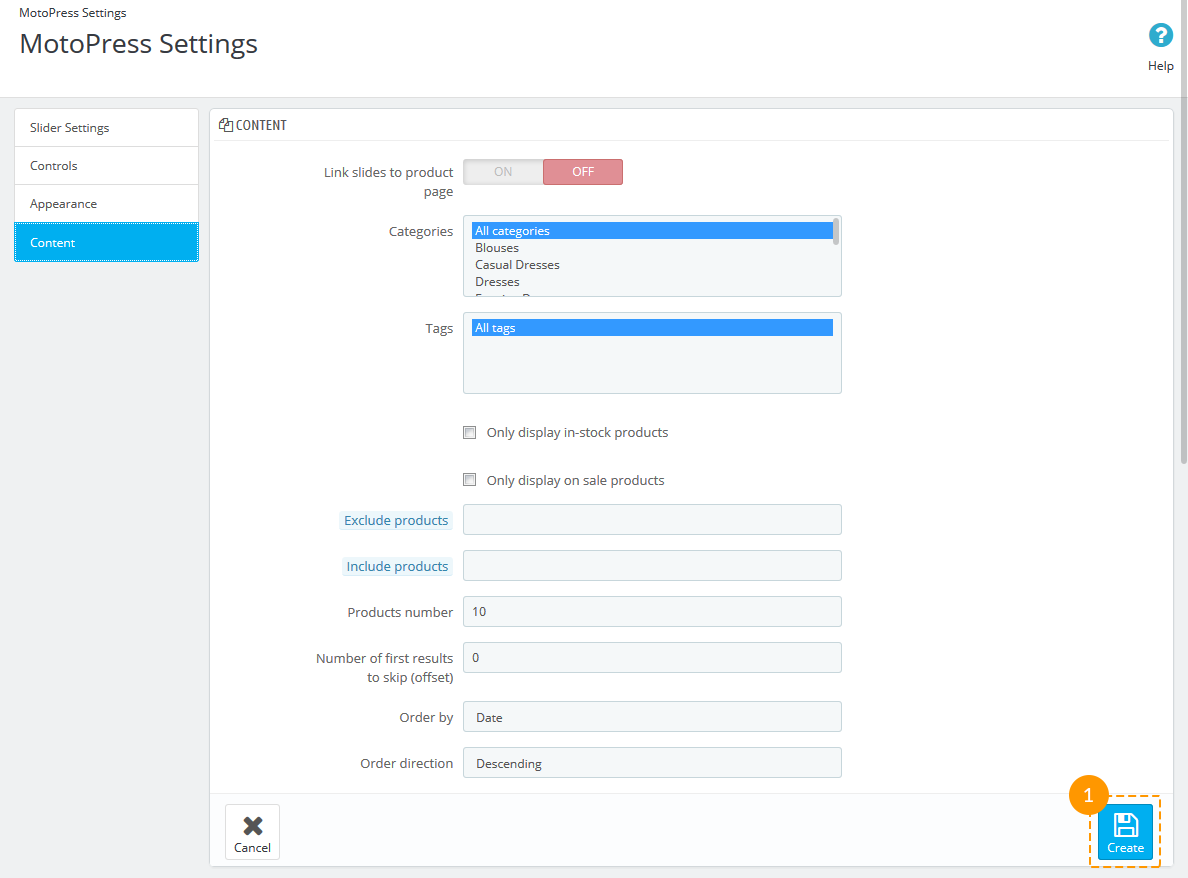
- Link slides to product page - enable if you want the product page to be opened after the click on slide with the product.
- Open in new window - enable this option to open the product page in new window.
- Categories - categories with products to show in slider (Ctrl + click to select several categories).
- Tags - tags to be included.
- Only display in-stock products - only products in stock will be displayed.
- Only display on sale products - only products on sale will be displayed.
- Exclude products - add Product IDs separated by comma.
- Include products - add Product IDs separated by comma.
- Products number - number of products to be displayed.
- Number of first results to skip (offset) - the number of first slides which will not be shown.
- Order by - type of order to be applied.
- Order direction - descending or ascending order direction.
Below there's a list of products which will be displayed in slider. After you've made any changes in settings, press the 'Preview products' button (1).
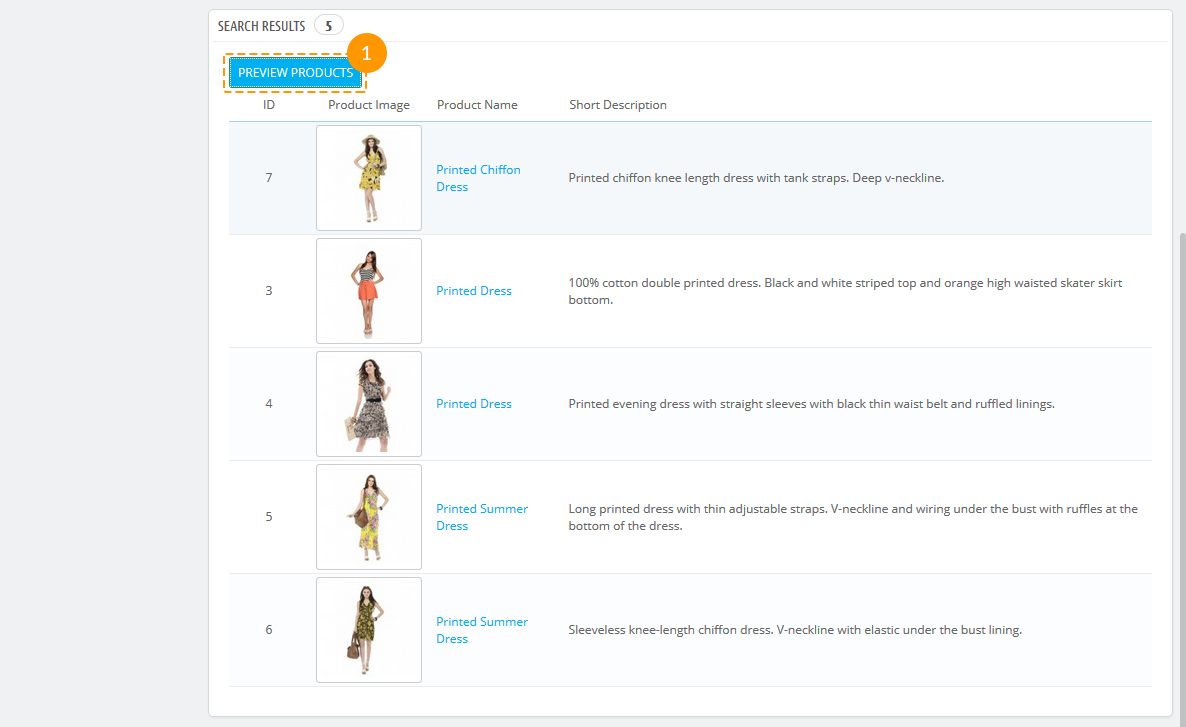
After the slider has been configured, press the 'Save' button.
Adding/editing slides
To add new slide press the button 'Add Slide' (1). To edit the existing one click 'Edit' (2).

Slide settings
MotoPress Slider contains the Style Editor. That allows customizing slide layers, their styles and texts using preview area and avoiding any manual changes of code or CSS rules.
Select slider to edit and pick the actual slide to work with.
General
General slide settings include slide title and status.

Color
In the 'Color' tab there are two variants of background color type - background color and gradient. Choose the option and the preferable color.
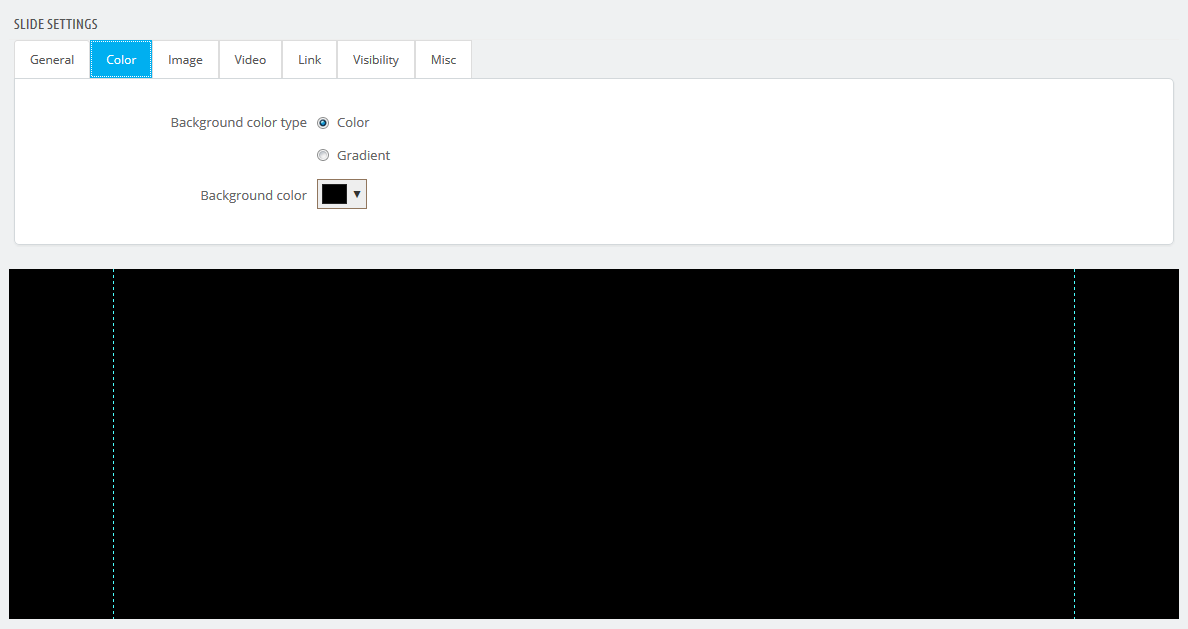
If you choose gradient, select gradient color 1, gradient color 2 and the gradient angle.
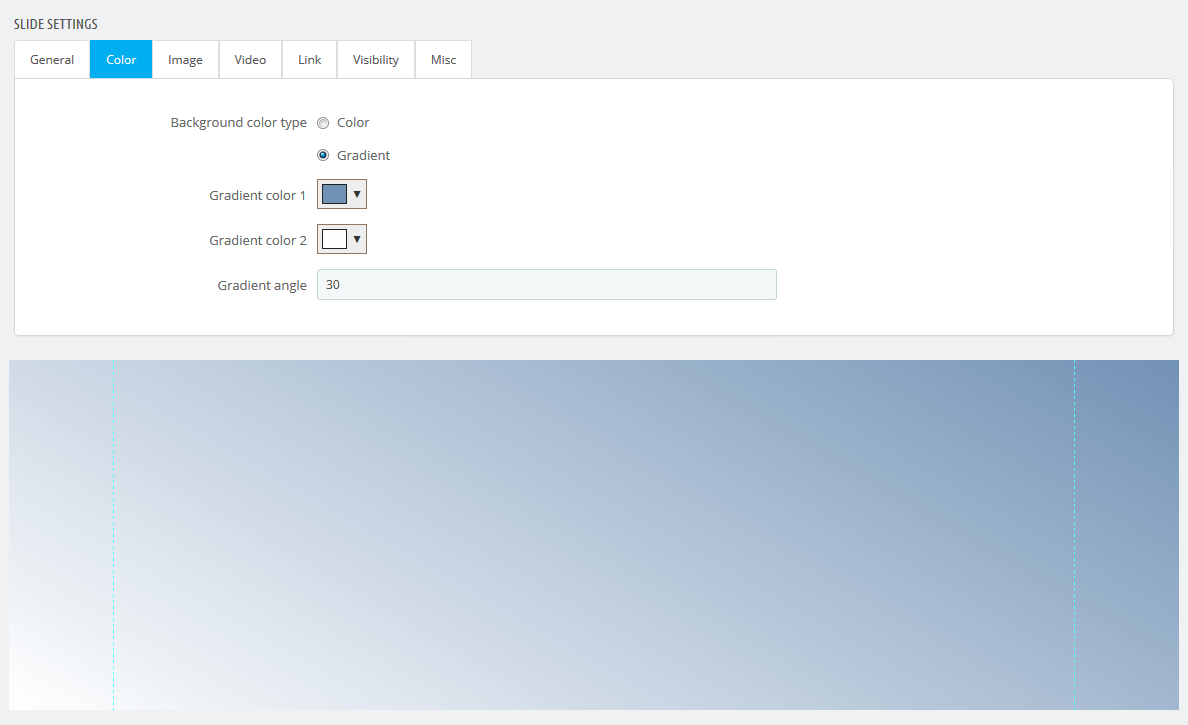
Image
Background image can be attached from the Media Library or from the external URL.
Image can also be added from your local folder to the Media Library. To do this press the 'Browse' button (1).
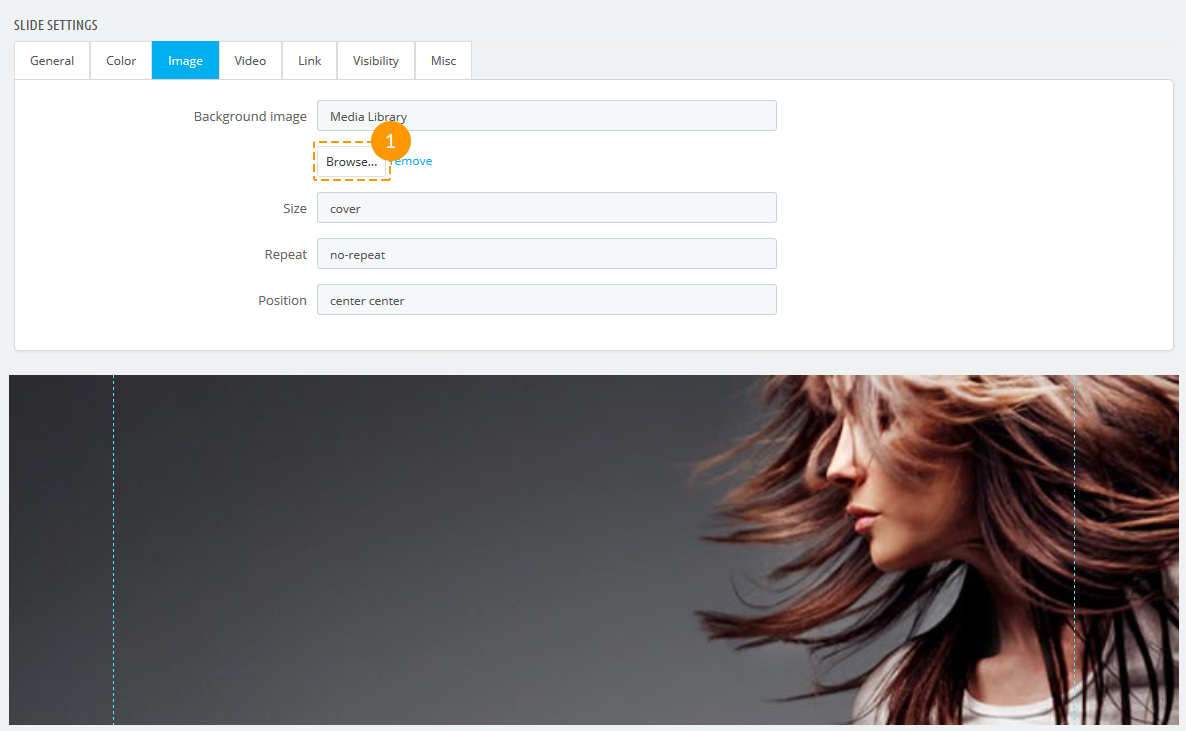
Then choose 'Upload New' (2) tab and click on the selected area or simply drag the images into it.

Video
You can add video to your slide. To add video choose sources for different video formats and set other parameters for video display. You'll need to upload a video in MP4, WEBM or OGG format and provide the video file URL in Video tab.
Settings for video display can also be adjusted.
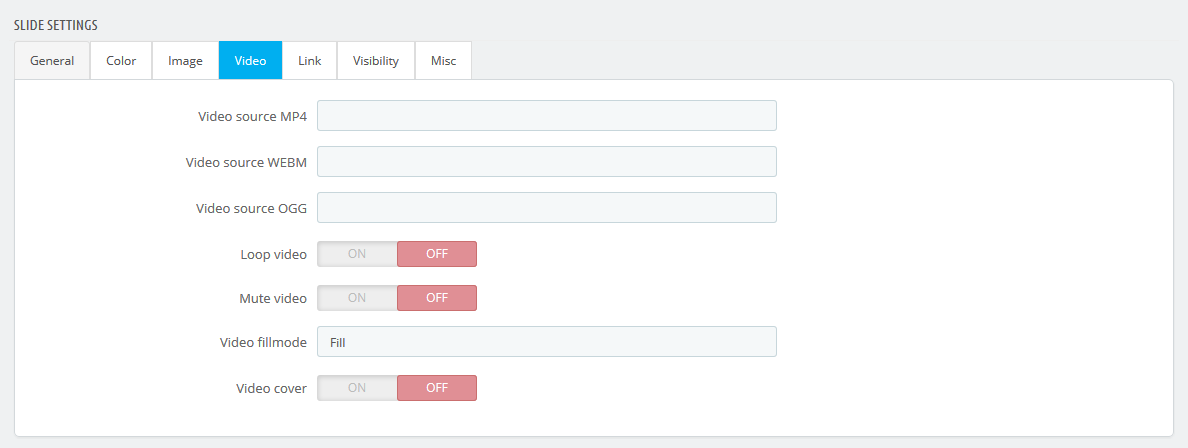
Link
Link tab allows adding a link to your slide, assign the id, class, add link title and relation:
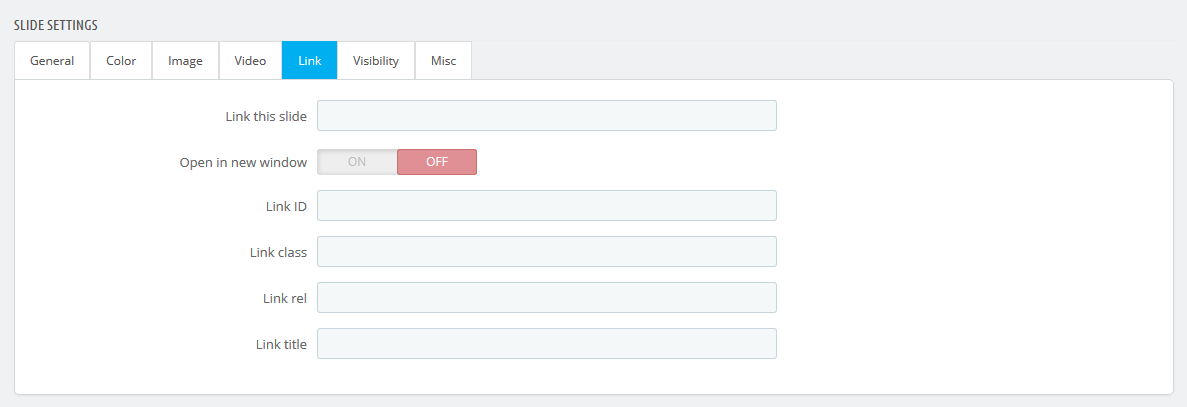
Visibility
Slide visibility options can be managed from the Visibility tab:

Misc
Misc section allows assigning a css class or id to the slide.

Click on 'Save slide' button when you are done making changes.
Slide content
Here you can add texts, images, buttons and video to each slide.
It is divided into two main sections: 'Layer Settings' (1) and 'Layers Sorting' (2).
Above the 'Layer Settings' area there are four tabs for adding the needed content (3). After you've chosen what
element you want to add, you can go further with detailed customization.
The great feature is that these contents are added as individual layers, so you can drag them up and down to set
their order in the 'Layers Sorting' section (2).
Layers can be deleted separately (4) or all at once (5).
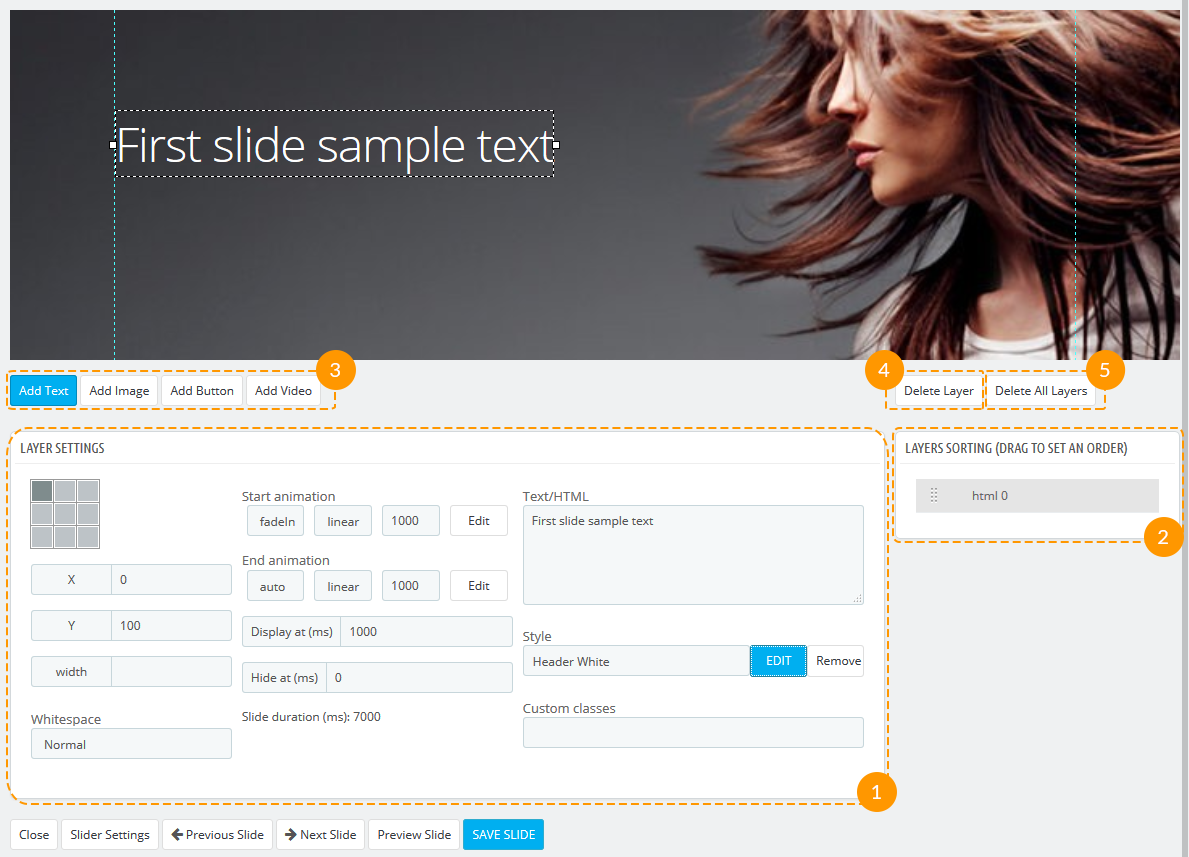
Layer settings
Add Text
This tab is created to add, edit and locate texts in slide.
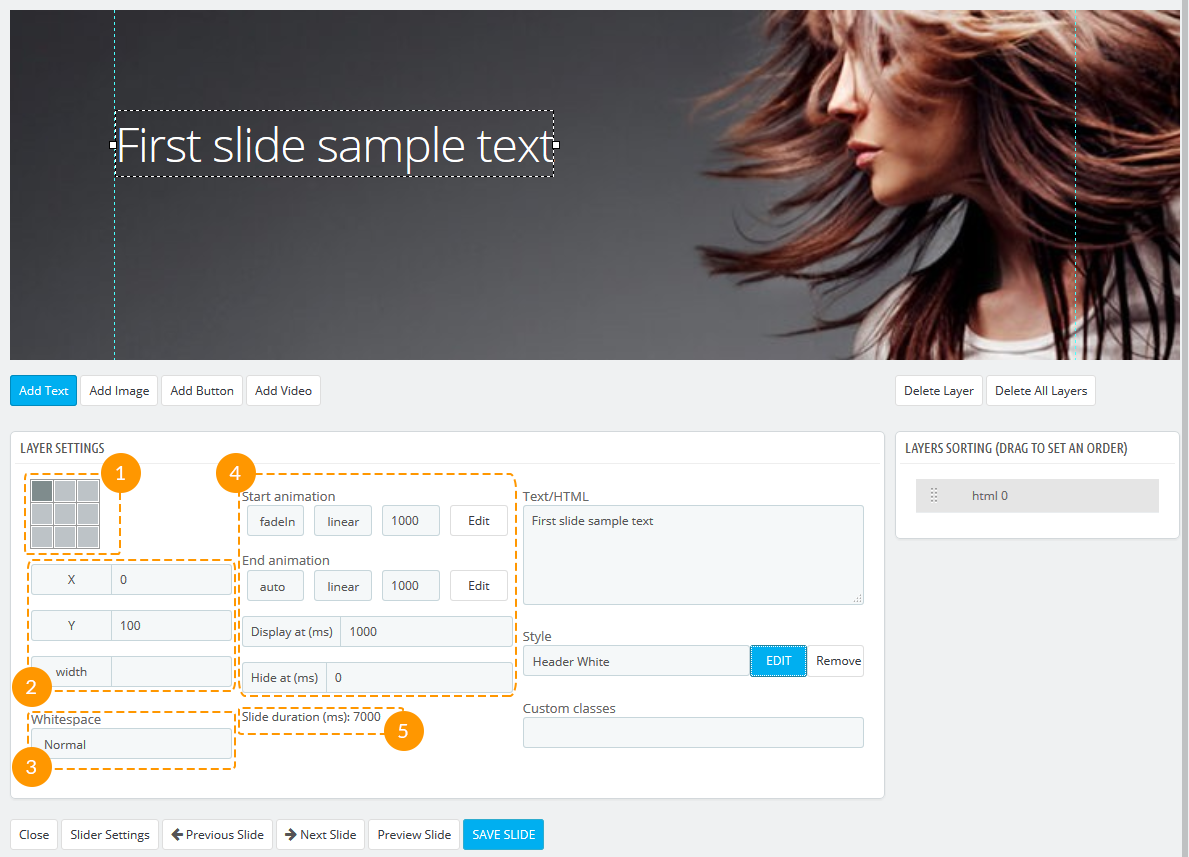
- Using grey squares you can quickly set the position of the text (1).
- To adjust it, add the 'X' and 'Y' value in pixels and set the width of this element (2).
- If 'Whitespace' is set to 'Normal', the text will be wrapped normally. If 'No-wrap' is chosen, the wrapping will be ignored (3).
- In the second column you can control the element animation - how, how long and when it should start and end (4) within the duration of the slide (which is shown below for your convenience (5); to change it go to Slider Settings -> Slideshow delay). You can also preview the animation in the window that appears after clicking the 'Edit' button. Choose the duration, ease function, animation effect and press 'Play' to preview. Then click 'Apply' when it meets your expectations.
Settings described above are similar for each element, that's why only options from the third column will be mentioned further.
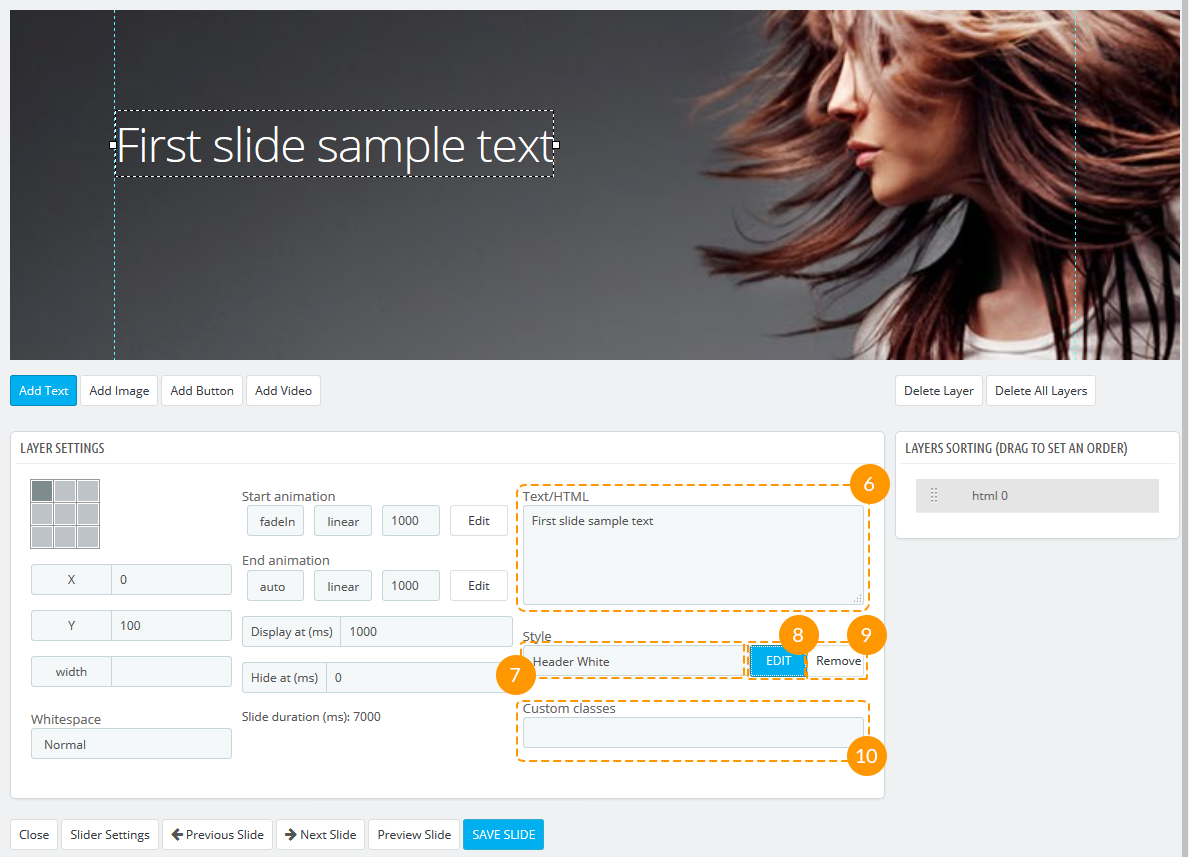
- The text itself can be added in the textarea which comes next (6).
- The text style can be chosen from the presets in the dropdown (7), edited after you've pressed the 'Edit' button (8), and disabled clicking the 'Remove' button (9). After the text style has been edited, press the 'Apply Style' button. If you want to edit and save the existing style, press 'Duplicate' button, edit and save it. To create from scrach the style which will be often applied, click the 'Create new preset' and edit it.
- It is also possible to add a custom class to each element (10).
Add Image
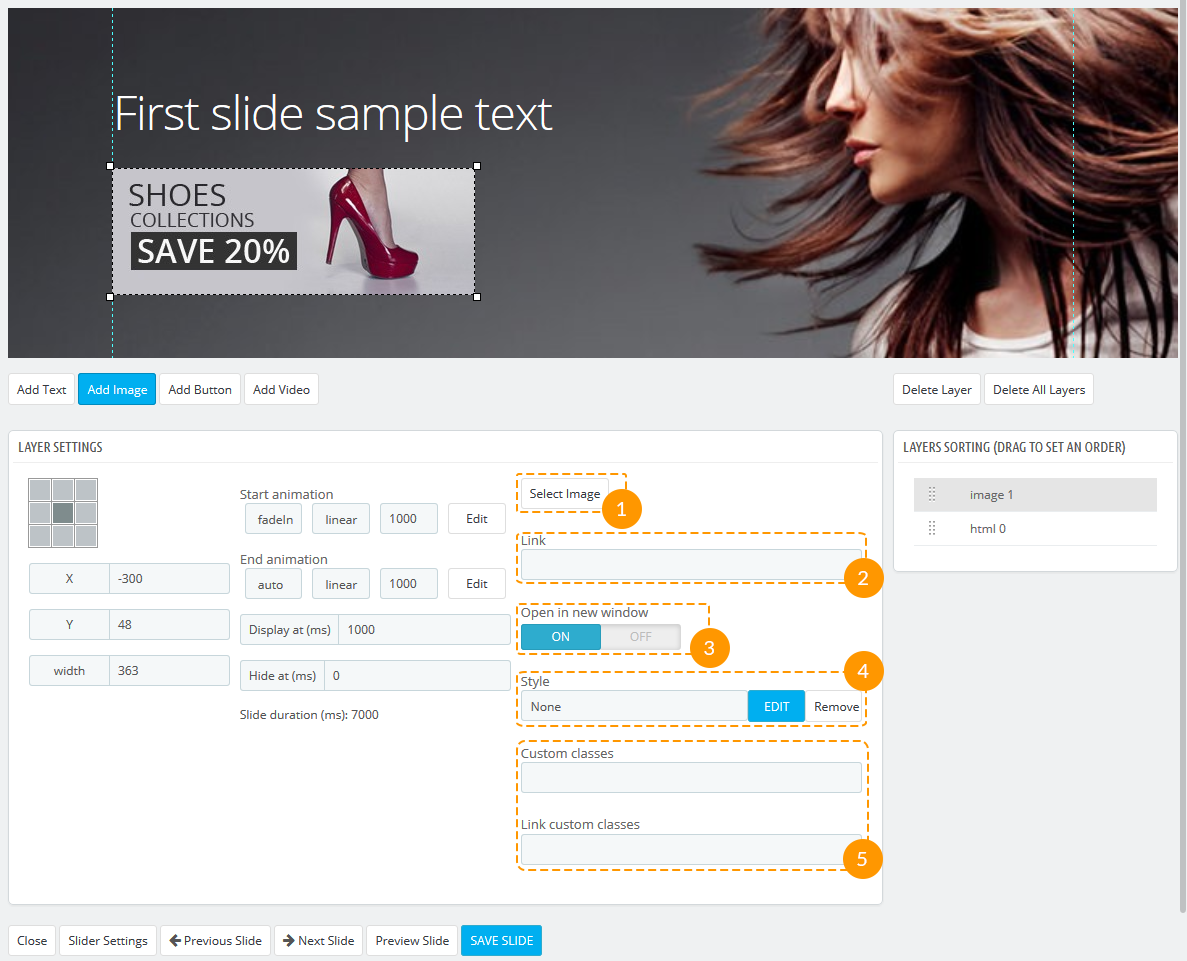
- To choose the image press the 'Select image' button (1).
- If you want to add the link to image, add the URL of the target page in the 'Link' field (2).
- This link can be opened in new window ('On') or in the same ('Off') (3).
- Some styles can also be applied to images (for example, border styles) (4).
- It is also possible to add a custom classes to the element (5).
Add Button
Button styles are almost the same as image styles.
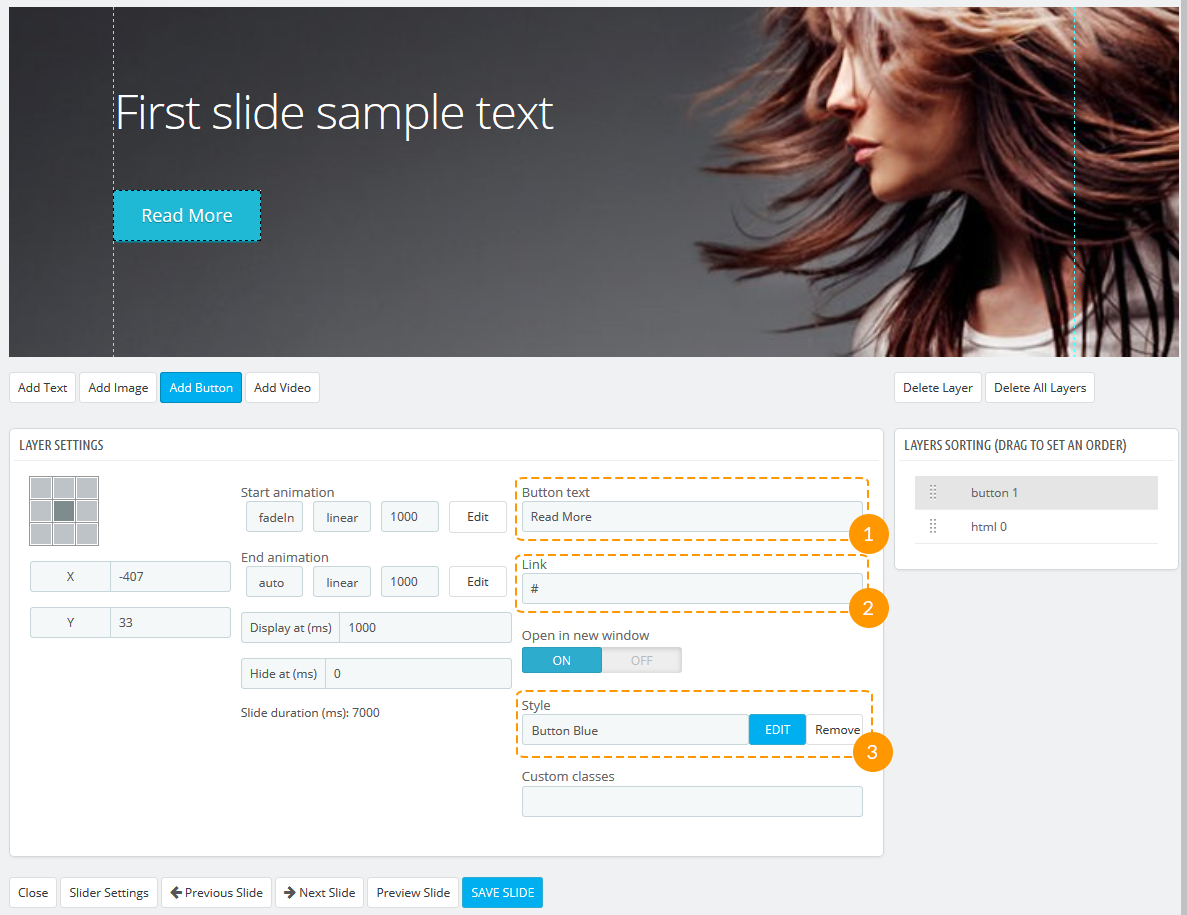
- Add the button text in the corresponding field (1).
- Add the URL of the target page in the 'Link' field (2).
- Choose the style for your button or create your own (3).
Add Video
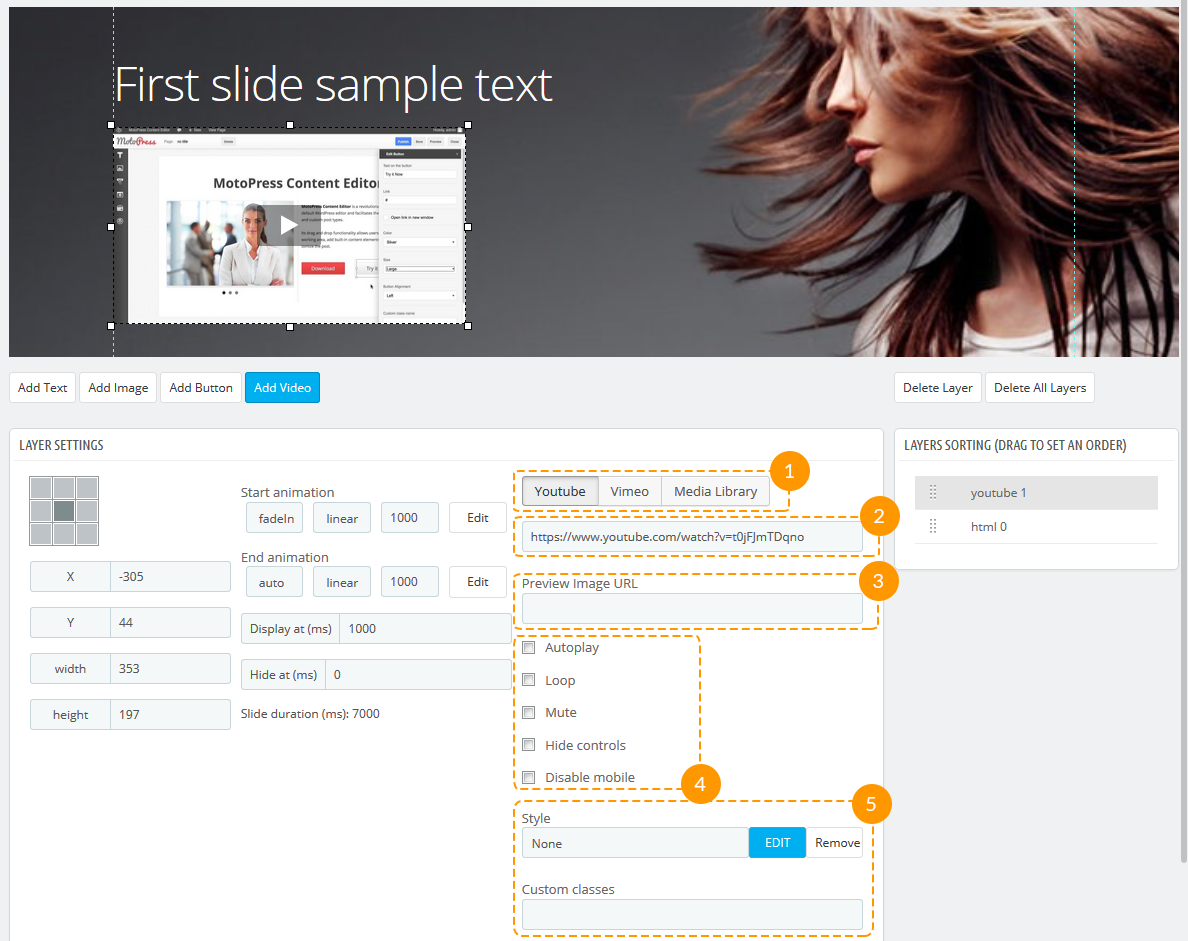
- Video can be added as a link to Youtube or Vimeo, or it can be chosen from Media Library (1).
- Add the video URL (2).
- Add the URL of the preview image (3).
- Choose the video dispaly options (4) and add styles to it (5).
After you've made changes to your slide, don't forget to click the 'Save slide' button (1), then press 'Close' (2) or navigate between other slides (3).

Import and Export Slider
Import & Export Slider is very useful if you need to transfer any Slider to different websites. You do not need to spend much time for re-building sliders from scratch any more. If you are a developer you can create sliders on your website, show them them to your customers and import sliders to customers' websites.
Exporting Slider
Follow these easy steps to learn how to export Motopress slider.
-
Go to Motopress Slider in your admin panel (1, 2).

-
Click 'Export' button (3).

-
Choose sliders you want to export (4) and click 'Export sliders' button (5).

- You'll be prompted to save the exported .json file to PC.
Importing Slider
In order to import Motopress Slider do the following:
-
Go to Motopress Slider in your admin panel (1, 2).

-
Click 'Import' button (3).

-
Select the exported .json file from your PC clicking the 'Browse' button (4) and press 'Import' (5).

- Slider settings, images and other slider content should be exported successfully to your website.
TM Newsletter
Available in:
Fashion, Electronics, Spare Parts, Furniture, One Product
The module displays a notification with a proposal to subscribe to store newsletter in a pop-up window. The email check can be enabled in module settings by means of confirmation email. You can also adjust the timeout between reminders for registered and non-registered users. Registered users can permanently give up on reminders.
Module install/uninstall
This module can be installed/uninstalled as any other PrestaShop module.
Module settings
After module has been installed you can configure it on the module configuration page.
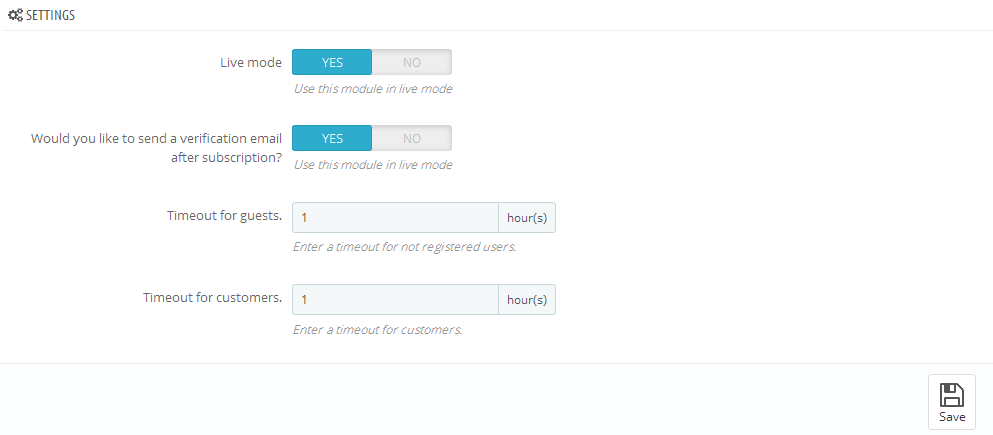
- Live mode - enable/disable the module.
- Would you like to send a verification email after subscription? - enable/disable confirmation email send.
- Timeout for guests - set timeout for popup reminding subscription for guests.
- Timeout for customers - set timeout for popup reminding subscription for customers.
It is necessary to install and enable 'Newsletter block' for proper work of module.
TM Olark Chat
Available in:
Fashion, Electronics, Spare Parts, Furniture, One Product
Module to display Olark Chat on your store front-end.
Module install/uninstall
This module can be installed/uninstalled as any other PrestaShop module.
Module settings
After module has been installed you can configure it on the module configuration page.
In order to configure Olark Chat, which you can see on the live demo of the template, you need to register on the official website and to get the ID for your website. Input your ID to the field "Olark site ID" and set module under "Live mode". Now save settings by clicking 'Save' button.

TM One Click Order
Module is used to make the process of making an order much faster and easier than it was before.
It simplifies the procedure from five steps to one and makes it more appealing for the customers who want to save
their time while making an order.
By means of this feature you can get more spontaneous purchases that will have a positive impact on your business.
Installation
Navigate to Modules and Settings -> Modules and Settings (1) in your admin panel and find the TM One Click Order module (2). Then click the 'Install' button (3).
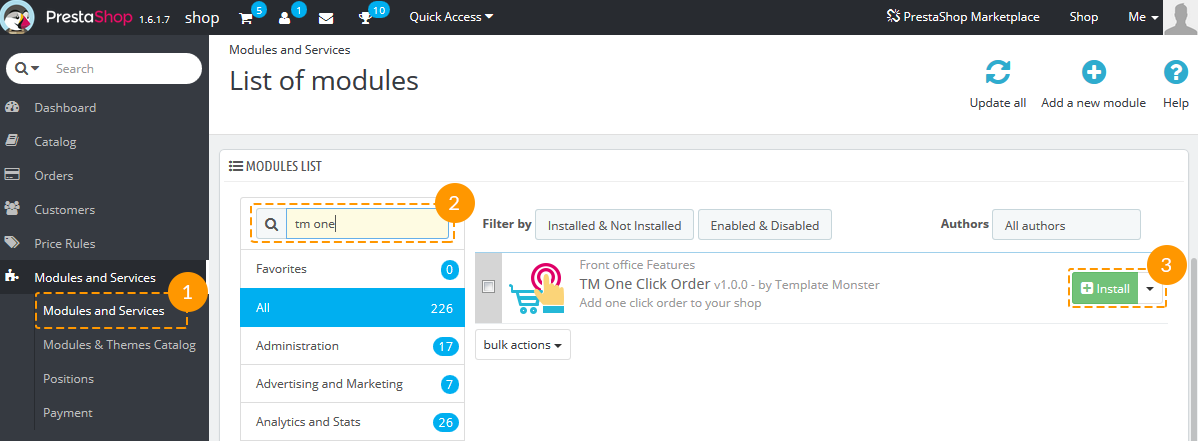
Module configuration
After the module has been successfully installed, the 'Configure' page with the module settings will be opened.
You'll also see the new menu item 'Quick Orders' (1) and a new icon will appear in the navigation panel (2).
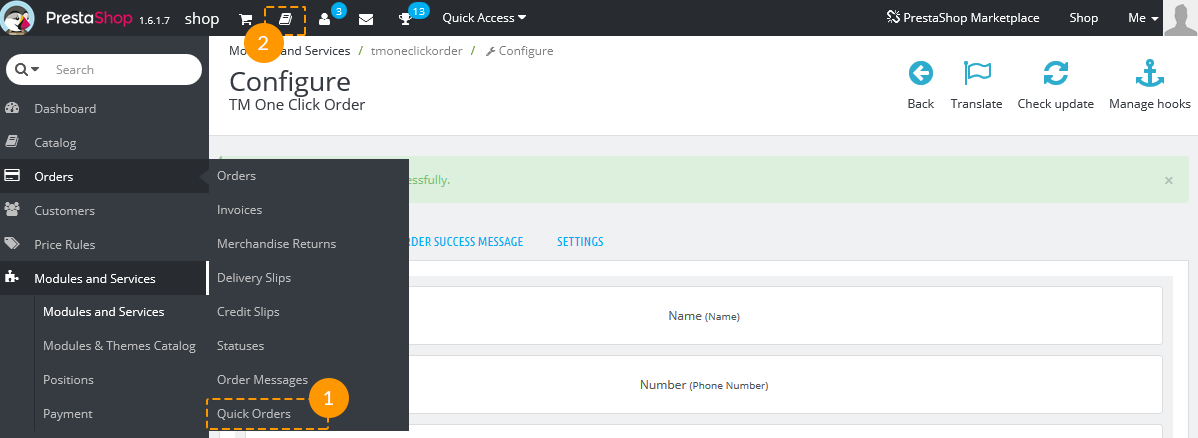
The settings are divided into three tabs - Preorder template (1), Preorder success message (2) and Settings (3).
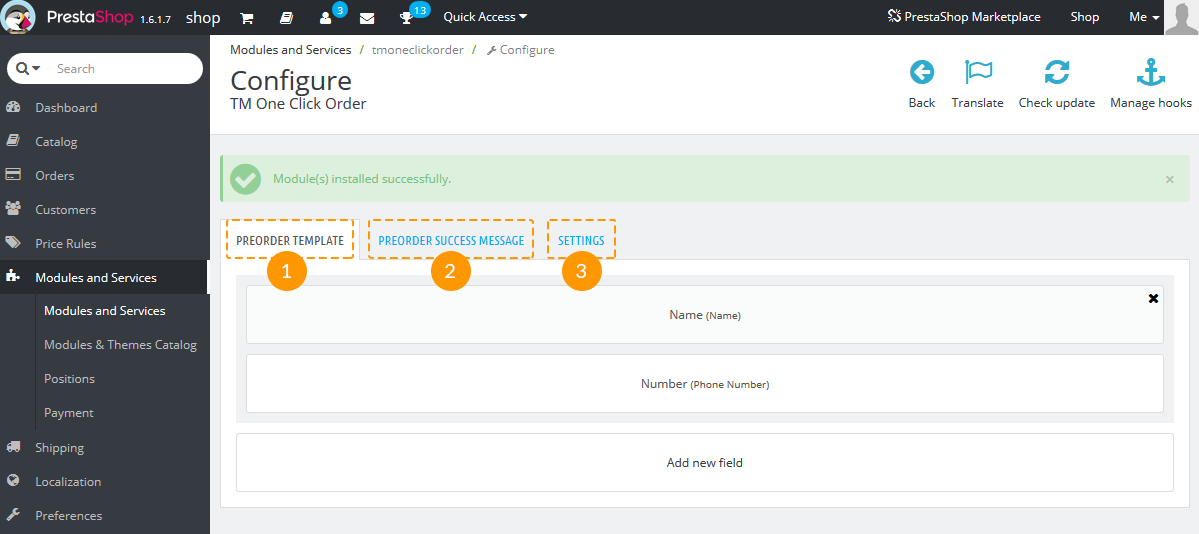
Preorder template
Here you can add a new field by pressing the corresponding button (1):
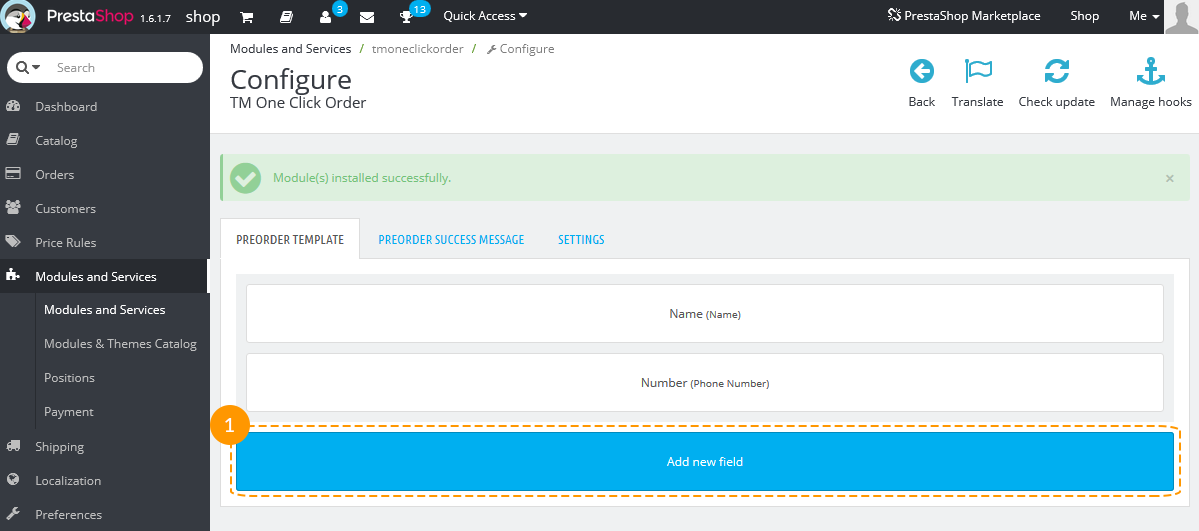
Choose the options for the new field and click the 'Save' button (1):
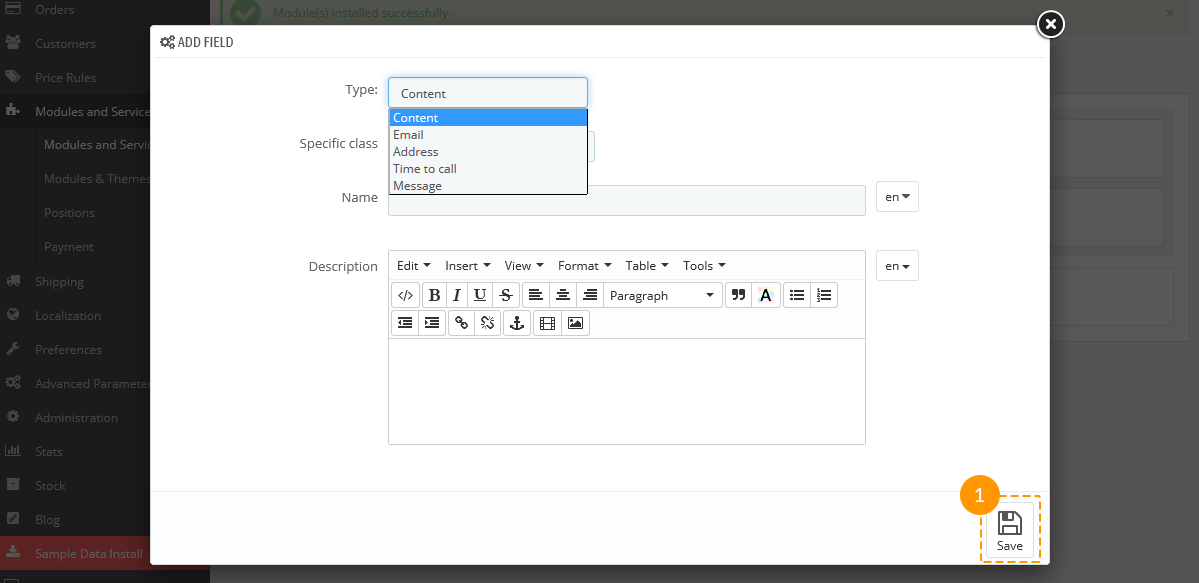
- Type - choose the type of field.
- Specific class - add the custom class for the current field.
- Name - field name.
- Description - field description; appears below the input.
-
Edit the existing field.
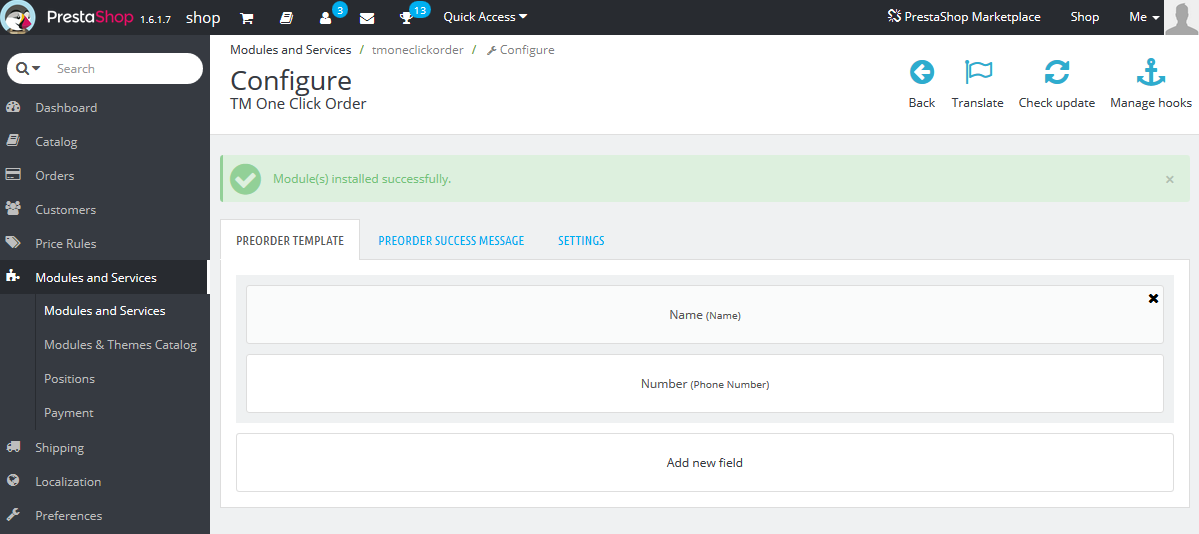
Click on the field you want to edit. The settings are the same as for adding new field.
-
Delete the fields from the form.
Click the 'Delete' button (1) in the top right corner of the field.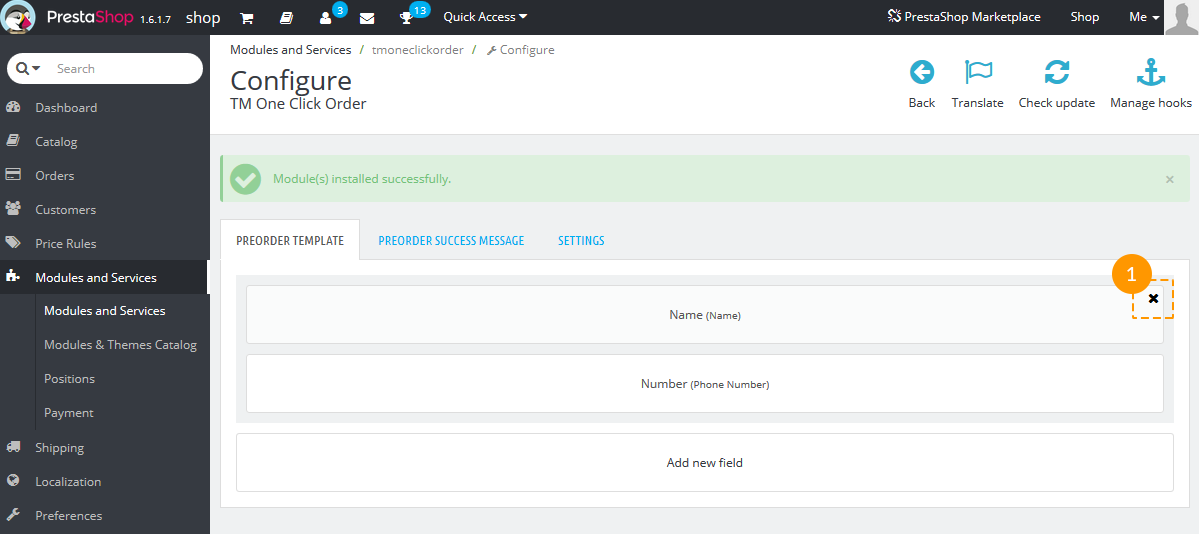
Preorder success message
The tab allows to edit the message for the alert window that appears after the user clicks 'Send' button in quick order form.
Add the text/button you want to be shown and click the 'Save' button (1).
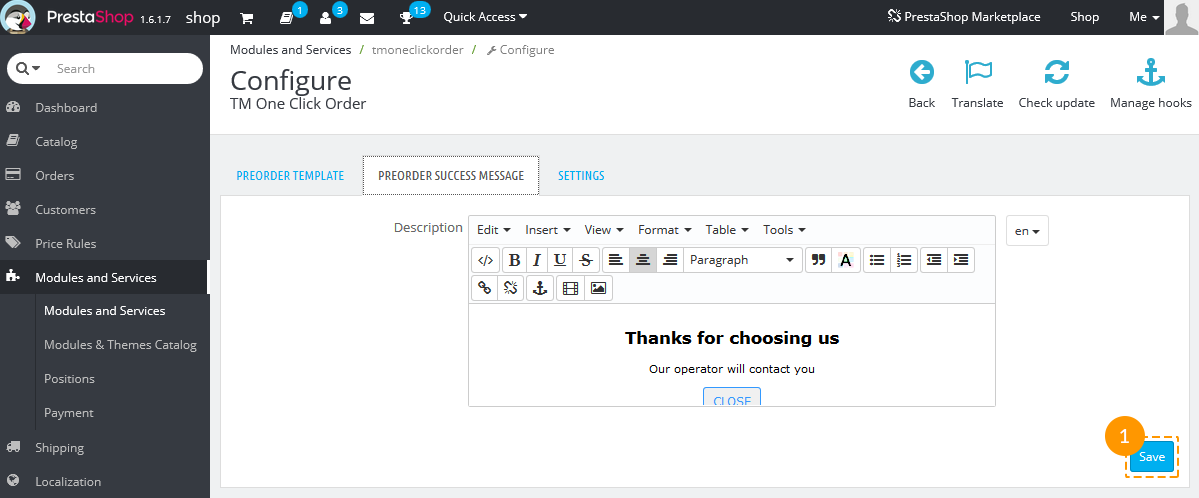
Settings
The tab allows to switch the 'Ajax order' option on and off.
It helps the administrator to see the new quick orders which were submitted while processing the existing orders.

If the option is enabled, the additional option 'Ajax order timeout' appears.
The value is set in milliseconds and means the time period between each check for new quick orders.

This option helps to open new preorders without page reloading. To see them in the list of quick orders, click the 'Load new orders' link (1) in Orders -> Quick Orders menu.
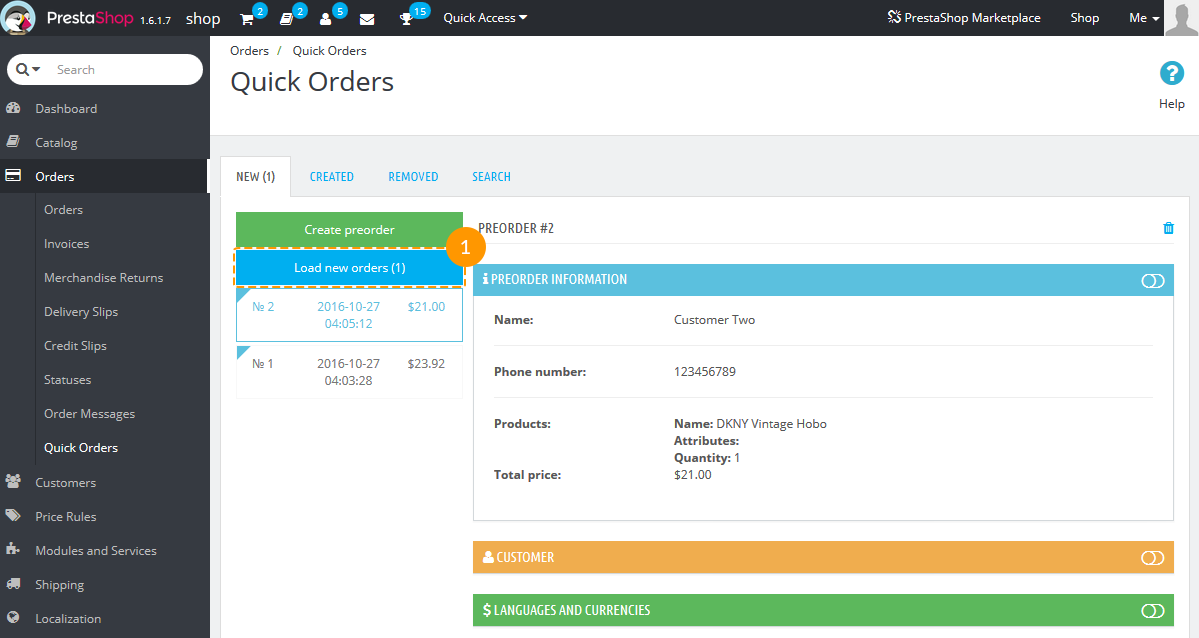
Order processing
Navigate to Orders -> Quick Orders (1) in your admin panel.
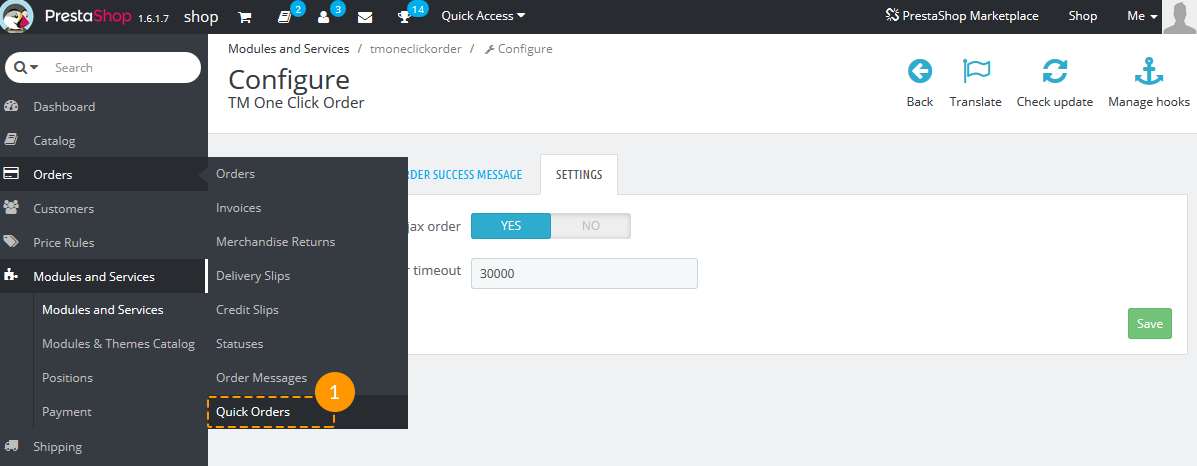
It has four tabs - New, Created, Removed and Search.
-
New - new preorders that have been submitted by the customers.
In the left part there's a button to create a new preorder (1) and a list of preorders (2).
In the right side you can see the preorder details (3) divided into tabs (Preorder information, Customer, Languages and currencies, Cart, Vouchers, Addresses, Shipping, Summary).
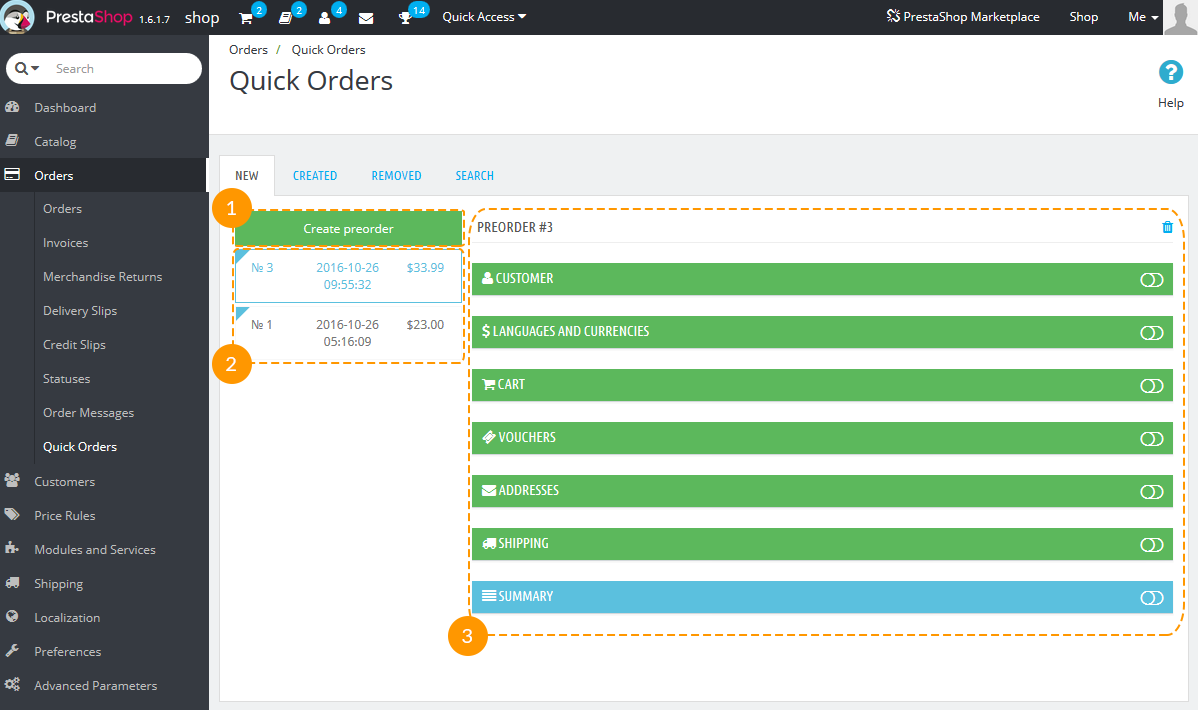
If the order has just been created, you'll see only three of them - Preorder information, Customer, Languages and currencies.
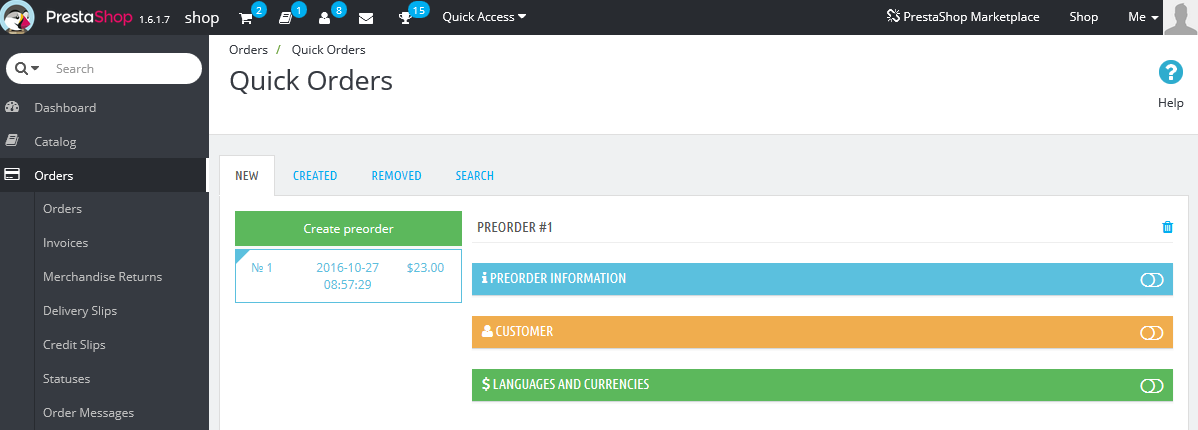
When you fill in the info about the customer, three more tabs will appear - Cart, Vouchers and Address. When the address info is added, Shipping and Summary tabs will be shown. Tabs where all required information has been successfully added, are colored with green. Yellow colored tabs require some more order details. Blue ones are informational, they are generated automatically.
When the Summary tab appears, there's a button 'Create the order' in Summary tab (1).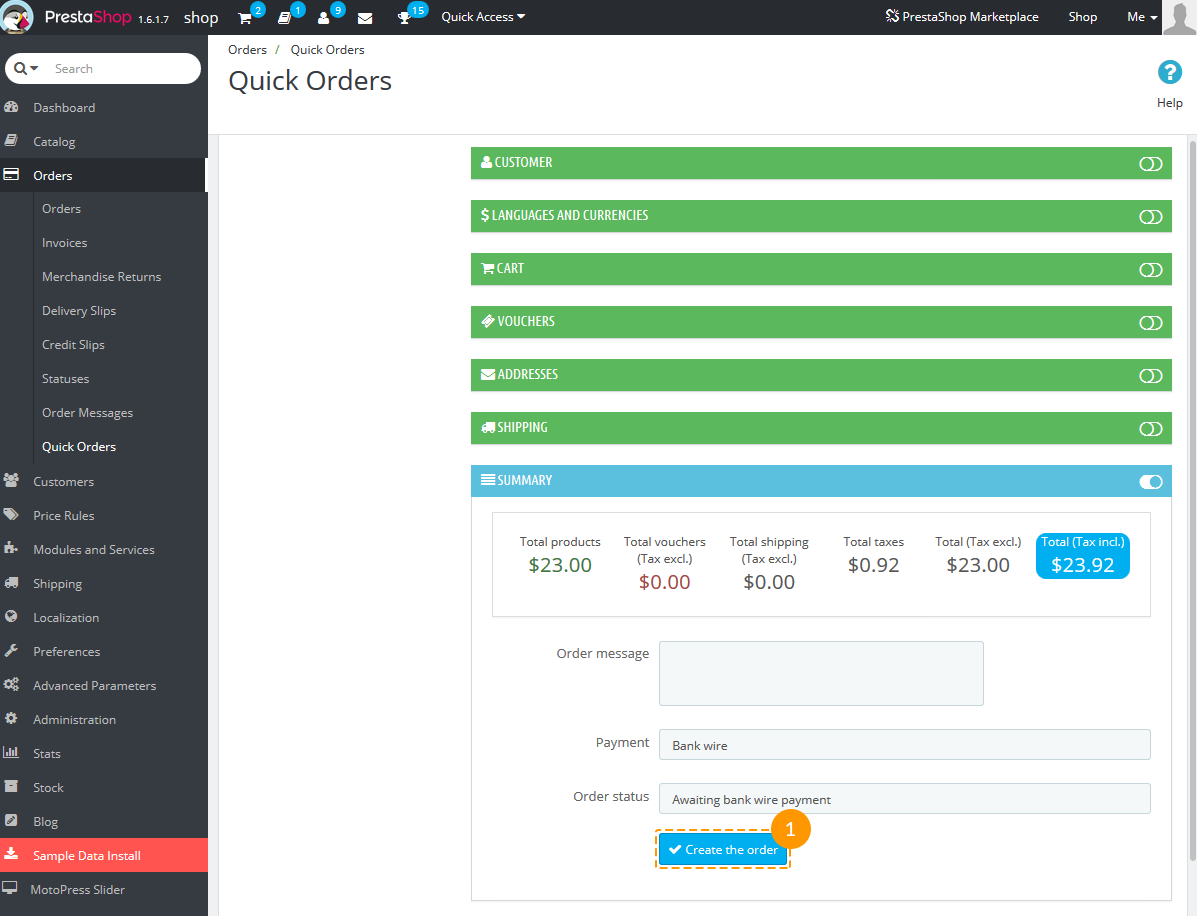
After clicking it the preorder will be transferred from 'New' to the 'Created' preorders list (1).
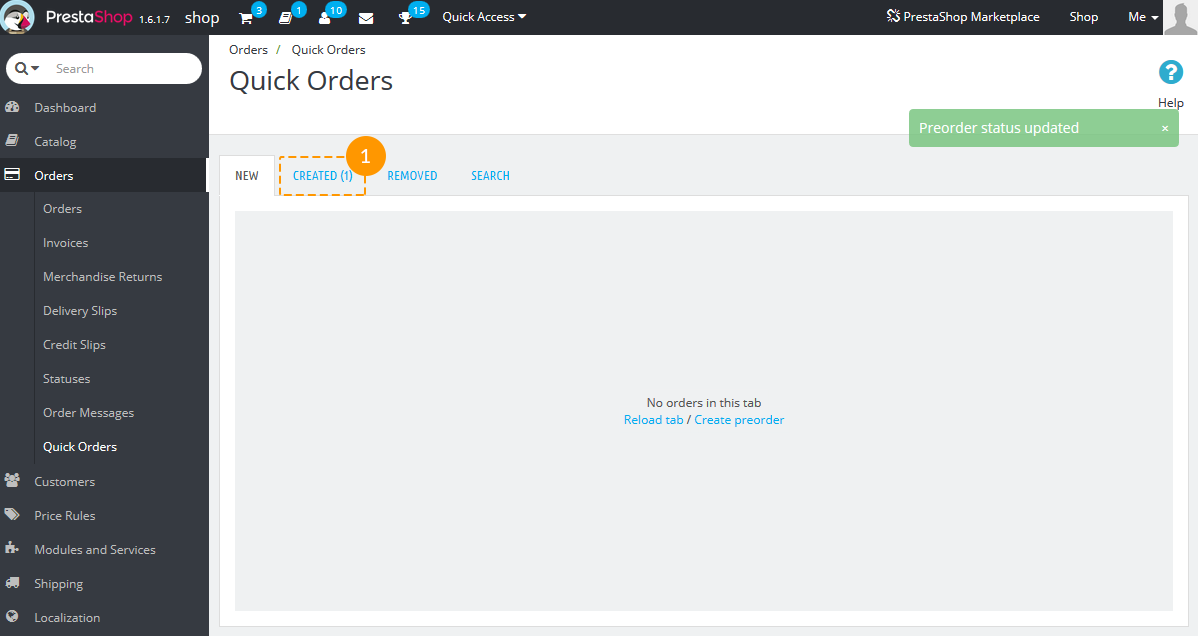
If you need to delete the order, there's a trash sign in the top right corner (1).
Press it and the preorder will be transferred to 'Removed' orders tab.
-
Created - preorders that have been already processed by the administrator.
Choose the order in the left side and click on it to see the detailed info in the right side.
You can also click the 'Show' link to see full information about the customer (1), about the order (2) and the employee (3).
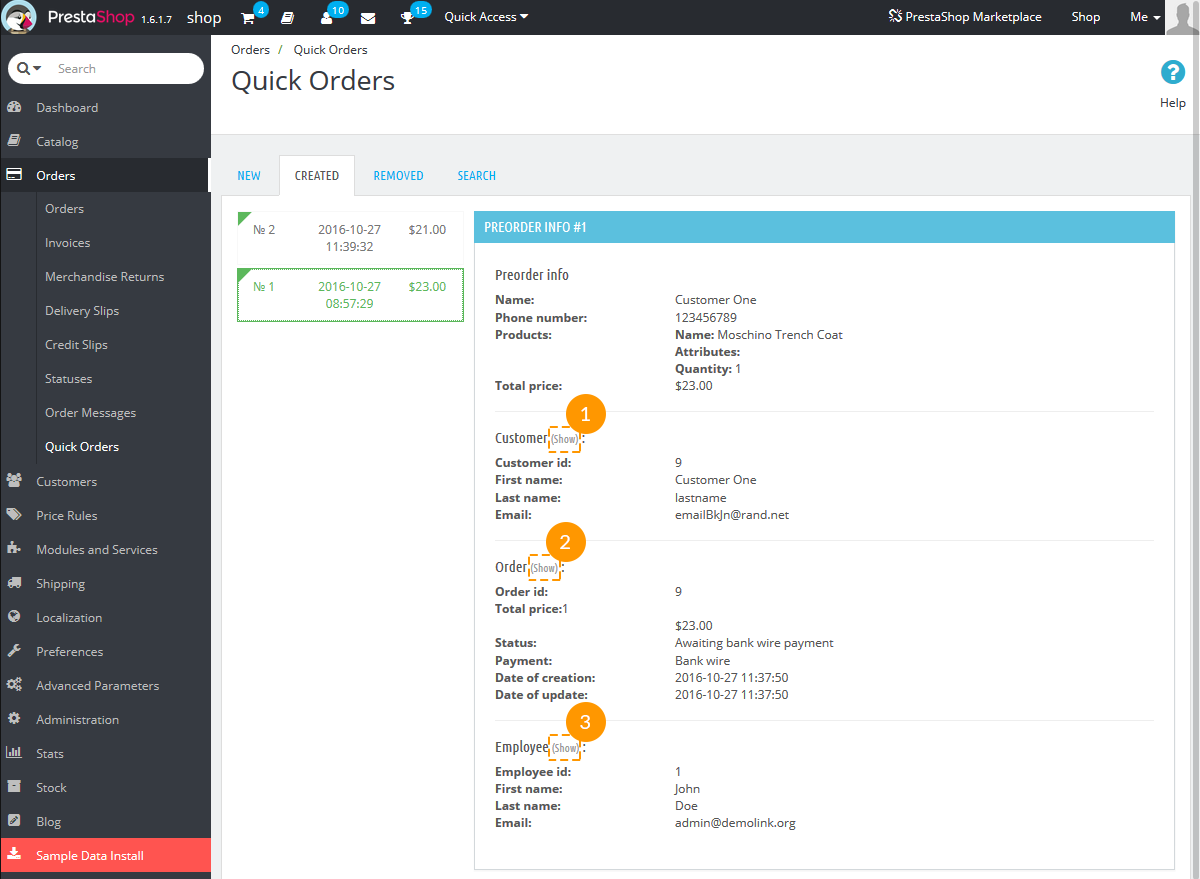
-
Removed - preorders that have been cancelled.
The preorder in this tab can still be recovered by clicking the '+' button (1). Then it will be transferred back to 'New' preorders tab.
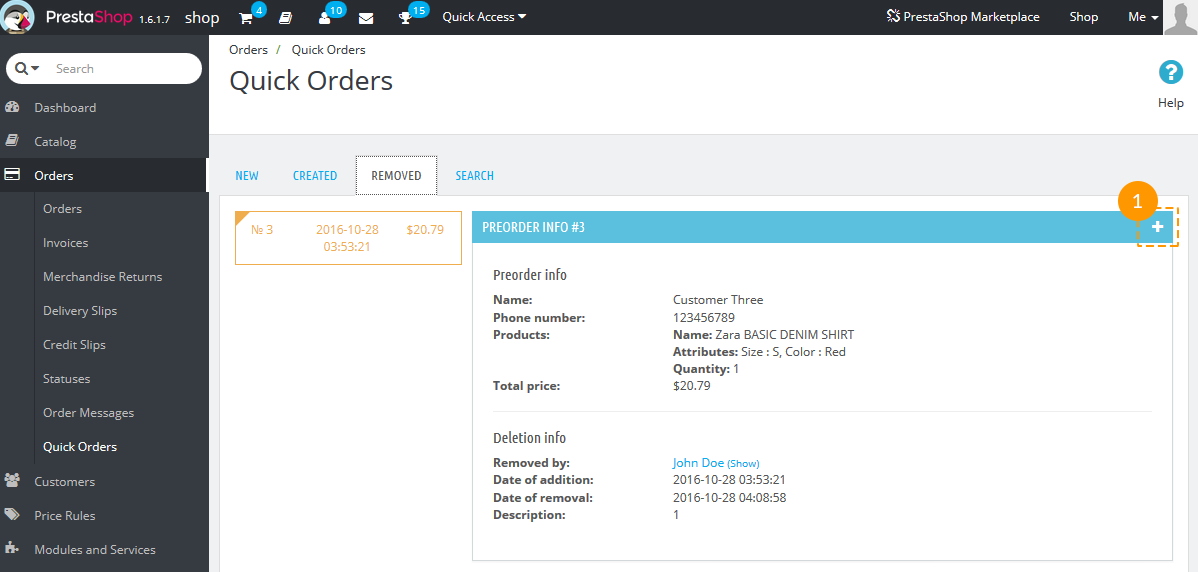
-
Search - preorders search. Enter the search (by customer info, employee info, order id, preorder id); you can also enter the specific date/date period when preorders were created.
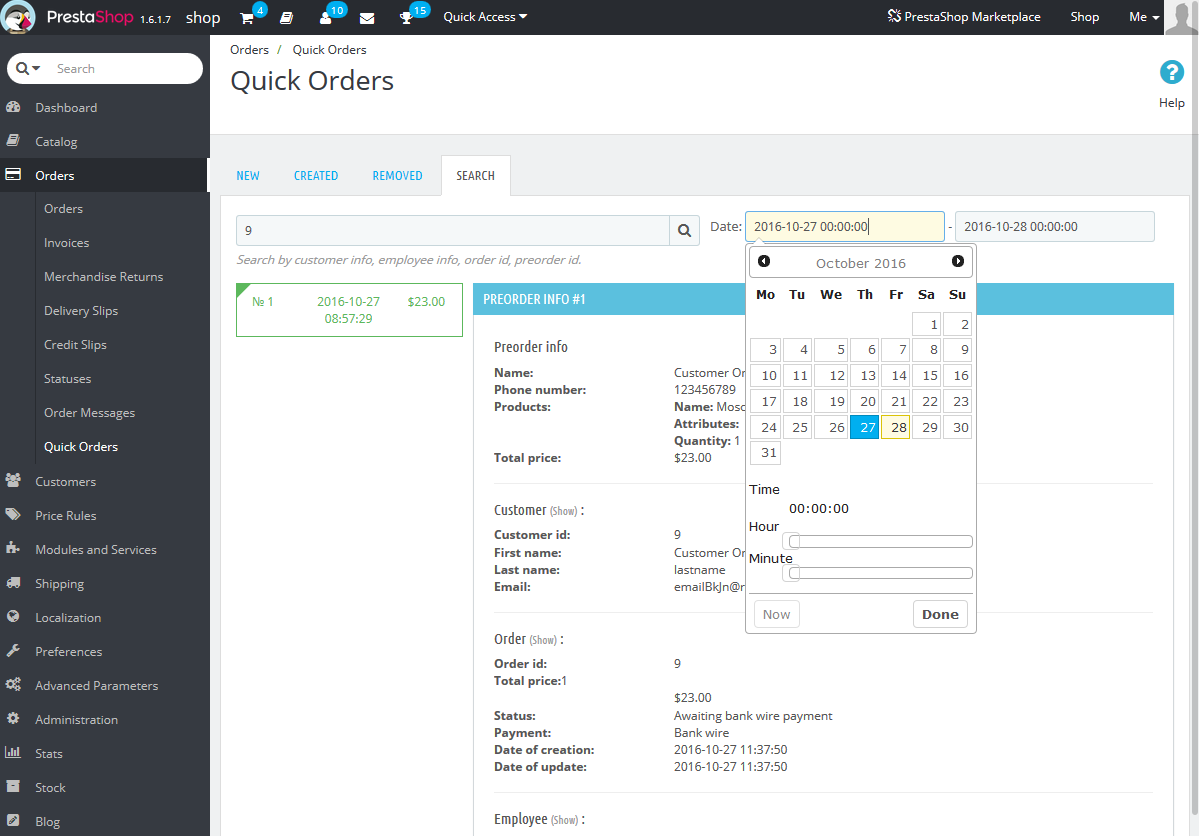
TM Product List Gallery 2.0.0
Available in:
Fashion, Electronics, Spare Parts, Furniture, One Product
This module displays all the available product images in form of a gallery on product listing pages. Depending on what settings you choose, the module can display images in form of a rollover or slideshow.
Module Installation and Deleting
This module can be installed and deleted like any other PrestaShop module.
Module settings
After the module is installed, open the product-list.tpl file in your template root folder, find the following
code:

and replace it with:
{capture name='displayProductListGallery'}{hook h='displayProductListGallery' product=$product}{/capture}
{if $smarty.capture.displayProductListGallery}
{hook h='displayProductListGallery' product=$product}
{else}
<a class="product_img_link" href="{$product.link|escape:'html':'UTF-8'}" title="{$product.name|escape:'html':'UTF-8'}" itemprop="url">
<img class="replace-2x img-responsive" src="{$link->getImageLink($product.link_rewrite, $product.id_image, 'home_default')|escape:'html':'UTF-8'}" alt="{if !empty($product.legend)}{$product.legend|escape:'html':'UTF-8'}{else}{$product.name|escape:'html':'UTF-8'}{/if}" title="{if !empty($product.legend)}{$product.legend|escape:'html':'UTF-8'}{else}{$product.name|escape:'html':'UTF-8'}{/if}" {if isset($homeSize)} width="{$homeSize.width}" height="{$homeSize.height}"{/if} itemprop="image" />
</a>
{/if}
After installing and connecting the module, you can set it up on the module configuration page.
The module has the following main settings:
- Type - select display type: rollover or slideshow.
If you choose rollover, you can choose the animation effect:

- Opacity slide - opacity changes;
- Horizontal slide - horizontal;
- Vertical slide - vertical.
If you choose slideshow, you will find the following settings available:
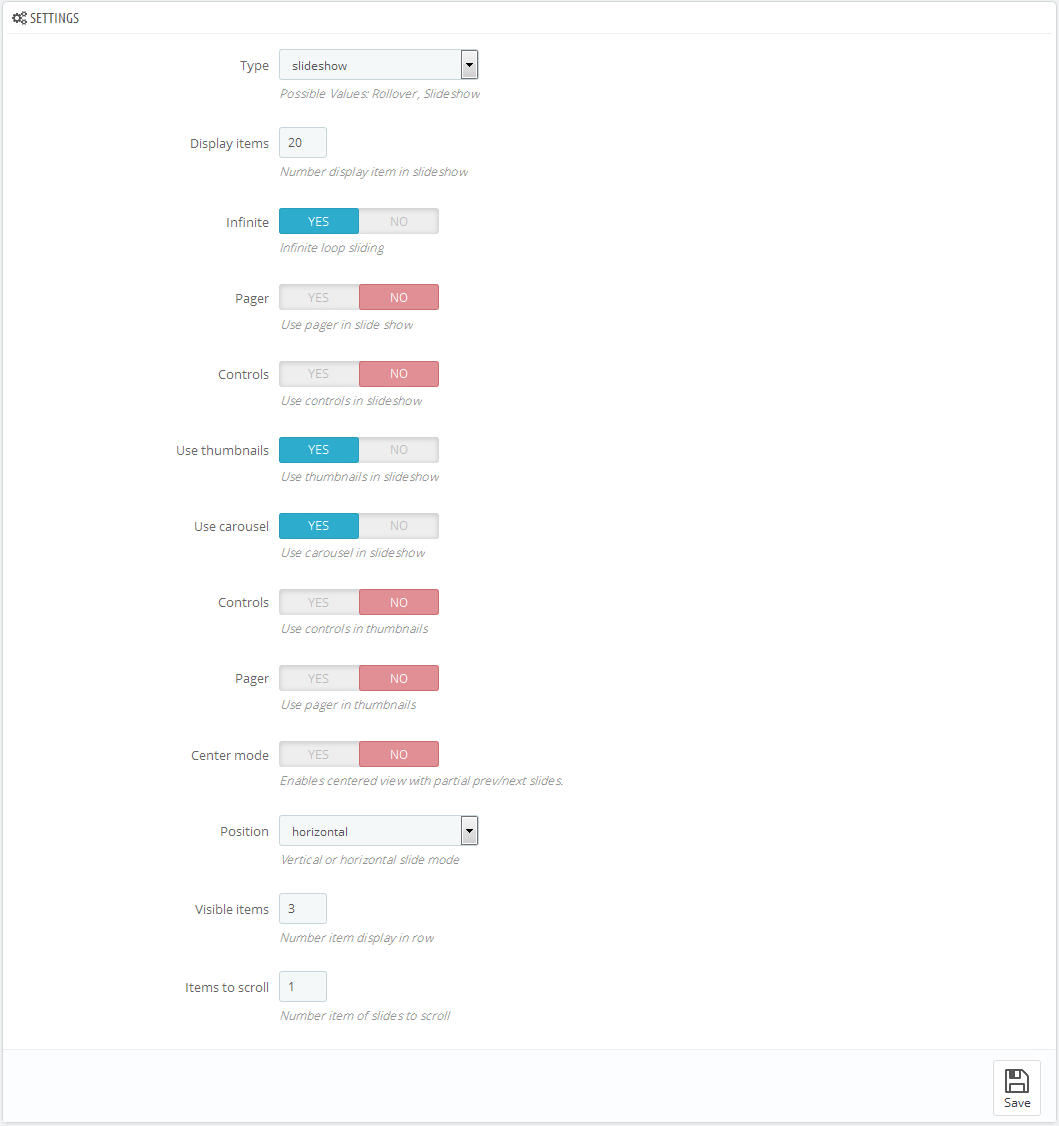
- Display items - the number of items displayed;
- Infinite - endless slideshow cycle;
- Pager - pager display in slide show;
- Controls - controls display in slide show;
- Use thumbnails - slideshow thumbnails display;
- Pager - pager display in thumbnails carousel;
- Controls - controls display in thumbnails carousel;
- Position - vertical or horizontal carousel mode;
- Center mode - centering the thumbnails carousel view;
- Visible items - the number of items in a row;
- Items to scroll - the number of scrolled items in thumbnails carousel.
TM Product Videos
Available in:
Fashion, Electronics, Spare Parts, Furniture, One Product
This module allows to add unlimited number of videos to any product in any language and store.
Installation and deleting
The module is installed and deleted like any other Prestashop module. It has no configuration page and supports multi-stores.
After module installation you will see the new tab in your product configuration page (Catalog -> Product -> select any product - TM Product Videos).
To add a video to any product, you should fill in the required fields (the link field is mandatory). The module is multilanguage, so you will have to fill in the fields for all languages this video is related to. If the Link field is not filled for any language, then the video will not be added for this language. The module is supposed to show up videos from Youtube and Vimeo, so you need to add links only from these resources. After making the changes, click 'Save'/'Save and Stay' button to save them.
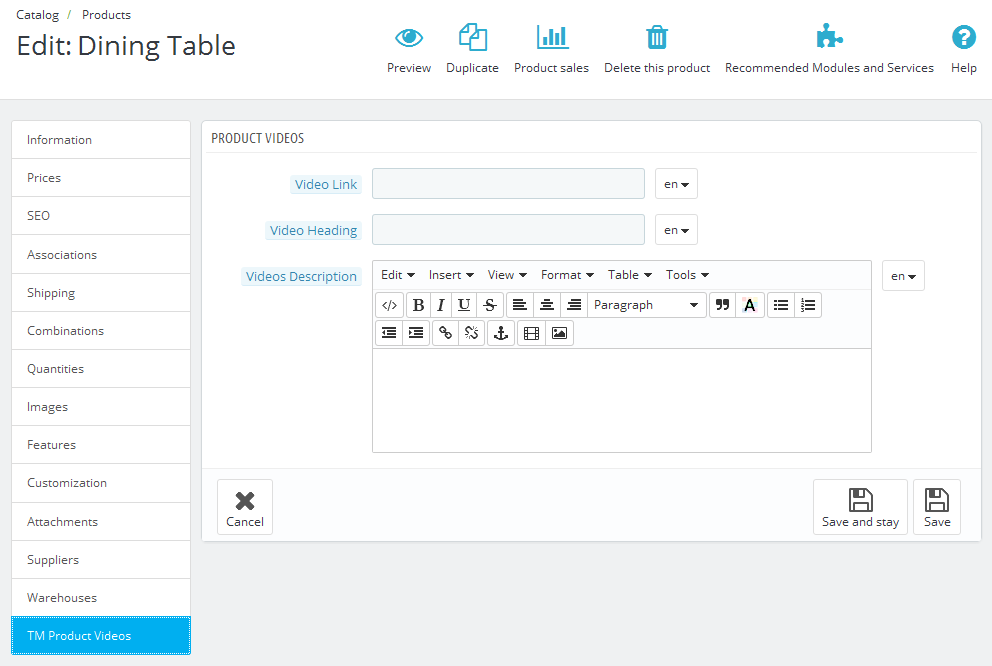
Examples of links
To display video properly, the links should have the following format:
-
- Youtube
https://www.youtube.com/embed/K6VcTyaym90
-
- Vimeo
http://player.vimeo.com/video/66140585
If the product has video related to this language, you will see the list of videos below.
To save, delete or edit the list, there is no need to click 'Save'/'Save and Stay' button. Use the buttons located in the video blocks. To change the order of videos, use drag-and-drop method to change their position. To enable/disable the video, use the button next to video. To edit videos, fill in the fields with required data and click 'Update' button.
To remove the video from the list, click 'Remove video' button.
While switching languages, only the list of videos related to the language will show up.
To view the video in zoomed format, click 'Zoom' button under this video.
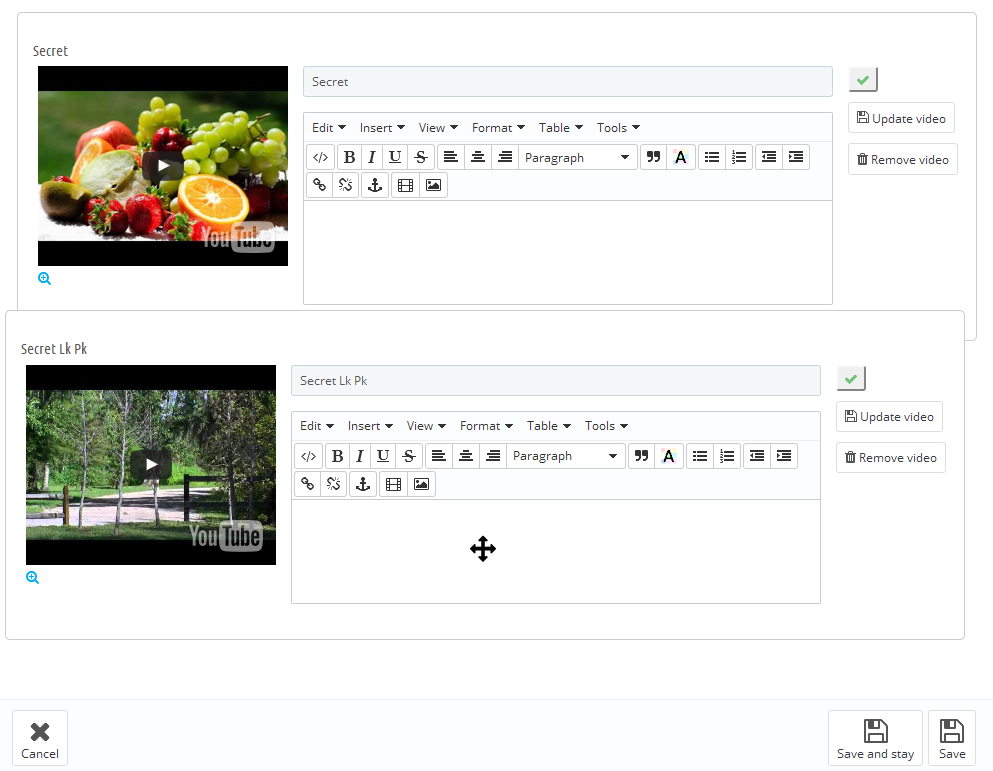
TM Product Zoomer
Available in:
Fashion, Electronics, Spare Parts, Furniture, One Product
This module is an alternative solution for the standard product image zoom on the single product page. It's fully compatible with the standard additional products thumbnail carousel and product attributes changes. It allows you to choose among the three available options (window/lens/inner) for image zoom with the advanced plugin settings. The module is based on the Elevatezoom Plus plugin.
Installation and removing
The module is installed and deleted like any other Prestashop module. After module has been installed the standard product zoom effect will be automatically disabled. After deleting the module standard effect should be enabled back manually (if needed) in the Preferences -> Products -> Enable JqZoom instead of Fancybox on the product page section.
Module configuration
After the module has been installed you can configure it on the module configuration page.
By default the configuration page shows the simplified set of options.
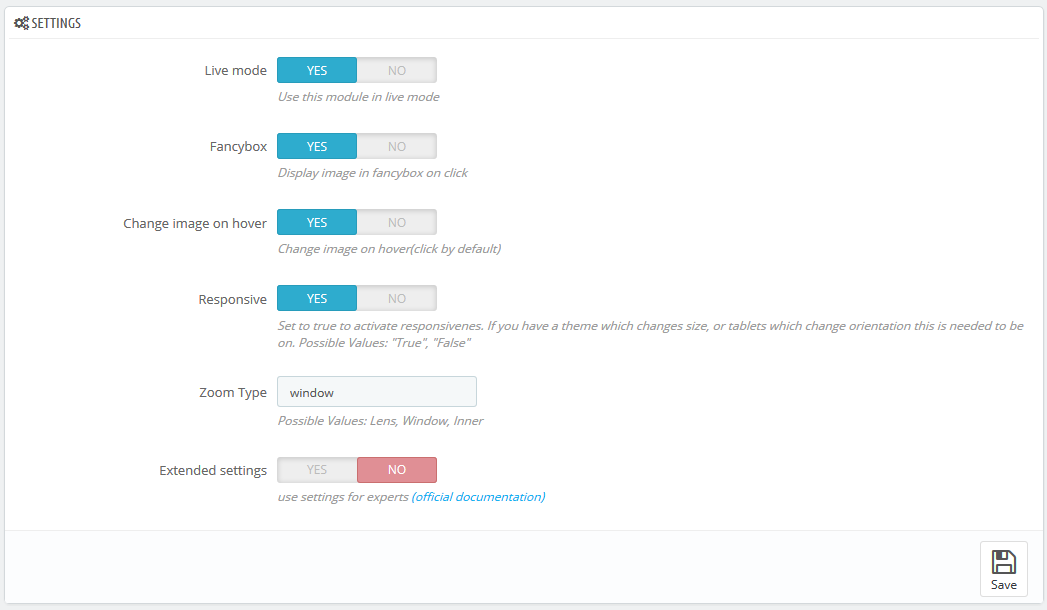
- Live mode - module is on/off.
- Fancybox - whether to show the enlarged image in the Fancybox on click.
- Change image on hover - switch the main image on thumbnail hover (by default is set to switch on click).
- Responsive - allows to the use adaptive functionality for plugin display on the mobile devices.
- Zoom Type - choose the type of the enlarged image display mode
- window - the enlarged image shows up next to the main image in one of the available (16) positions
- lens - the image is zoomed in the lens container, on top of it
- inner - the image is zoomed inside of main image container, fully covering it.
The mobile devices (< 768) have "lens" mode activated instantly. - Extended settings - enables advanced settings for the experienced users. You can see the link to the official documentation for more details next to it.
Extended module configuration
- Scroll Zoom - zoom ratio change on the mousewheel scroll (available for all types).
- Cursor - cursor type on the magnified image hover. The following options are available: default, cursor, crosshair (available for all types).
- Zoom settings - available for all types, if the 'Scroll Zoom' is enabled.

- Zoom Level - the zoom level on the initial hover
- Min Zoom Level - a minimum zoom level
- Max Zoom Level - a maximum zoom level
- Scroll Zoom Increment - magnifying scroll increment
- Easing - the magnified image appearance effect (available for all types).

- Zoom Easing - effect on/off
- Easing Amount - effect delay value
- Image Crossfade - main image blur outside the hover area (the lens) - available for window, lens.
- Magnified image window settings - available for window.
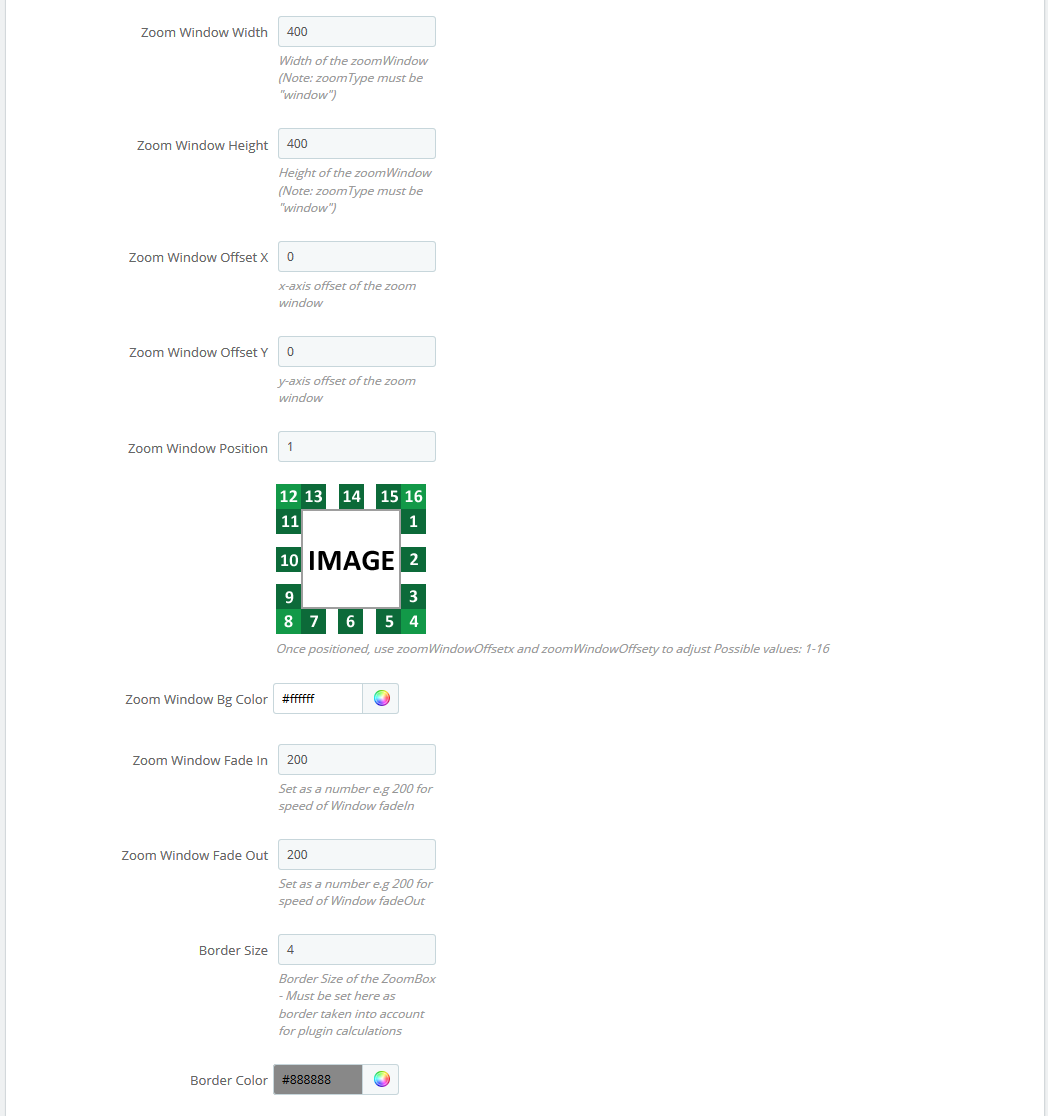
- Zoom Window Width - window width in px
- Zoom Window Height - window height in px
- Zoom Window Offset X - window offset on the X axis
- Zoom Window Offset Y - window offset on the Y axis
- Zoom Window Position - window position choice relatively to the main image (the positions available are presented on the image below this field)
- Zoom Window Bg Color - window background image (for transparent images only)
- Zoom Window Fade In - the effect of slowing the window appearance
- Zoom Window Fade Out - the effect of slowing the window disappearance
- Border Size - window border width in px
- Border Color - window border color
- Zoom Lens - zoom lens (available for window, lens).
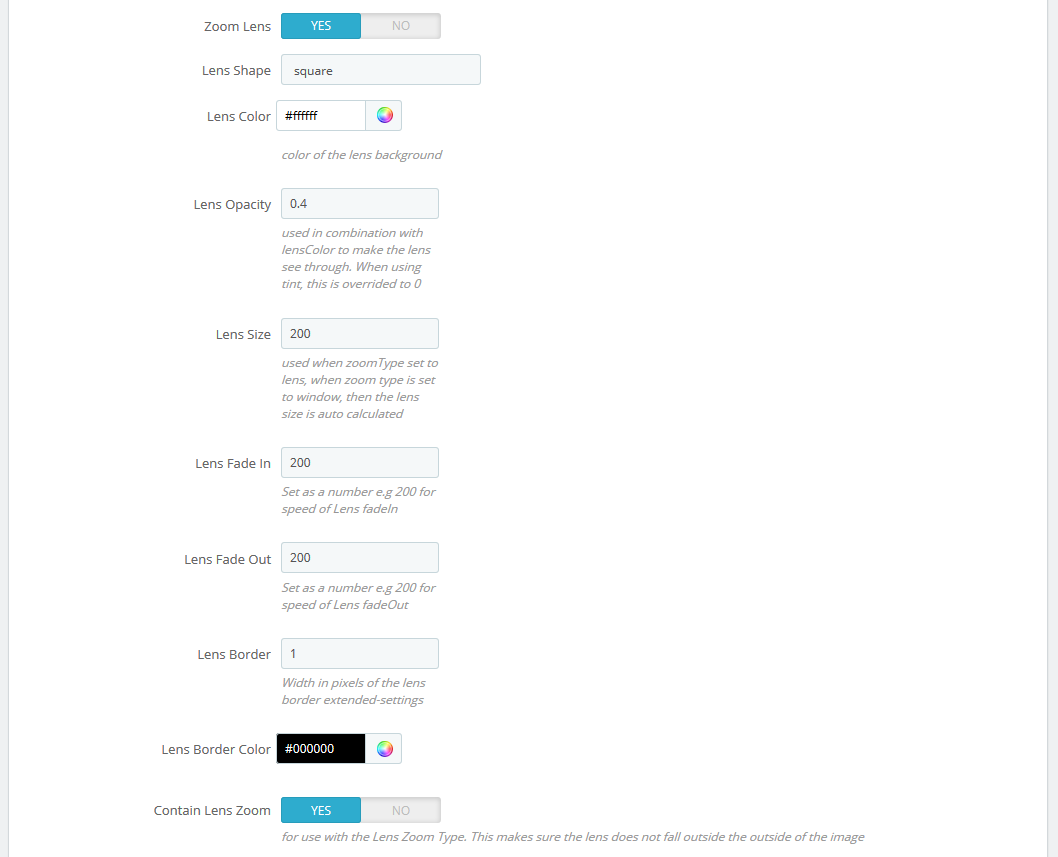
- Zoom Lens - on/off
- Lens Shape - lens type. It can take the following values: circular/rounded or squared/rectangular
- Lens Color - lens inner background color
- Lens Opacity - lens inner background opacity
- Lens Size - lens size in px
- Lens Fade In - the speed of lens appearance effect
- Lens Fade Out - the speed of lens disappearance effect
- Lens Border - lens border width
- Lens Border Color - lens border color
- Contain Lens Zoom - the restriction of the lens overflow outwards the main image container
- Tint - the shade effect on the area outside the lens (available for window).
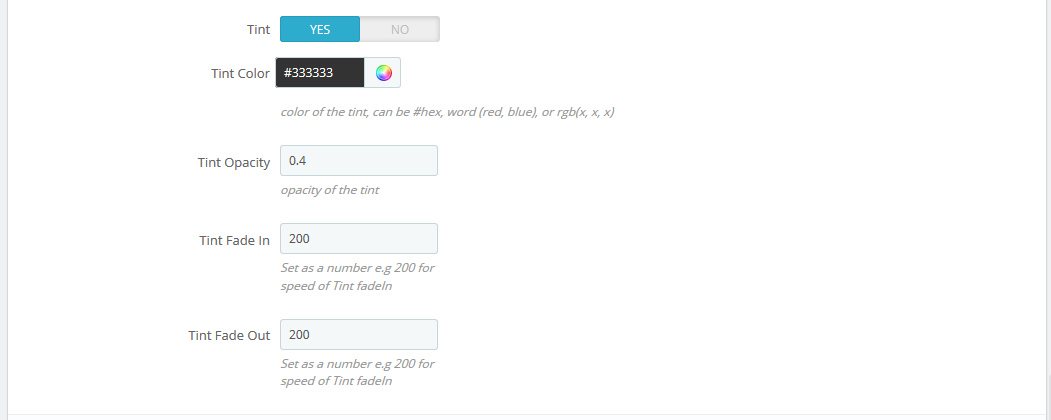
- Tint - effect on/off
- Tint Color - the lens outer area background
- Tint Opacity - the lens outer area opacity
- Tint Fade In - the appearance effect speed
- Tint Fade Out - the disappearance effect speed
TM Products Manager
Introduction
The module is created for managing online shops, especially shops with big amount of products. Using this module you can easily filter your products and make different operations on them.
Installation and removal of the module
The module is installed and removed as any Prestashop module.
Removal or re-installation of the module will not reset the changes you made using it.
When the module has been successfully installed, go to Catalog -> TM Products Manager (1) to see the module's main menu.
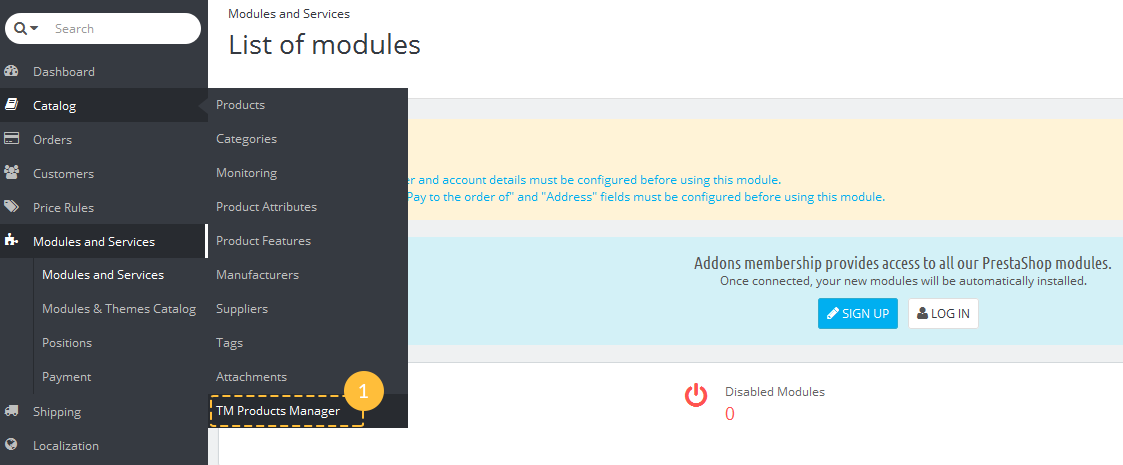
Performance
The main module menu is divided into two main parts: 'Choose section' (1) and 'Choose option' (2).
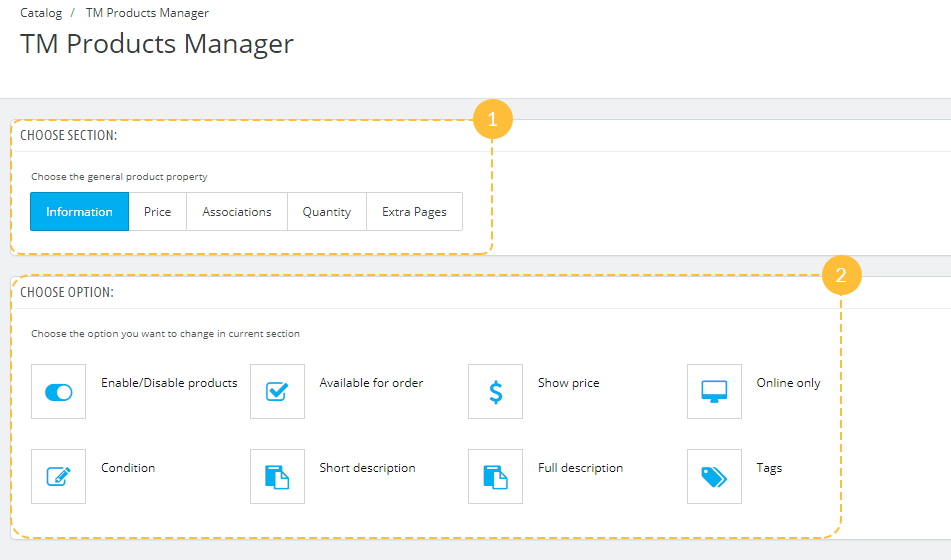
The first part is created in the form of tabs - Information, Price, Associations, Quantity and Extra Pages.

- Information - options concerning product availability and description.
- Price - price and tax rules settings.
- Associations - ability to change brand, category or accessories of several products.
- Quantity - changing products' quantity.
- Extra Pages - ability to add a new page.
-
Click each tab to see the available options in this section. They will be described further.
Each option has a hint - short description, which appears in the right when you hover the option (1).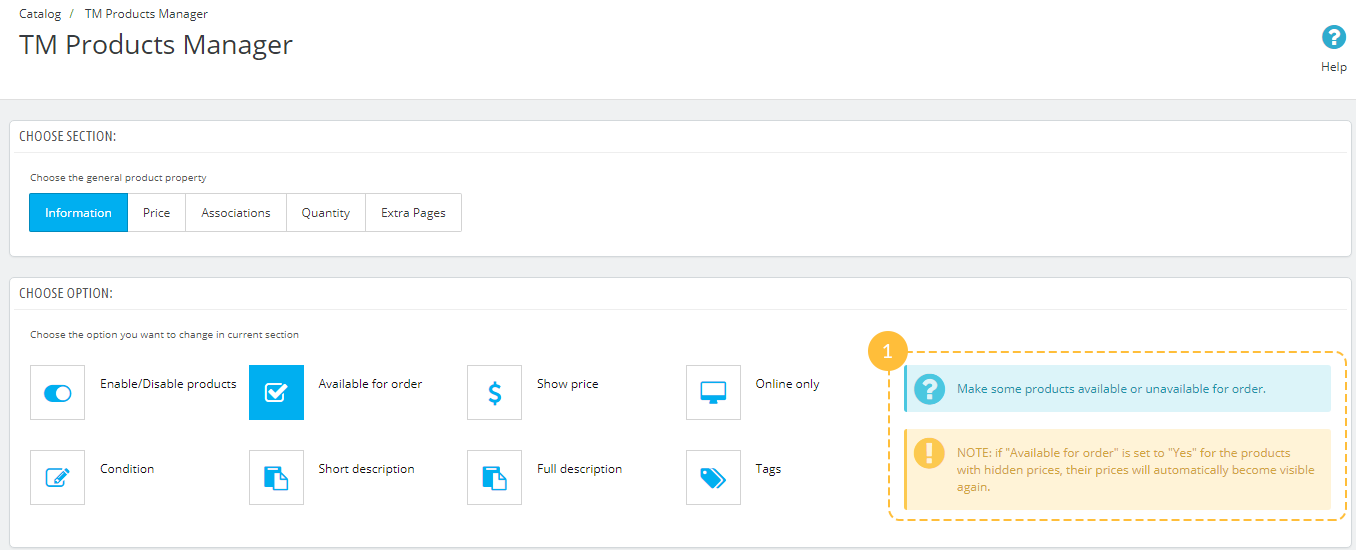
-
Choose the needed option and click it.
-
The next step is filtering products. Set the filtering options according to your needs and click the 'Select' button (1). To clear the selected filters click the 'Reset' button (2).
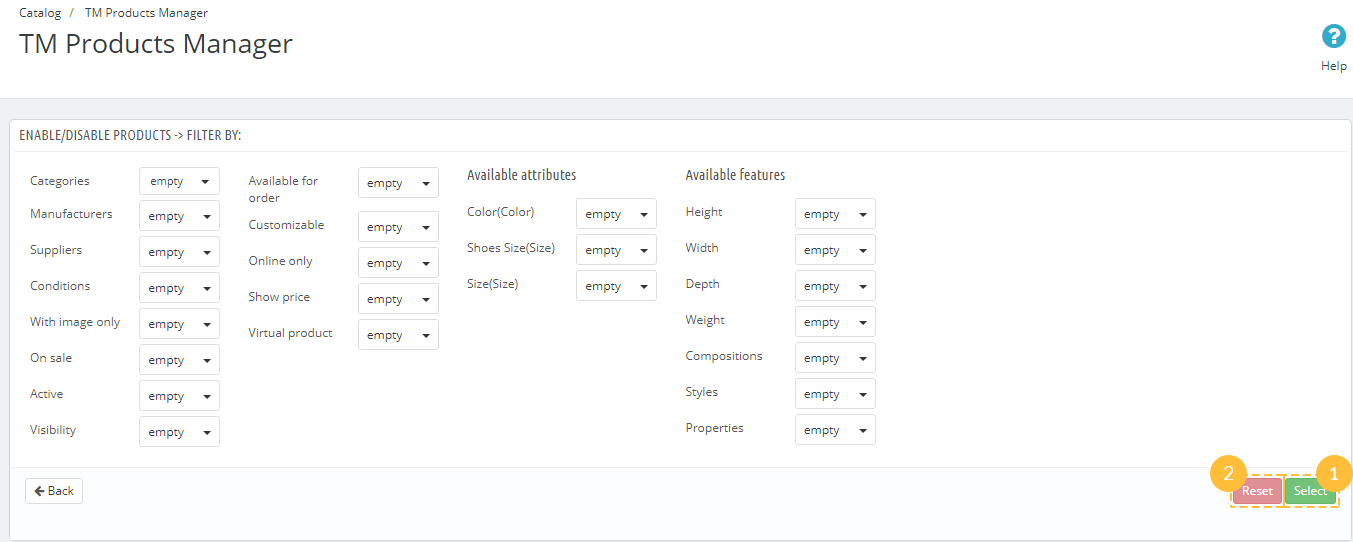
You can also cancel each of the filters after you've selected them. Simply click the cross (1) near the product property value and it will be removed.
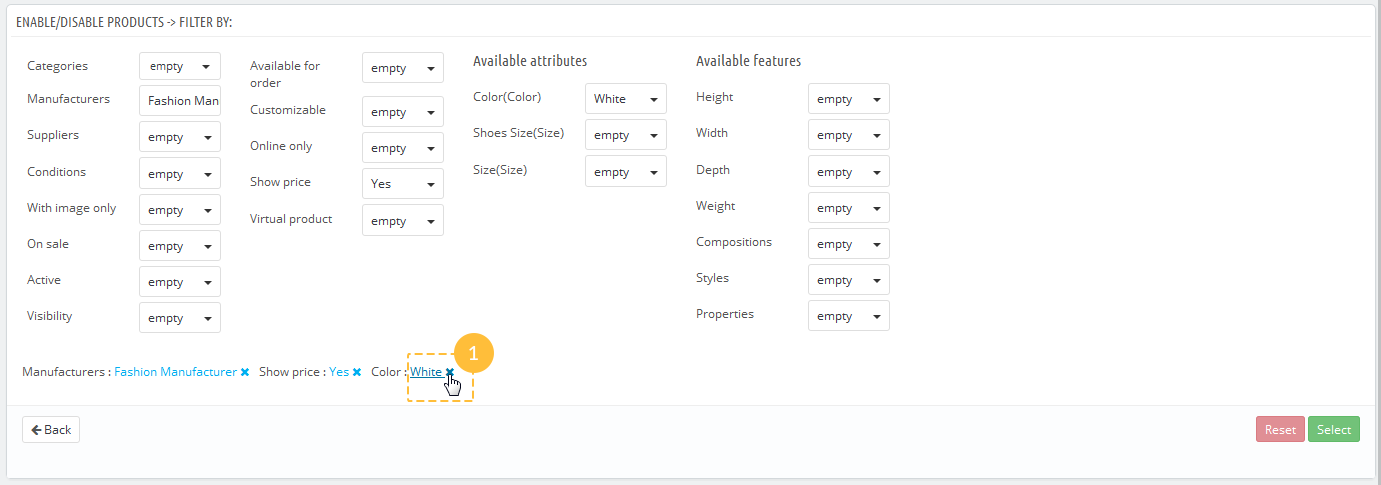
-
Below the filters there's a list of products matching the selected criteria. You can edit it lf you need to delete some of the products from the list. Each product can be removed separately by clicking 'Remove from the list' button (1). To remove all products from the list, click the 'Select all' (2) and 'Remove selected' (3) buttons. If you checked a large number of products and need to uncheck them, click the 'Unselect all' button (4).

-
When the list of selected products complies with all requirements, click the 'Process' button (1).
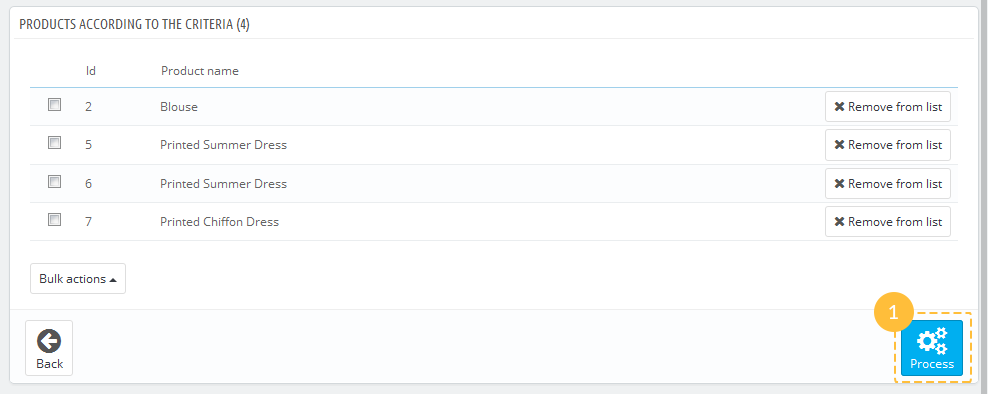
-
Set the option/options according to your needs and click the 'Save' button (1). If you need to make some changes in products list, click 'Back to filter' button (2).
Please note, that you won't be able to undo these changes the same way.
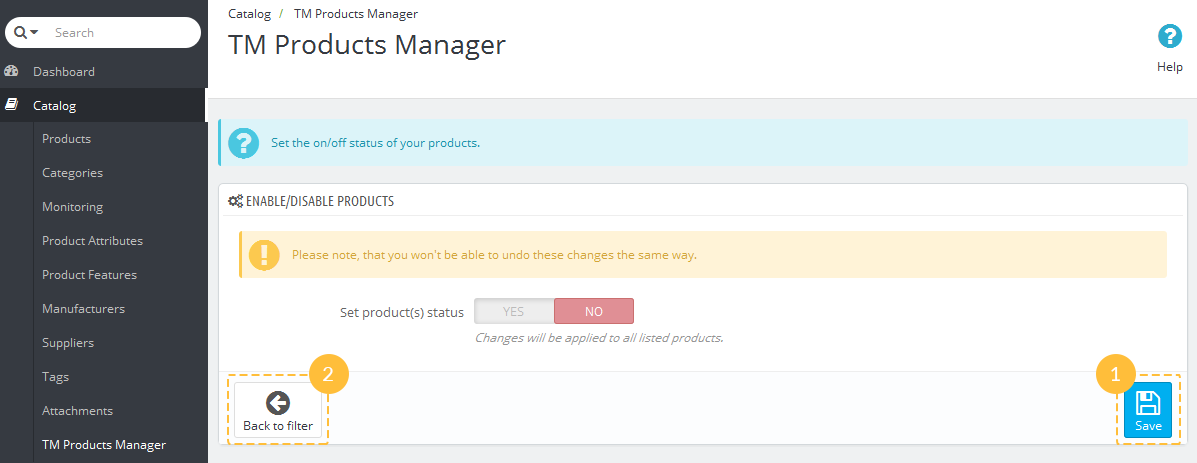
Available options
Information
The section allows to configure the following options:
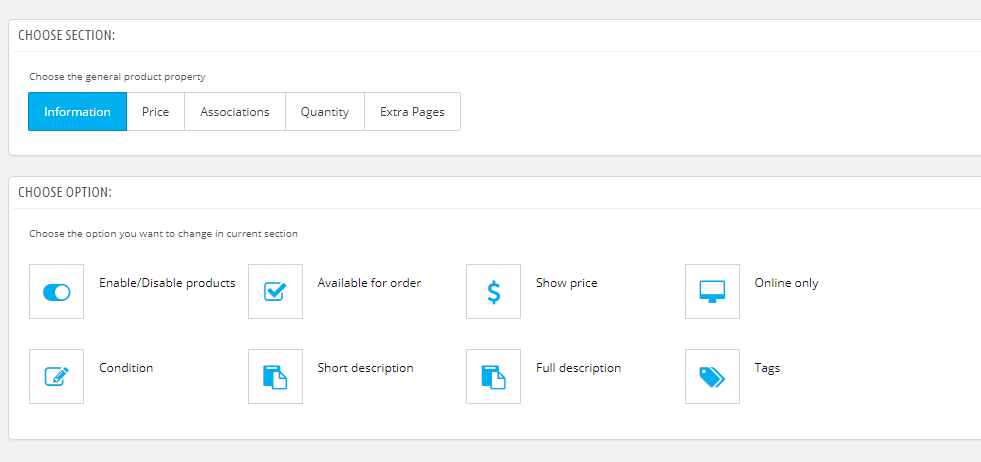
- Enable/Disable products - set the on/off status of your products.
- Available for order - make some products available or unavailable for order.
NOTE: if 'Available for order' is set to 'Yes' for the products with hidden prices, their prices will automatically become visible again.
- Show price - show or hide product price.
NOTE: if you set 'Show price' to 'No' for the products, which are available for order, they will be automatically changed to unavailable.
- Online only - apply the 'Online only' mark to the selected items.
- Condition - change the condition of multiple products.
- Short description - add a short description which should be applied to all selected products.
- Full description - add a description to selected products with an ability to place it before the main description, after it, or replace the whole description with the new one.
- Tags - add more tags to the chosen products.
Price
In this section you can change options concerning product price.
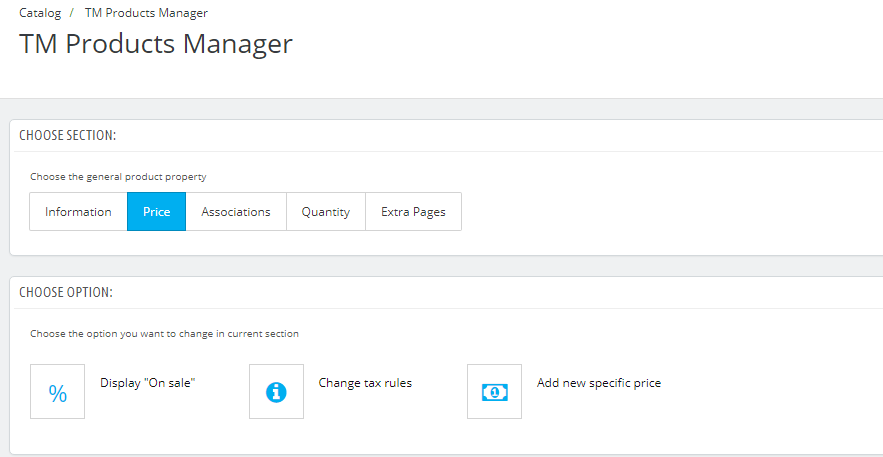
- Display "On sale" - display the selected items with 'On sale' mark.
- Change tax rules - choose the tax rules which will be applied to several products.
- Add new specific price - set the special price for selected products with an ability to add the price activation period.
Associations
Here you can change options connected with product relations.
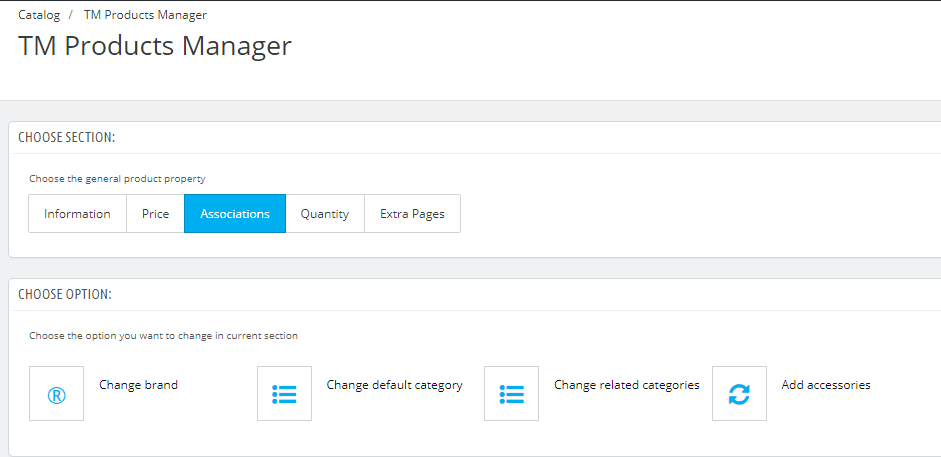
- Change brand - change brand of selected items.
- Change default category - choose the category which will be set as default for some products.
NOTE: You can choose only one default category. Keep in mind that your current default category will be replaced with the new one.
- Change related categories - set the related categories to multiple products with an ability to save or remove old relations.
- Add accessories - add the accessories suitable for the chosen products.
Quantity
This option allows to set the product quantity or increase/decrease current quantity by a certain amount.
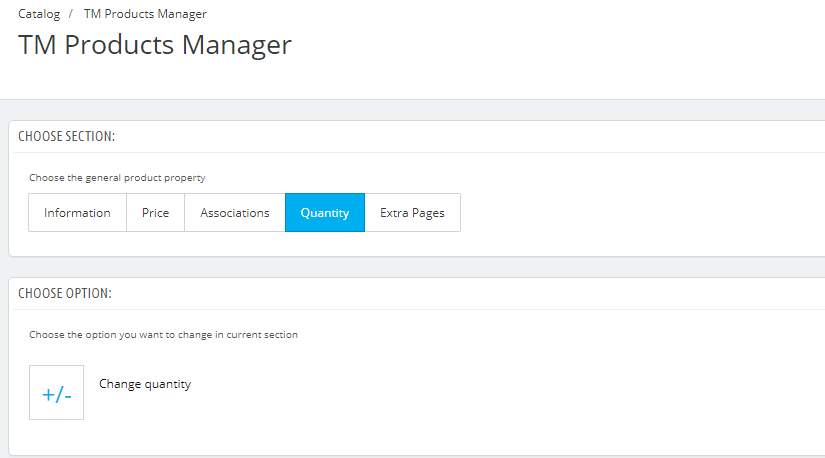
- Change quantity - set the required quantity of some products.
Extra Pages
This option allows to add a new page.
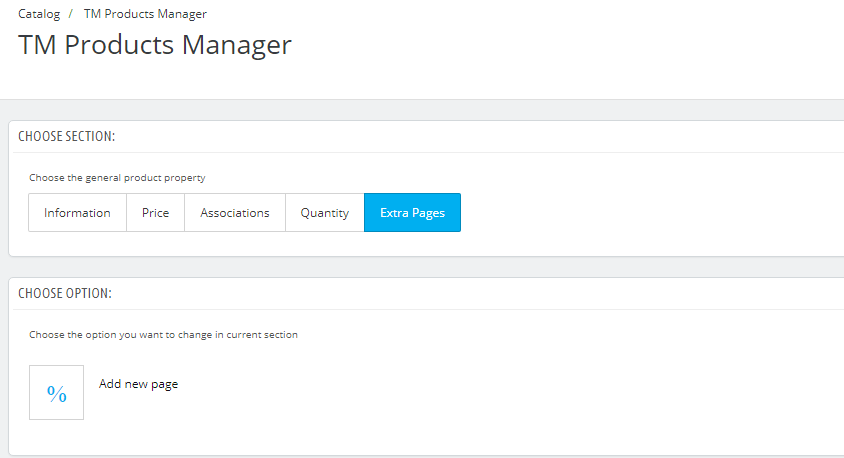
- Add new page - create a new product page.
TM Products Slider 2.0.0
Available in:
Electronics, Furniture
Introduction
This module serves for creating galleries, based on product data and displaying them in form of slides on the website frontend. The module supplies 4 methods of displaying the gallery with individual settings and appearance. Each method has pre-defined functionality. Advanced configuration is also available. The module can display an unlimited amount of products with diverse information.
Installation and removal of the module
If you have the 1.n version of this module installed in your prestashop engine, you are not suggested to update it with the current one. First you need to remove the old version of the module to run without errors.
The module is installed and removed as any default Prestashop module.
After removal or re-installation of the module, all the settings and filters are discarded.
Adding/deleting/editing a slide
Adding a slide
To add a product to the gallery, go to the needed product in the Catalog -> Products section. Then press the 'Edit' button (1) next to the needed product.
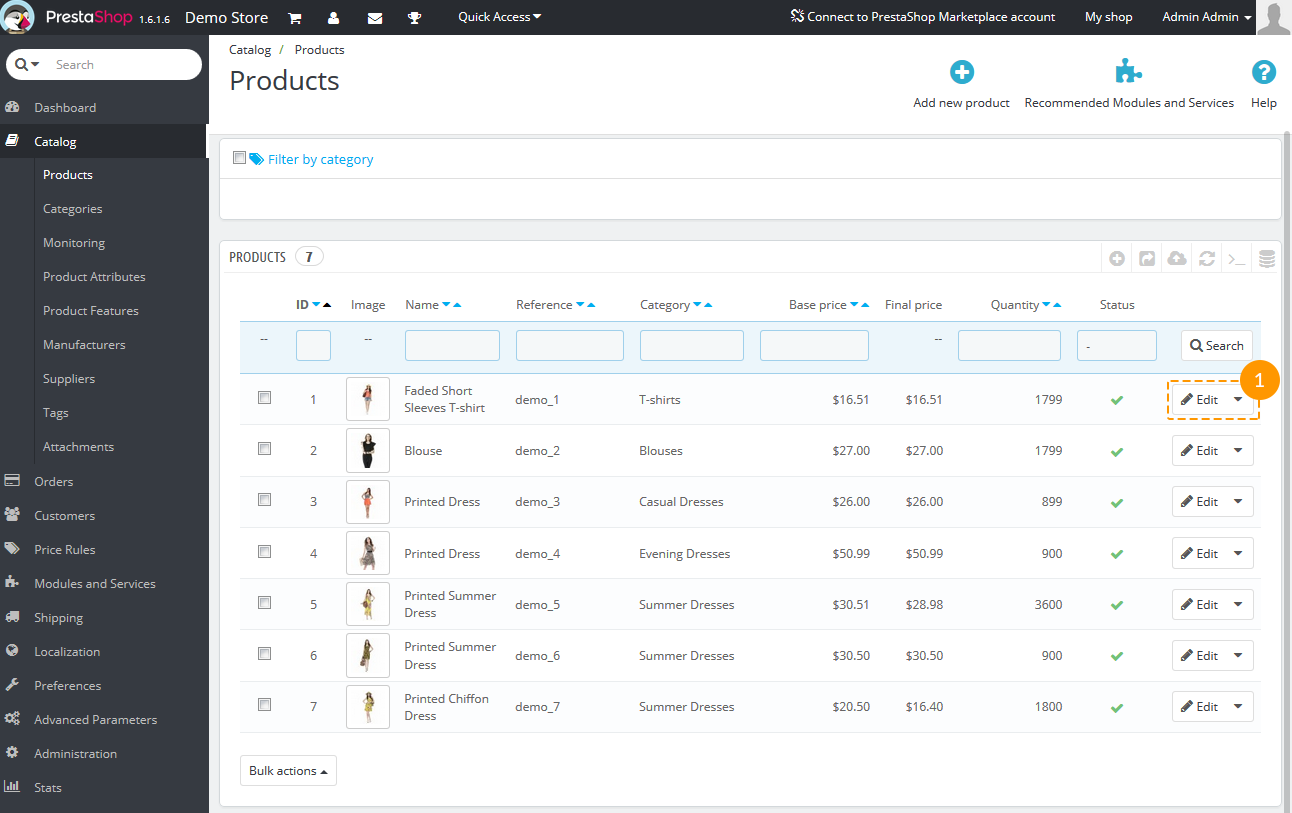
In the appeared window for editing information about the product, navigate to the TM Products Slider tab (2) and mark (3) that you want the product to be displayed in slider.
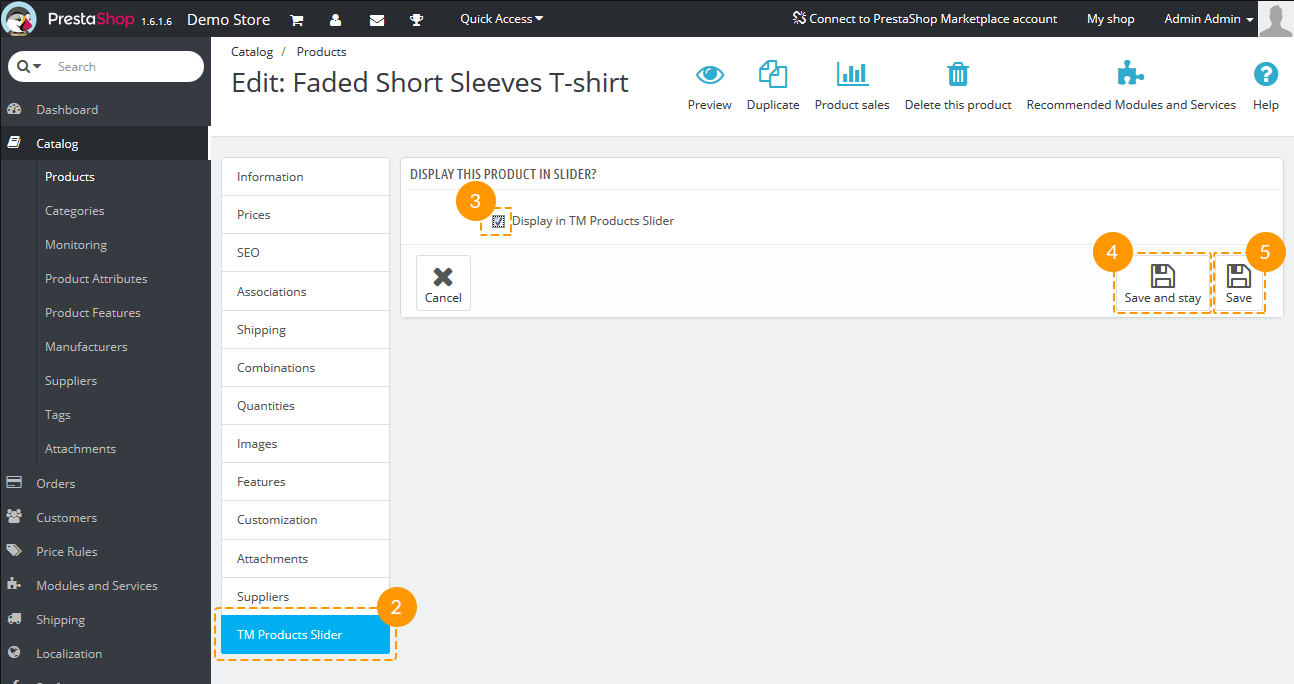
Save changes by pressing either 'Save and stay' (4) or 'Save' button (5).
Slide removal
There are two ways of deleting a slide.
-
To exclude a product from the gallery, navigate to the needed product in Catalog -> Products section. Then press the 'Edit' button (1) next to the needed product.

In the appeared window for editing information about the product, navigate to the TM Products Slider tab (2) and remove the check mark (3) which means that you don't want the product to be displayed in slider:
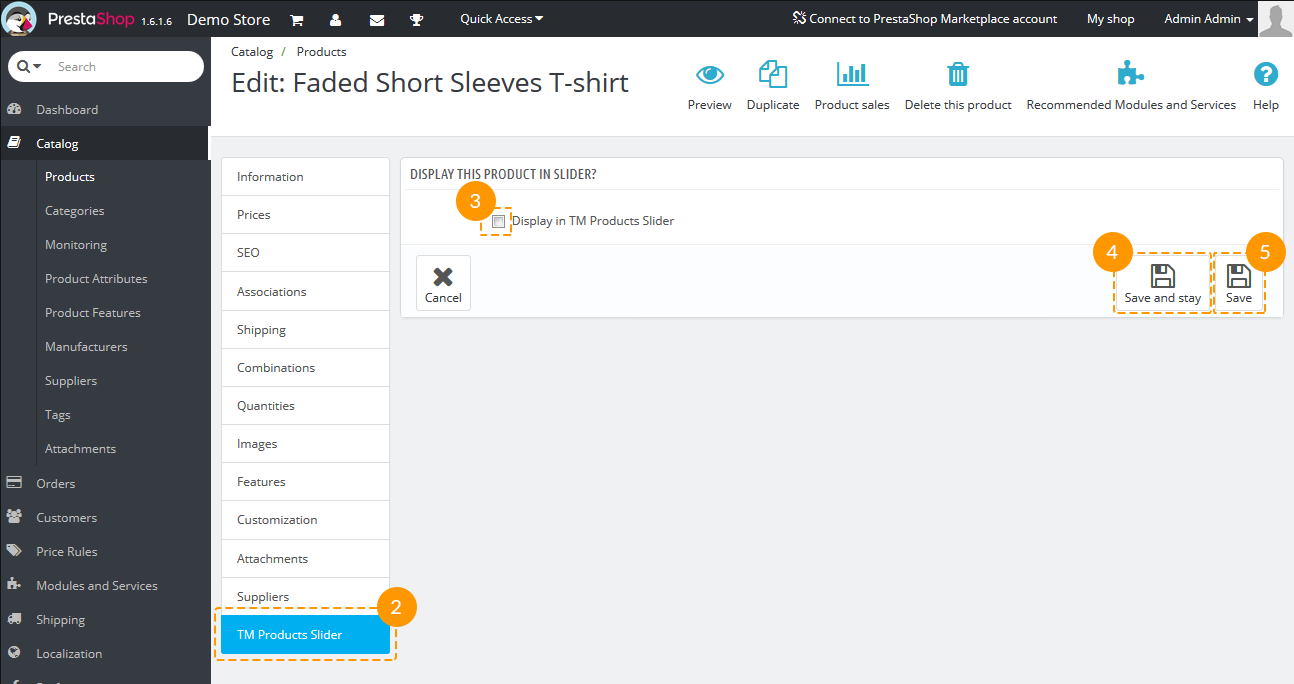
Save changes by pressing either 'Save and stay' (4) or 'Save' button (5).
-
The second way is to navigate to the module configuration page, find the needed product in the Slides list table and press the Delete button (1) next to it.

Then confirm the deletion.
Slides display order
By default, the slides are displayed in the order they were added. To change the display order, navigate to the module configuration page and drag the slide to the needed place in Slides list table.

Disabling slides
Moreover, you can temporarily disable a slide (for the time period that a product is out of stock or for any other reason) without removing it completely. To do this, navigate to the module configuration page and click a tick next to the needed product (if it's active now) or click crosses (if it's inactive) in the Slides list table:

Gallery types and recommended settings
There are four types of gallery display (standard, list, grid, full width). Each of them can be set up independently and you can switch between them if needed.
By default, the gallery uses the following product image types: large_default - for the main image; medium_default - for thumbnails.
Standard
Recommended settings:
- image size (px) - 435*435
- Gallery Width - 1170px
- Gallery Height - 580px
- Extended Settings - off
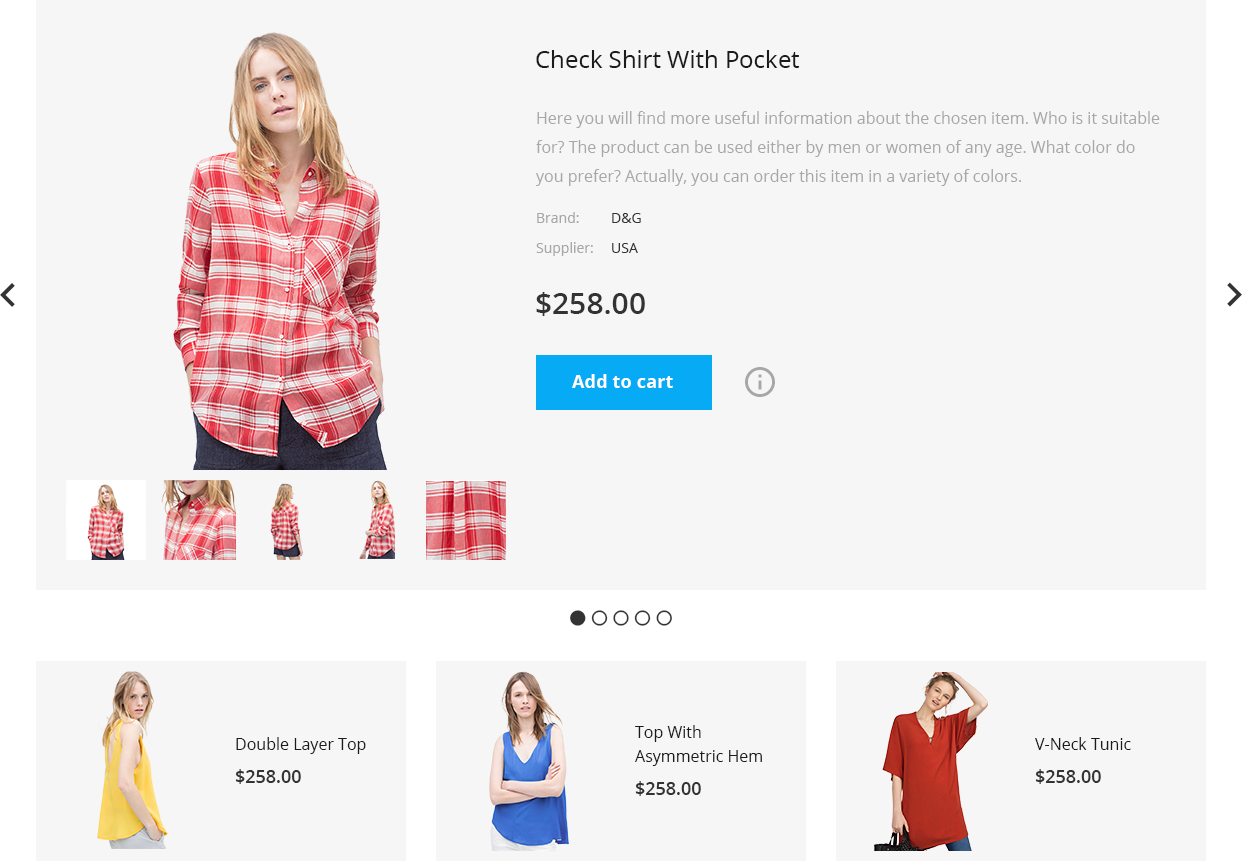
List
Recommended settings:
- image size (px) - 435*520
- Gallery Width - 1170px
- Gallery Height - 520px
- Extended Settings - off
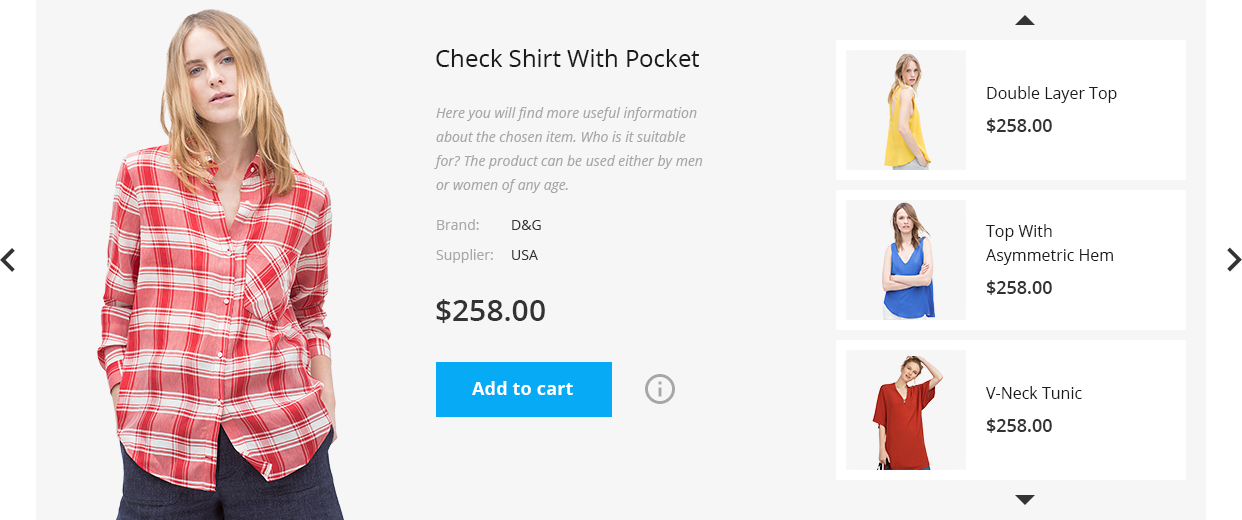
Grid
Recommended settings:
- image size (px) - 585*750
- Gallery Width - 1170px
- Gallery Height - 750px
- Extended Settings - off
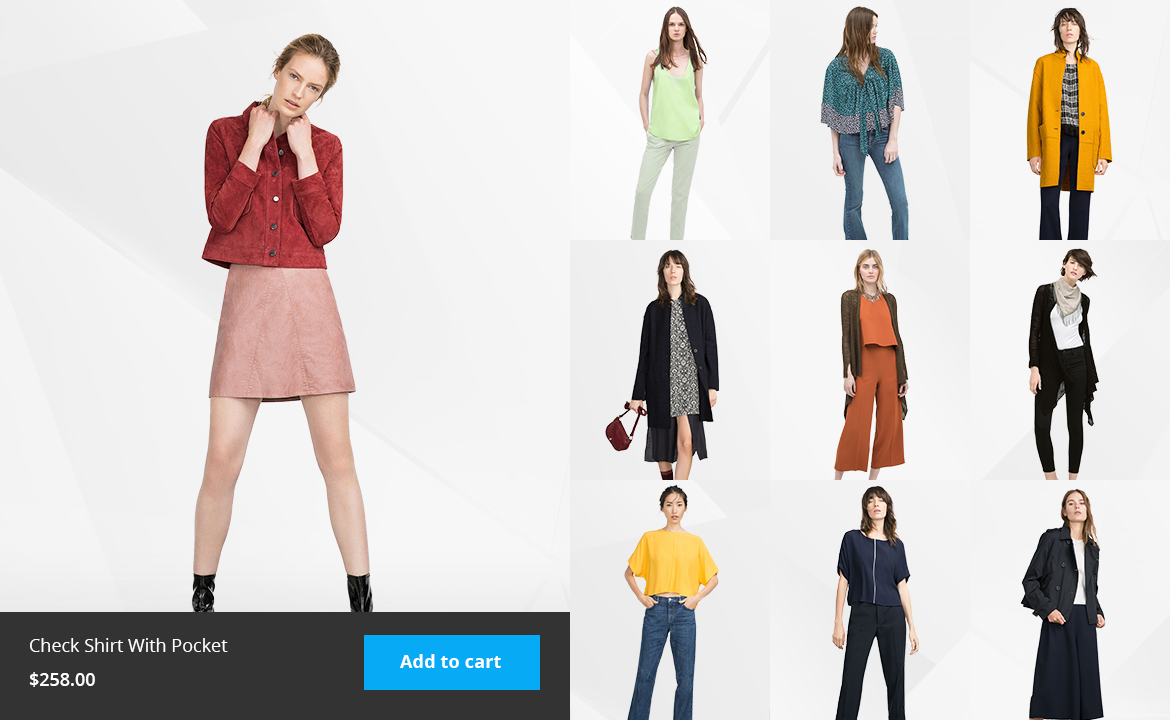
Full width
Recommended settings:
- image size (px) - 435*435
- Gallery Width - 1920px
- Gallery Height - 450px
- Extended Settings - off
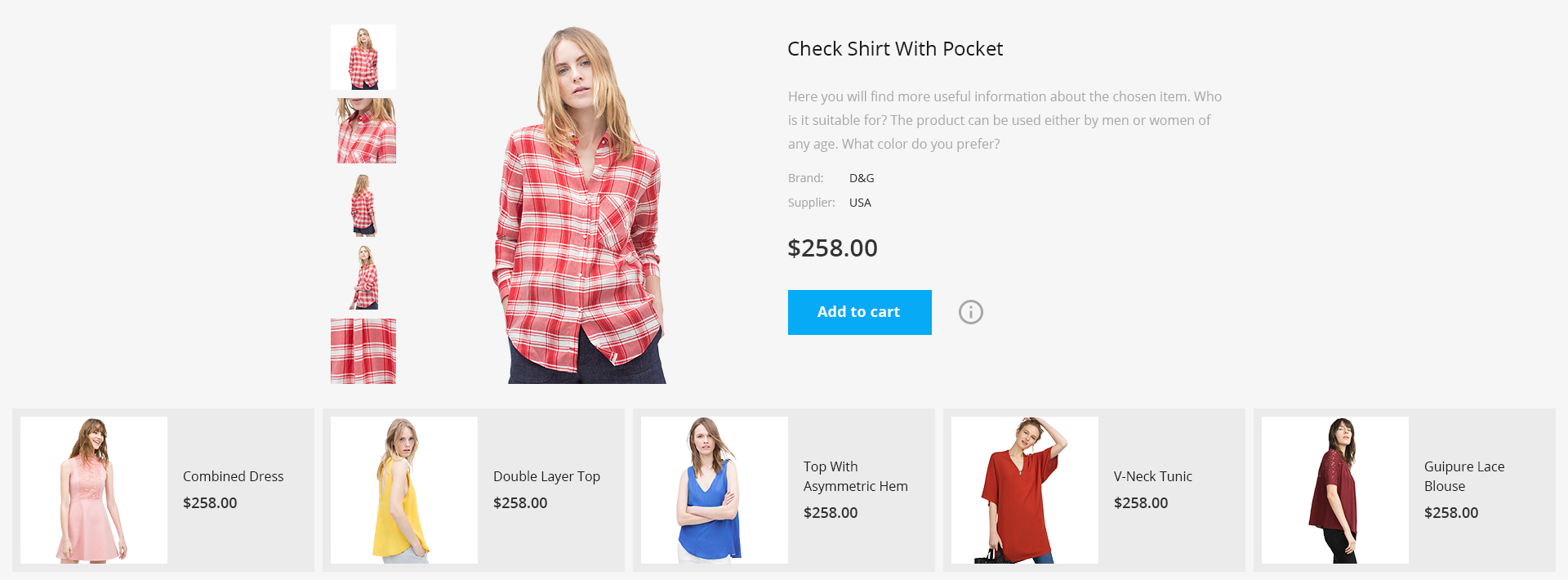
Advanced settings
To access extended settings, move the Extended Settings slider to the Yes position.
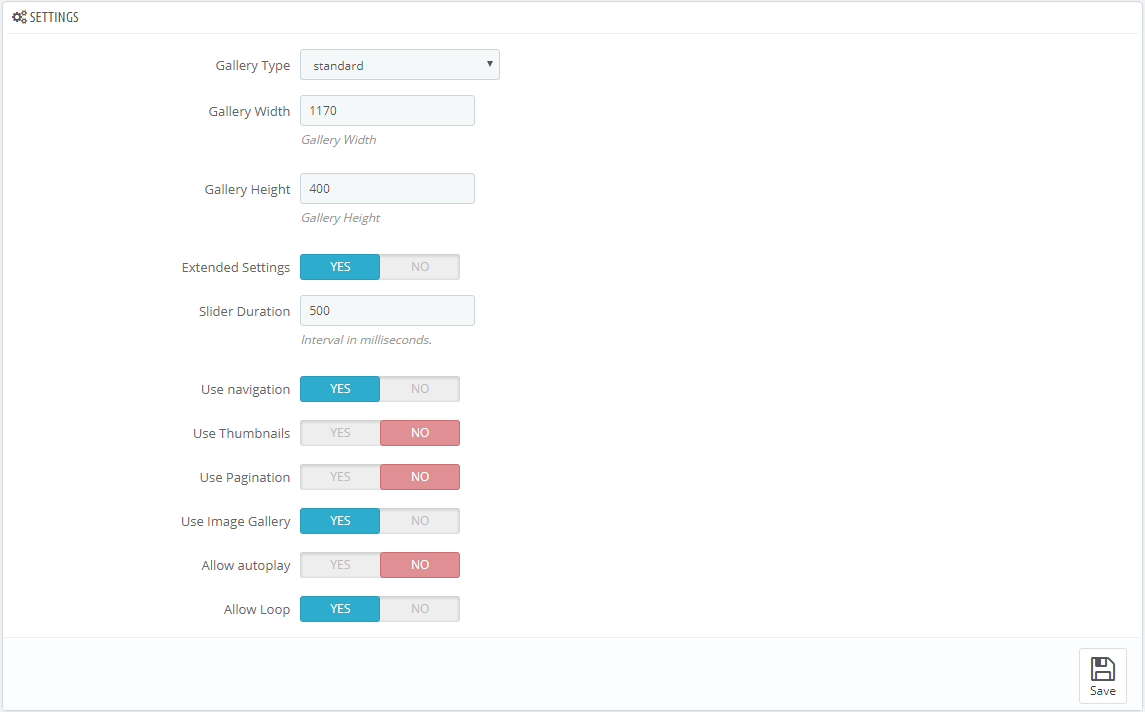
- Gallery Type - active gallery type. Four types of gallery are available (standard, list, grid, full width). You can set up each of them independently.
- Gallery Width - active gallery width.
- Gallery Height - active gallery height.
- Extended Settings - advanced settings; if the option is moved to 'No' position, all the advanced settings will be saved and you can restore them at any time. At the same time, at frontend it will be displayed as by default.
- Slider Duration - the speed of slide changing.
- Use navigation - the display of the Prev/Next buttons for slide switching.
- Use Thumbnails - using thumbnails with additional information about slides as an element for switching the current slide.
- Use Pagination - using pagination as an element for switching the current slide.
- Use Image Gallery - using additional product images inside the slides.
- Allow autoplay - allow automatic slide switching.
- Slider Interval - the time span, after which the slide will switch to another (available only if 'Allow autoplay' is active).
- Allow Loop - allow repeating slides from the beginning after all the slides were shown.
After switching the gallery, all the setup of the previously used gallery is saved.
After disabling/enabling advanced settings, the settings are saved and you can go back to them at any time.
FAQ
- Why the gallery does not display on the frontend?
- I change gallery advanced settings, but I don't see changes on the frontend. What can be done?
TM Related Products
Available in:
Fashion, Electronics, Spare Parts, Furniture
Given module was designed in order to add and display the related products on the product page.
Module installation
This module can be installed/uninstalled as any other PrestaShop module.
Module settings
After module has been installed you can configure it on the module configuration page.
- Display product price.
- Amount of products to display.

You can add or remove related products for the main product in the product settings Catalog -> Products.
- Navigate to TM Related Products;
- In the product search field start input the title of the product, and choose it from the offered variants;
- In order to remove the product from the list click the X before the product;
- Once all the configuration changes have been made click 'Save and Stay' or 'Save' button.
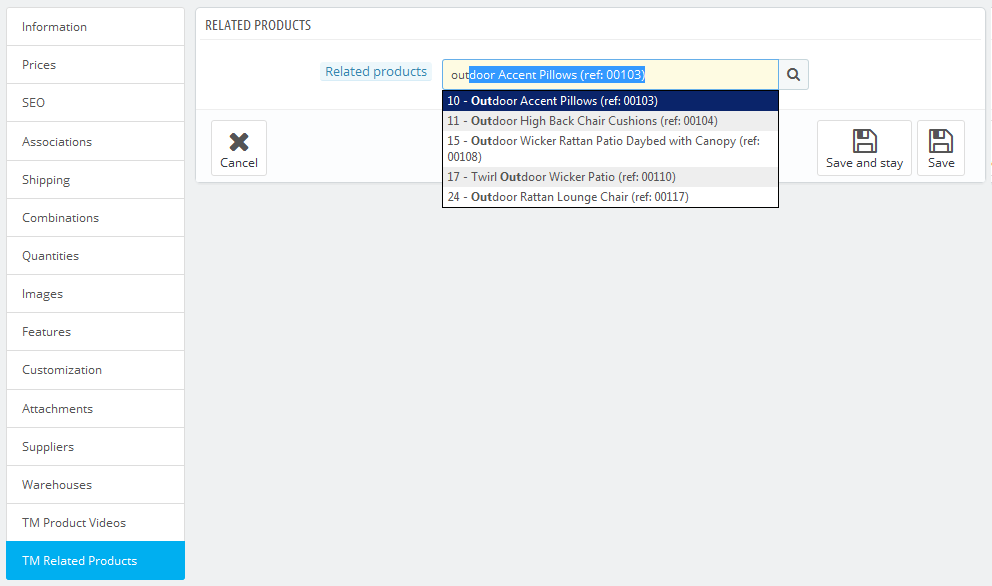
TM Search 1.1.0
Available in:
Fashion, Electronics, Spare Parts, Furniture
This module is an extended search version that allows you to select a specific category for searching within its content. You can also change the category after defining the query. It also provides a possibility to set the additional product information display (description/price/manufacturer, etc.), and define the search results container layout, e.g., you can divide the results into a few sections with the controls (pagination, next/previous/show all). All the module settings are available in main admin panel.
Installation and Deleting
If you have the 1.0.5 version of this module installed in your prestashop engine, you are not suggested to update it with the current one. First you need to remove the old version of the module to run without errors.
The module is installed and deleted like any other Prestashop module.
Module configuration
After module has been installed you can set it up on the module configuration page.
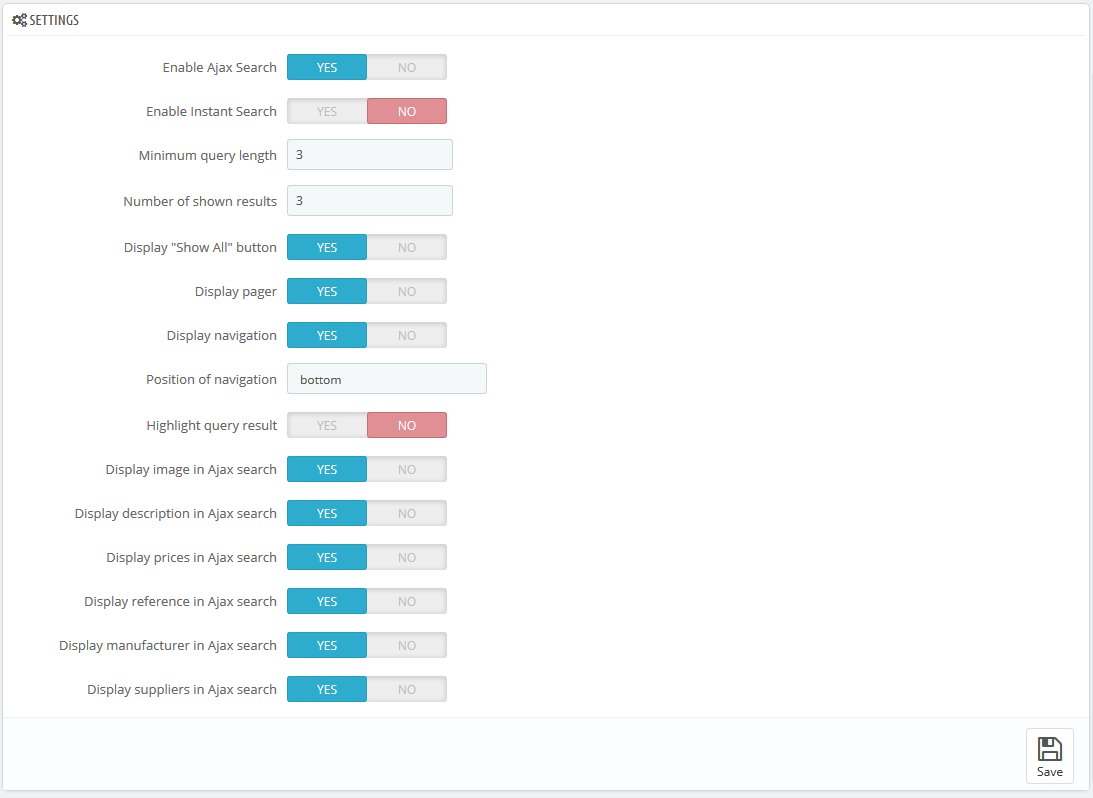
- Enable Ajax Search - enables live search in a dropdown.
- Enable Instant Search - enables instant search.
- Minimum query length - number of symbols to start the result display.
- Number of shown results - number of products that shows up in the results section (number of products per page for the "pager" or "navigation" mode).
- Display "Show All" button - displays the 'Show all' button below the results section, the click on it displays all found results.
- Display pager - divides results into pages (depends on the 'Number of shown results' field value) and displays links to them.
- Display navigation - shows the Previous/Next buttons.
- Position of navigation - hook(s), to show the navigation (top/both/bottom options are available).
- Highlight query result - highlights the text that matches search query.
- Display image in Ajax search - shows product images in the results section.
- Display description in Ajax search - shows product description in the results section.
- Display prices in Ajax search - shows product price in the results section.
- Display reference in Ajax search - shows product reference in the results section.
- Display manufacturer in Ajax search - shows product manufacturer in the results section.
- Display suppliers in Ajax search - shows product suppliers in the results section.
Some parameters might differ depending on the combination used.
TM Social Feeds
Available in:
Fashion, Electronics, Furniture, One Product
This module loads the social networks feeds on your website. It enables the site visitors to be aware of the latest news and posts shared on the social networks.
Installation and Deleting
The module is installed and deleted like any other Prestashop module.
Module configuration
After installation you can change its settings on the module configuration page.
In the upper form you should add global settings for each social network. Different social networks have different settings.
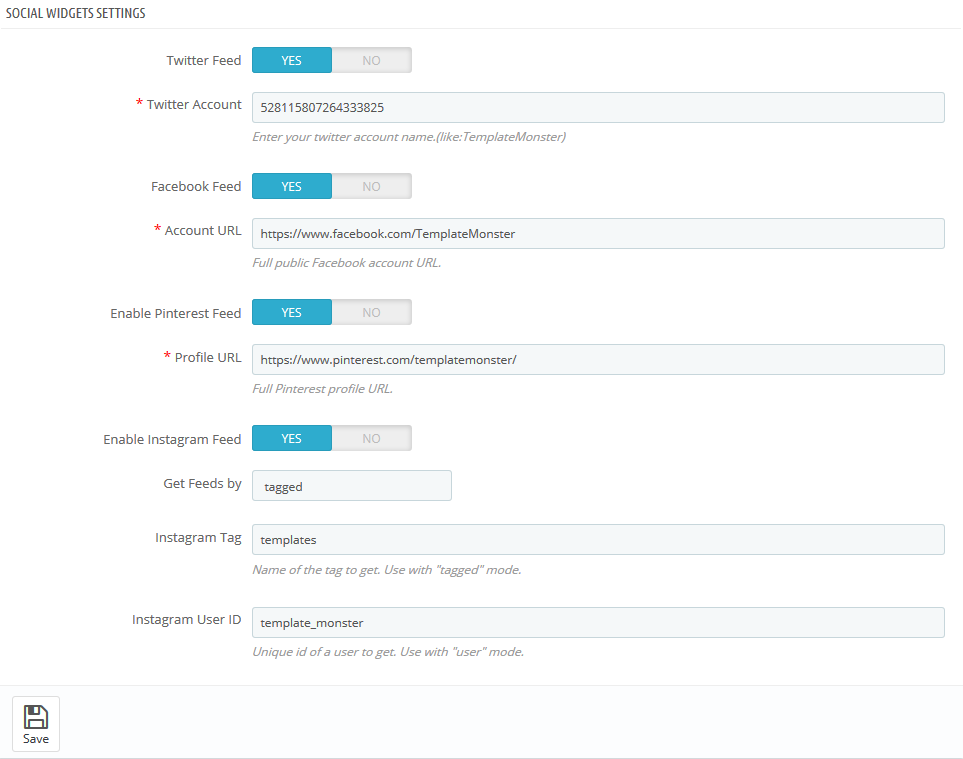
It is enough to add a Widget ID which can be taken from your Twitter account.
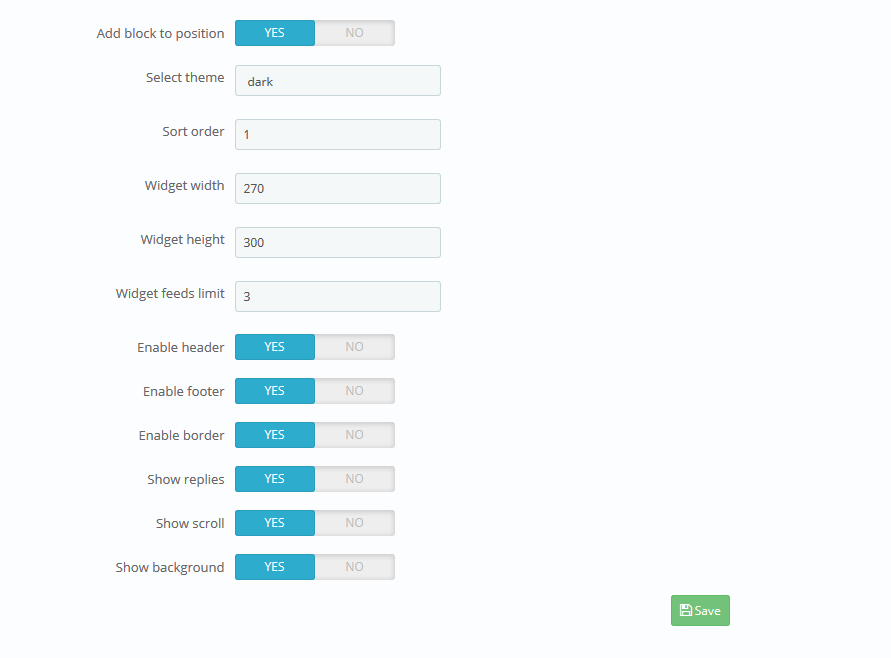
-
- Add block to position
- display block in specific position.
-
- Select theme
- color scheme of the block for this position.
-
- Sort order
- sort order (order number of the block in this position).
-
- Widget width
- block width in this position.
-
- Widget height
- block height in this position.
-
- Widget feeds limit
- number of feeds in the block.
-
- Enable header
- show block title.
-
- Enable footer
- show footer of the block.
-
- Enable border
- show border of the block.
-
- Show replies
- display replies to the posts.
-
- Show scroll
- show block scroll.
-
- Show background
- add block background or leave it transparent.
Paste the full path to the Facebook page which feeds will be loaded. The page should be public.
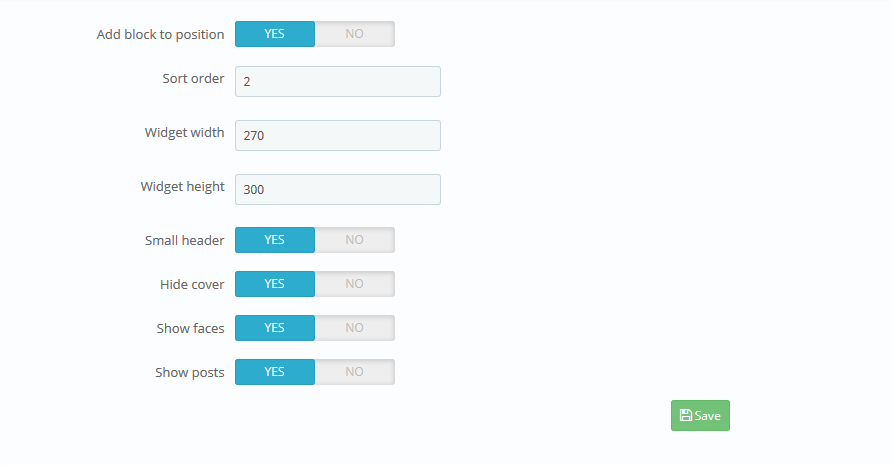
-
- Add block to position
- display block in specific position.
-
- Sort order
- sort order (order number of the block in this position).
-
- Widget width
- block width in this position.
-
- Widget height
- block height in this position.
-
- Small header
- use the small header instead.
-
- Hide cover
- hide cover photo in the header.
-
- Show faces
- show photos of users who liked the page.
-
- Show posts
- show posts from the page.
For Pinterest paste the full path to the page which feeds will be loaded.
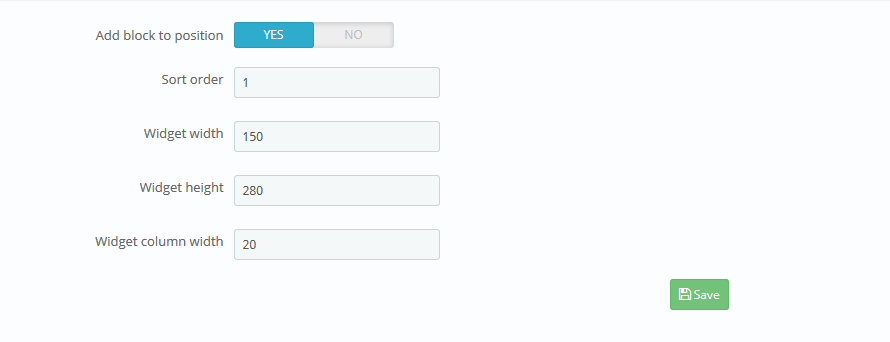
-
- Add block to position
- display block in specific position.
-
- Sort order
- sort order (order number of the block in this position).
-
- Widget width
- block width in this position.
-
- Widget height
- block height in this position.
-
- Widget column width
- width of the block column
Social Widgets Settings

Selection type (Get Feeds by): you can set whether the images are loaded from specific user or by tag.
Tag by which images are loaded.
Name of the user whose images will be loaded.
Instagram Widget Settings
In the second part of the module configuration page you can add the required module to the position you want. There are 4 positions. You can add the block settings to each position. The only global setting is the data of social networks which feeds will be loaded.

-
- Add block to position
- display block in specific position.
-
- Widget feeds limit
- number of feeds displayed in the block.
The module supports multi-stores.
